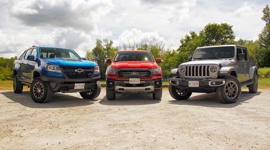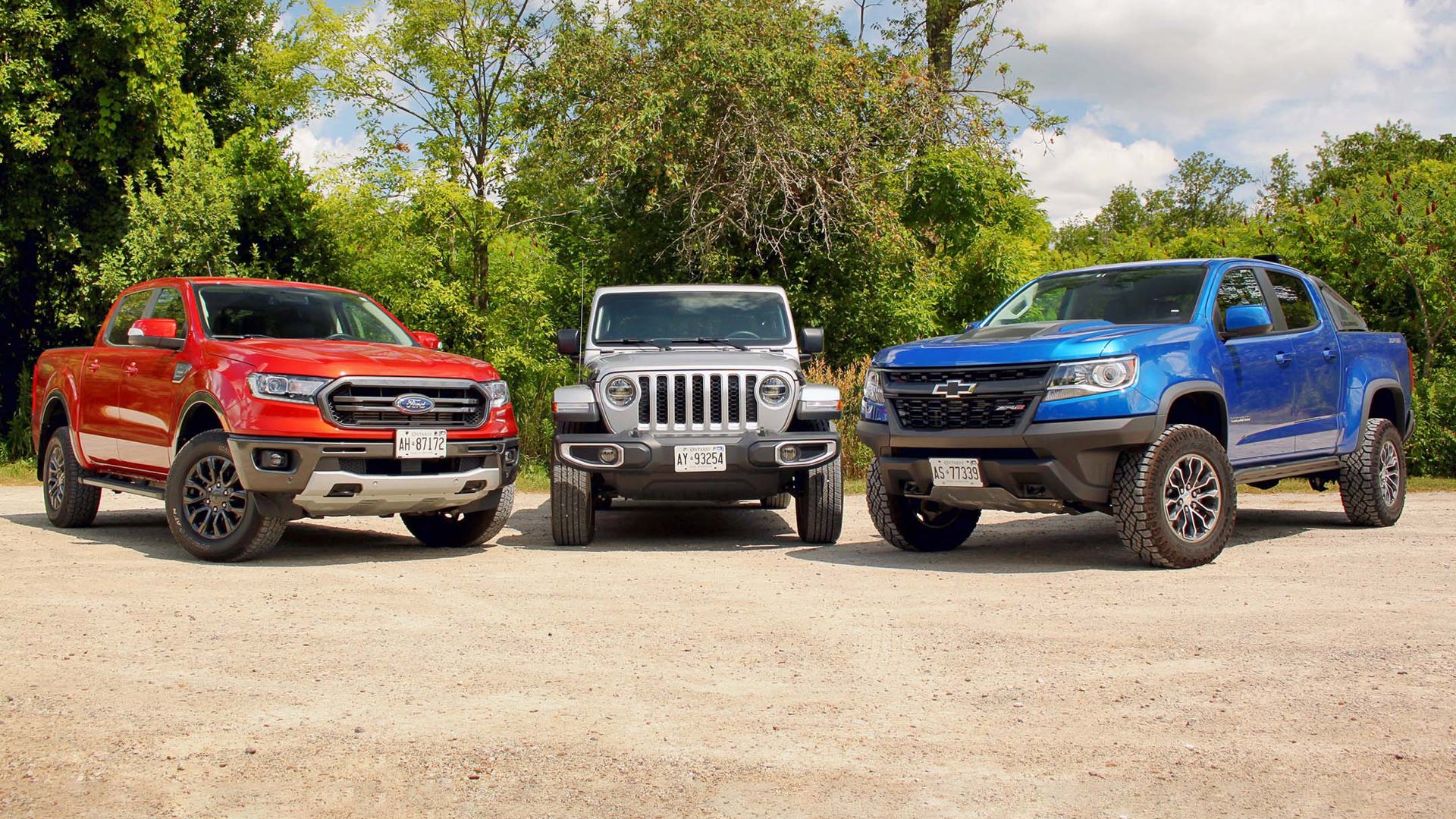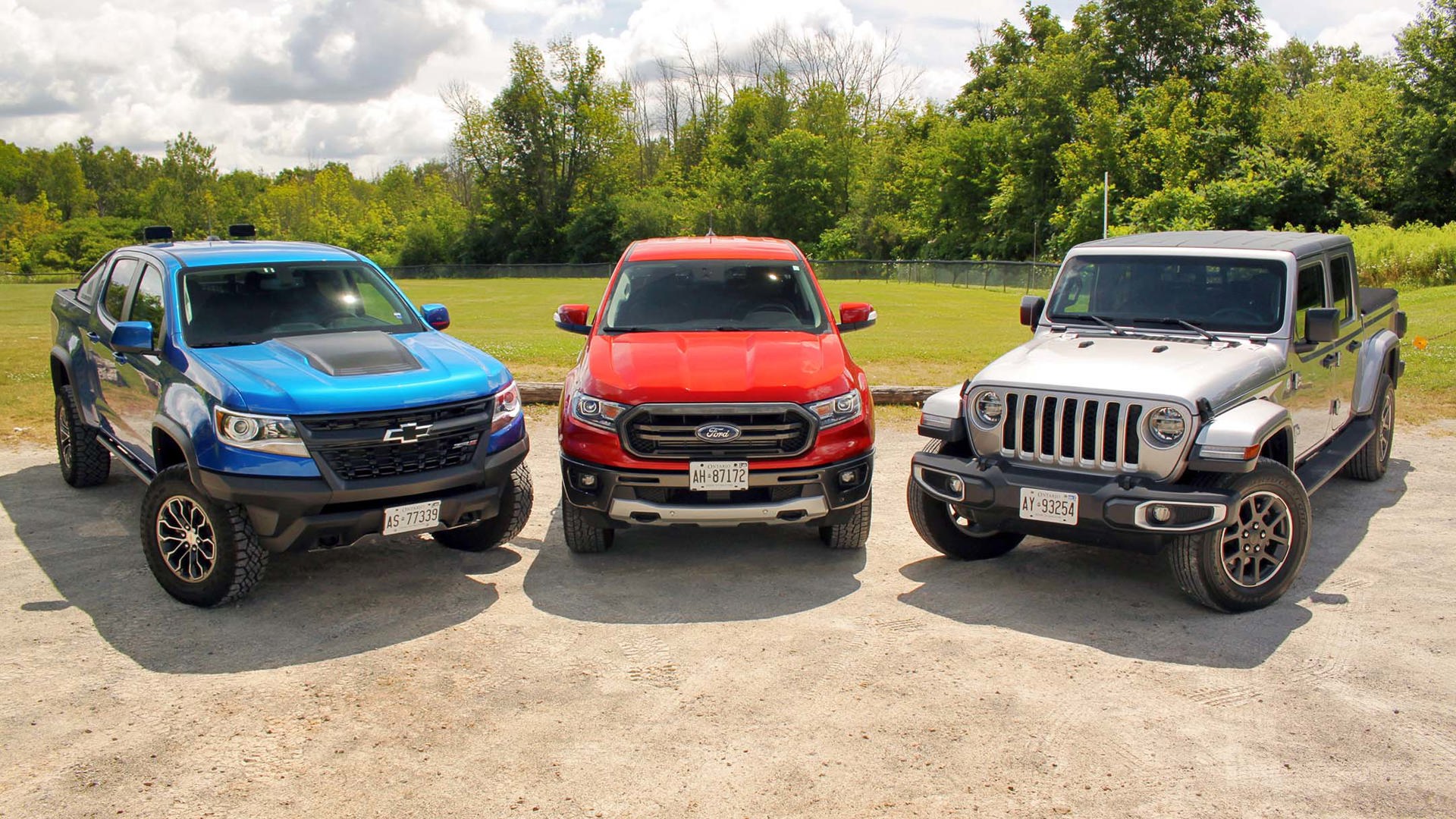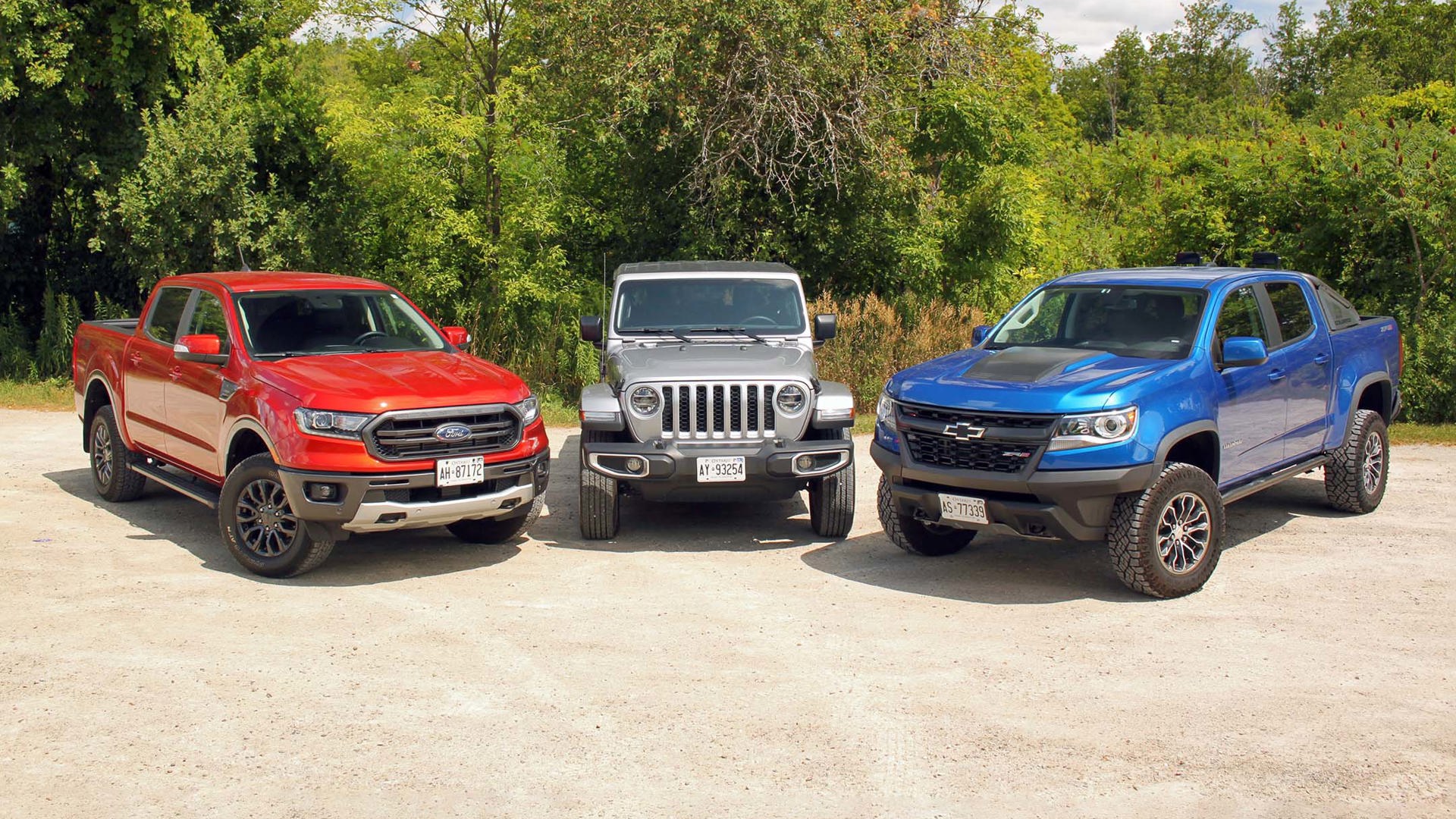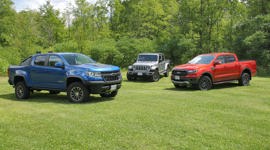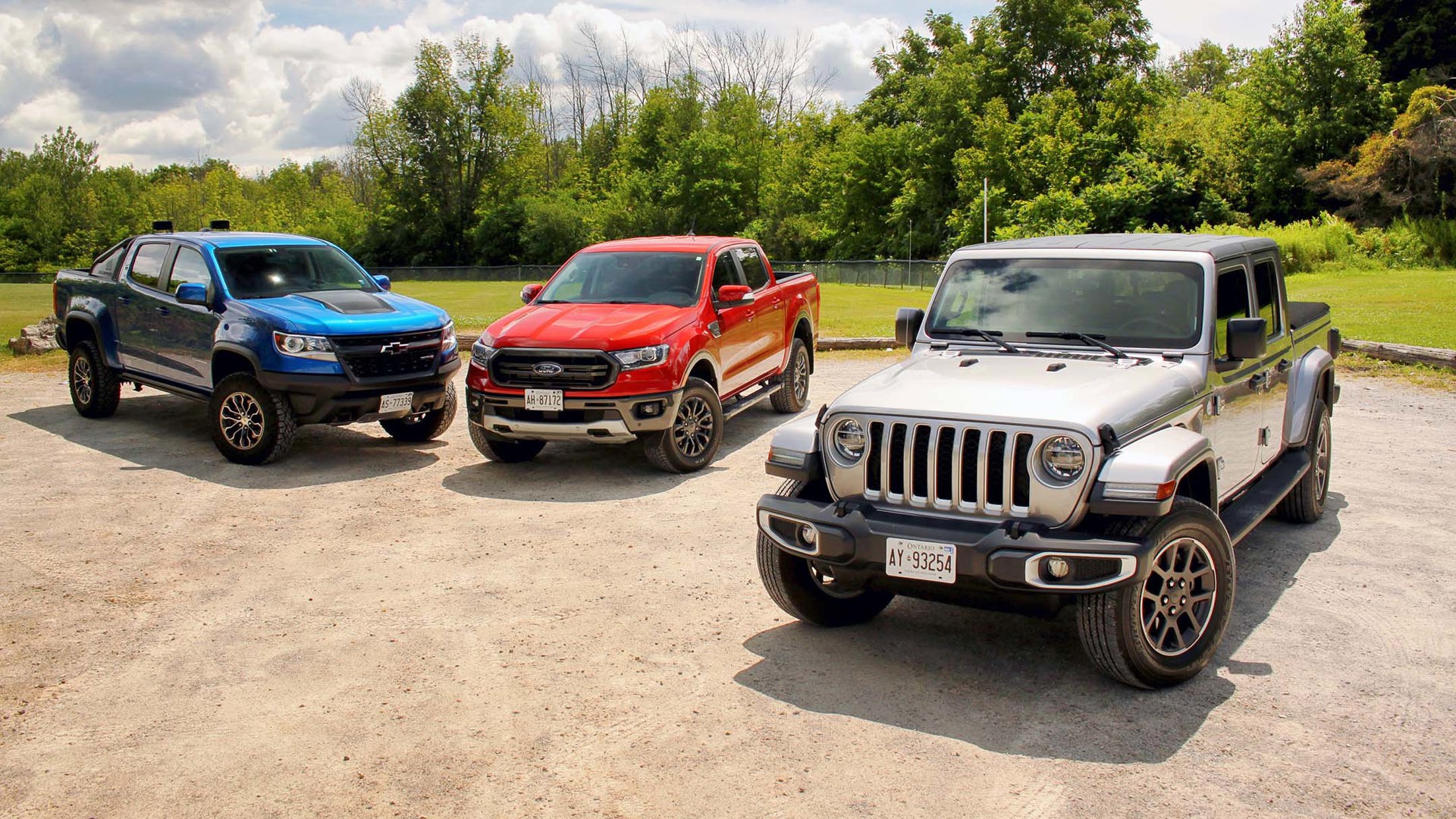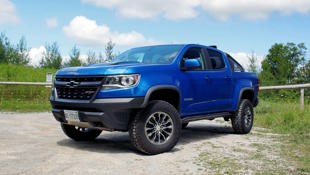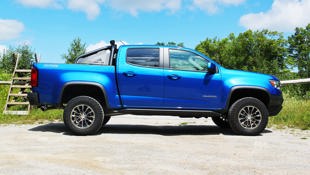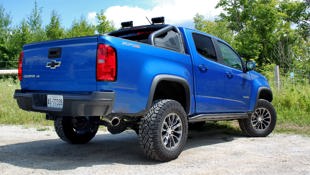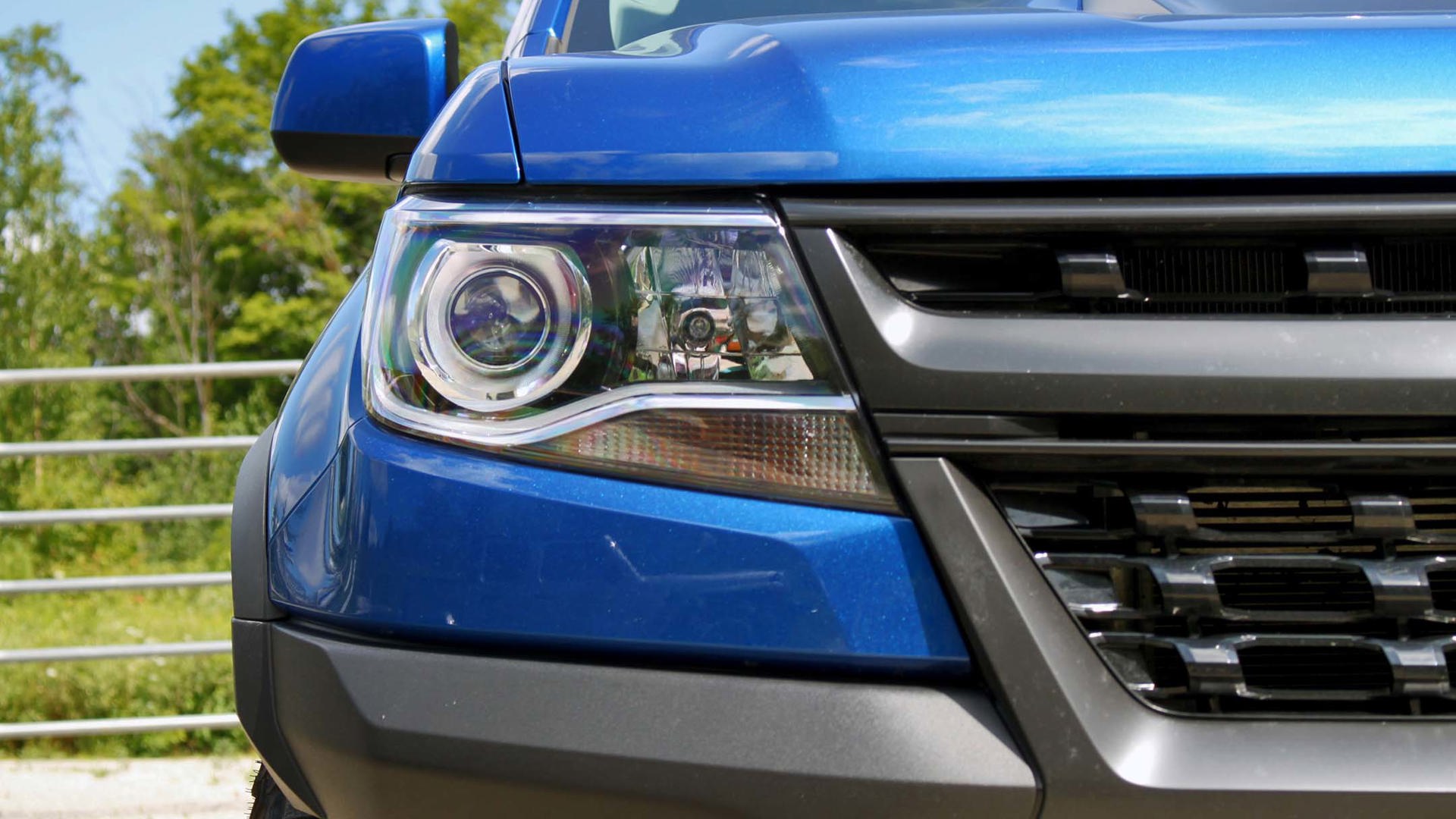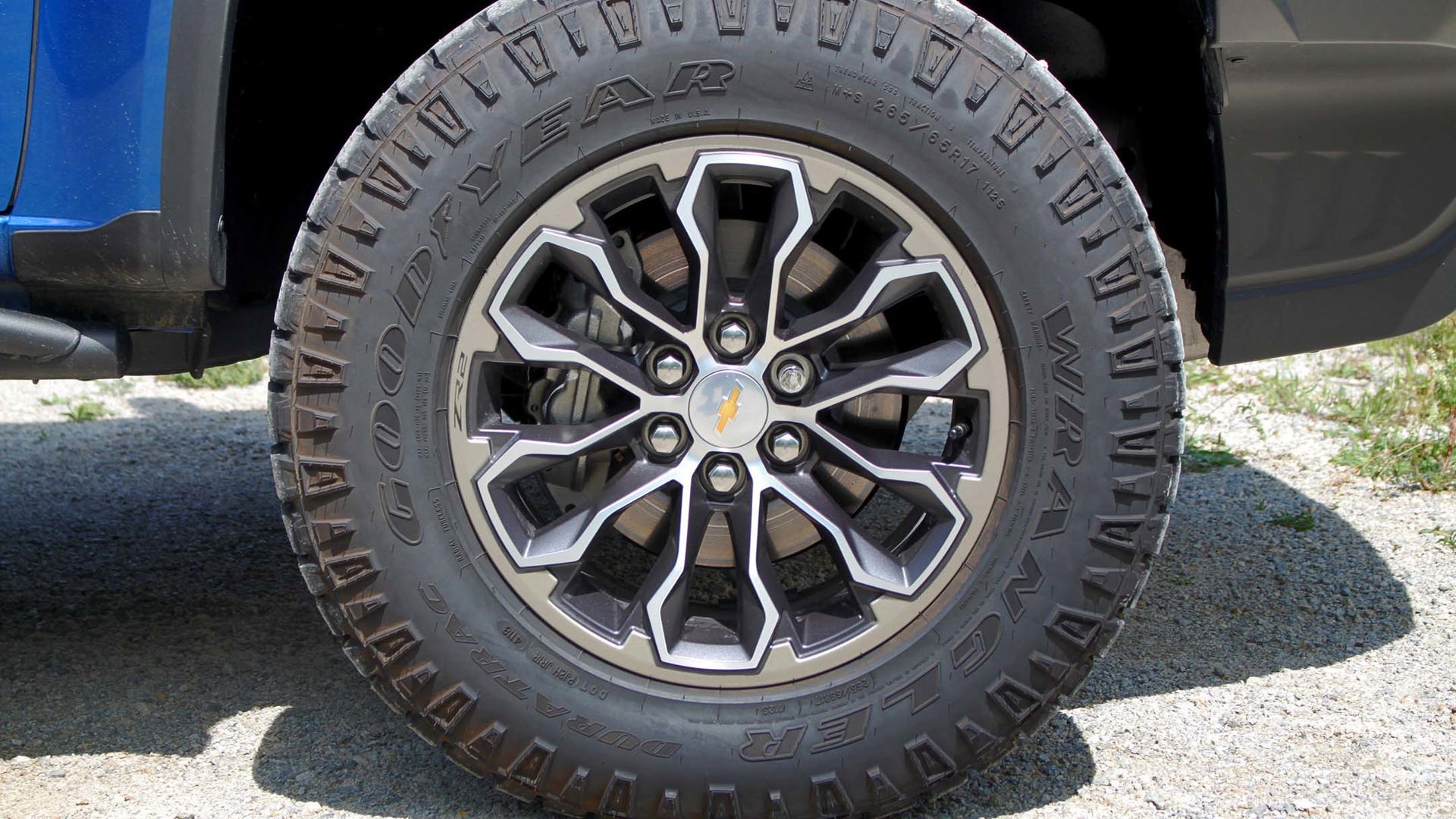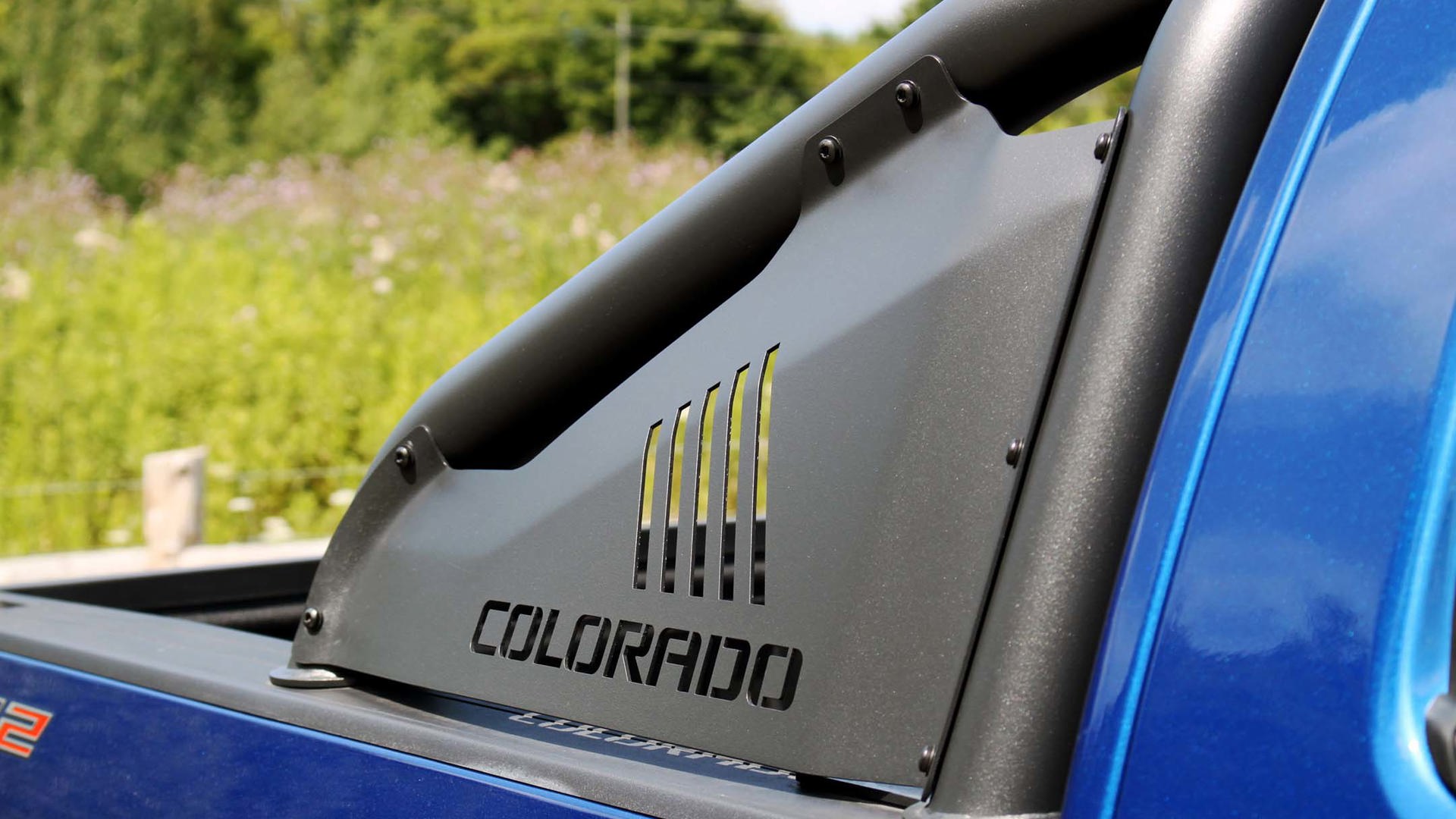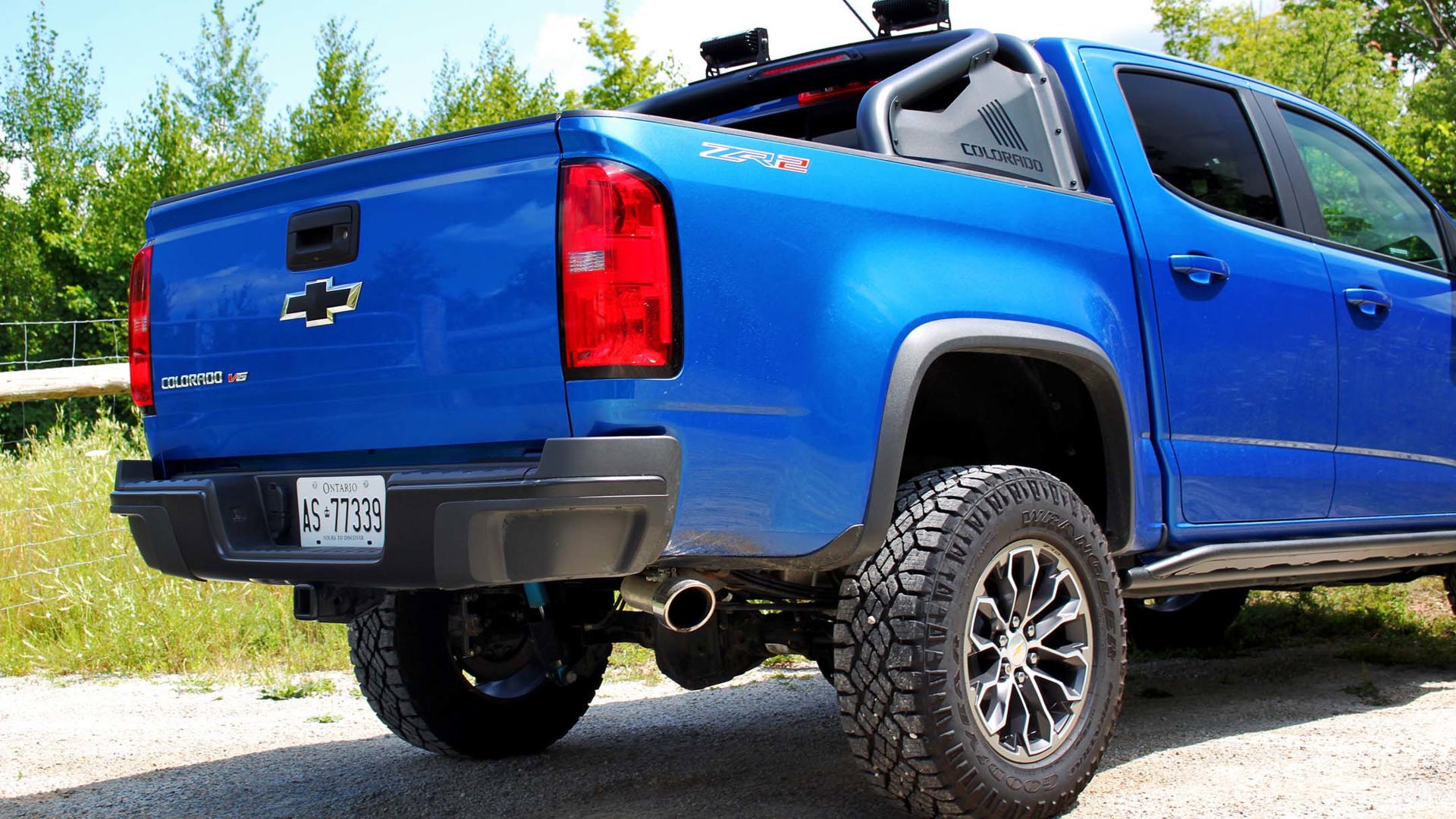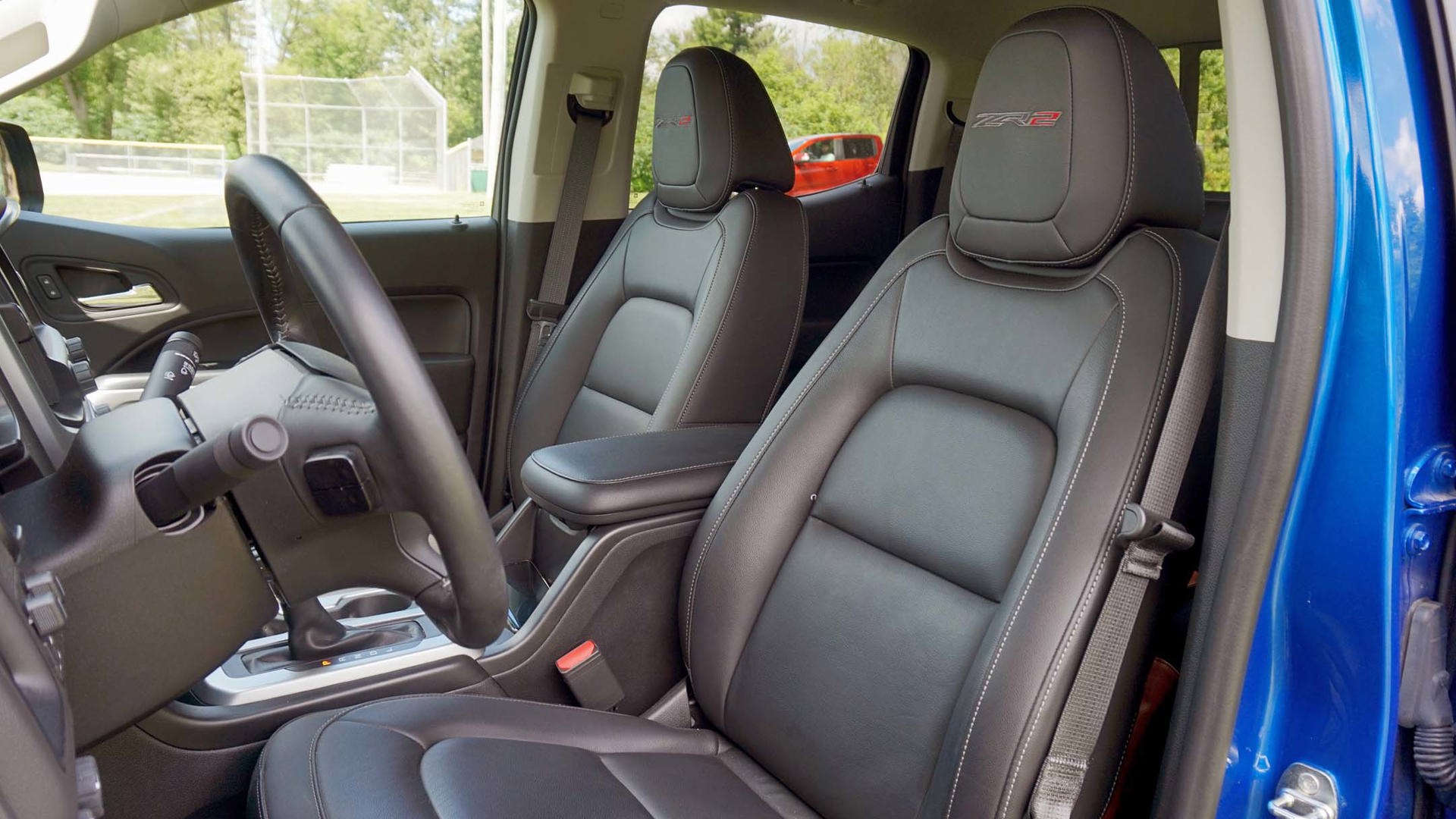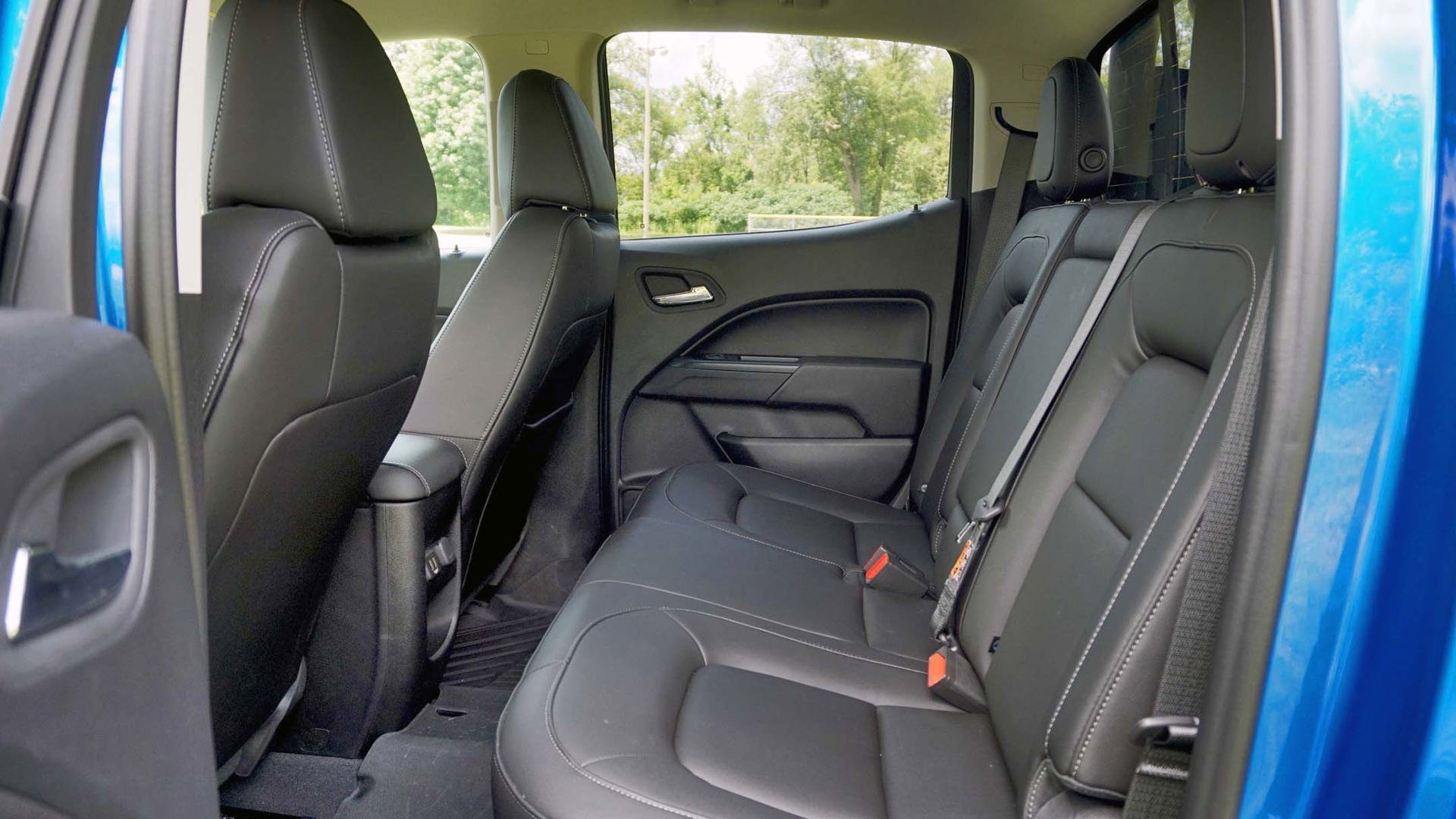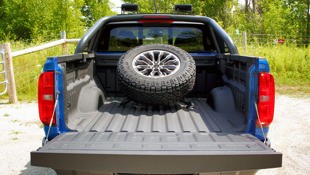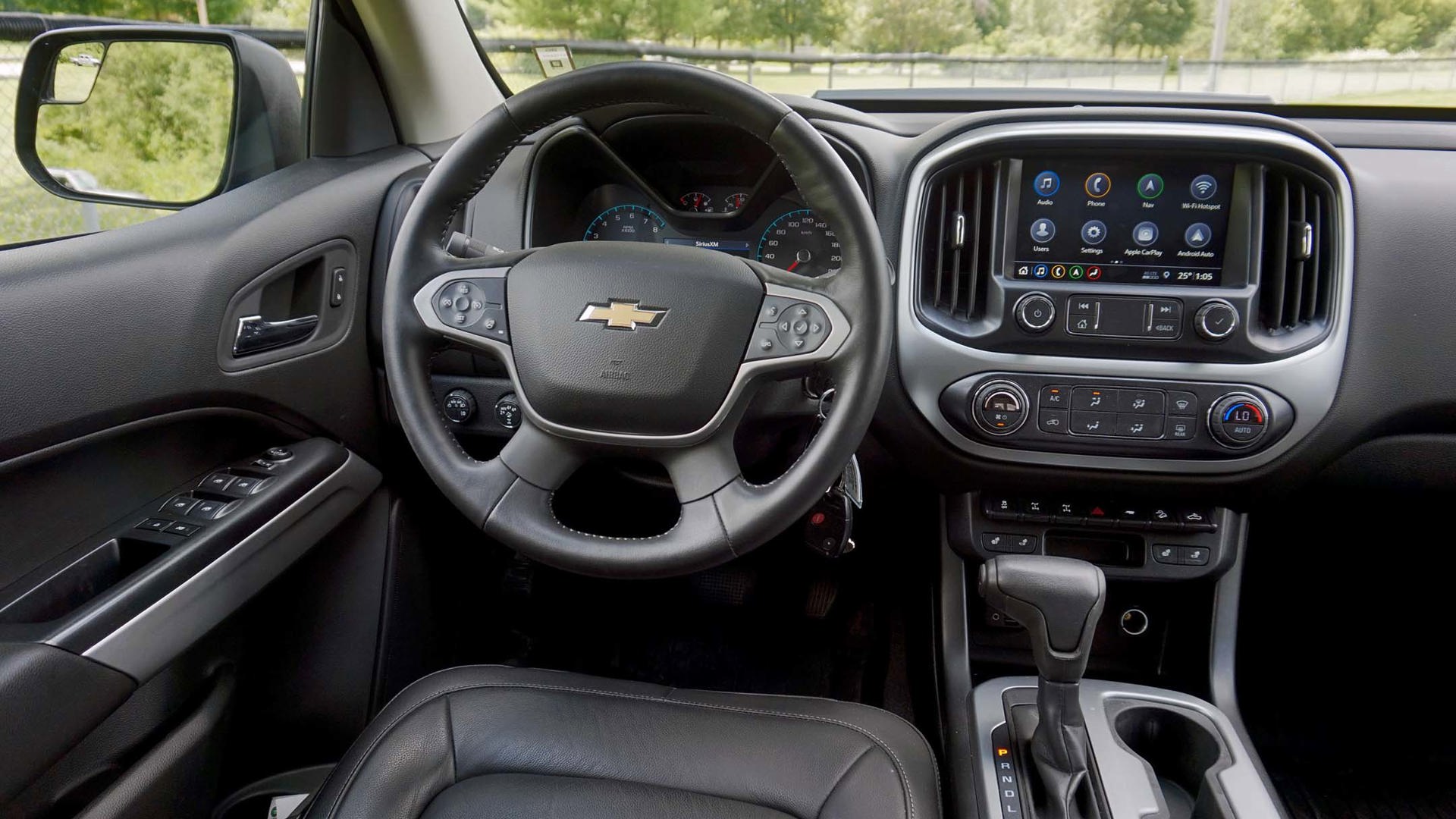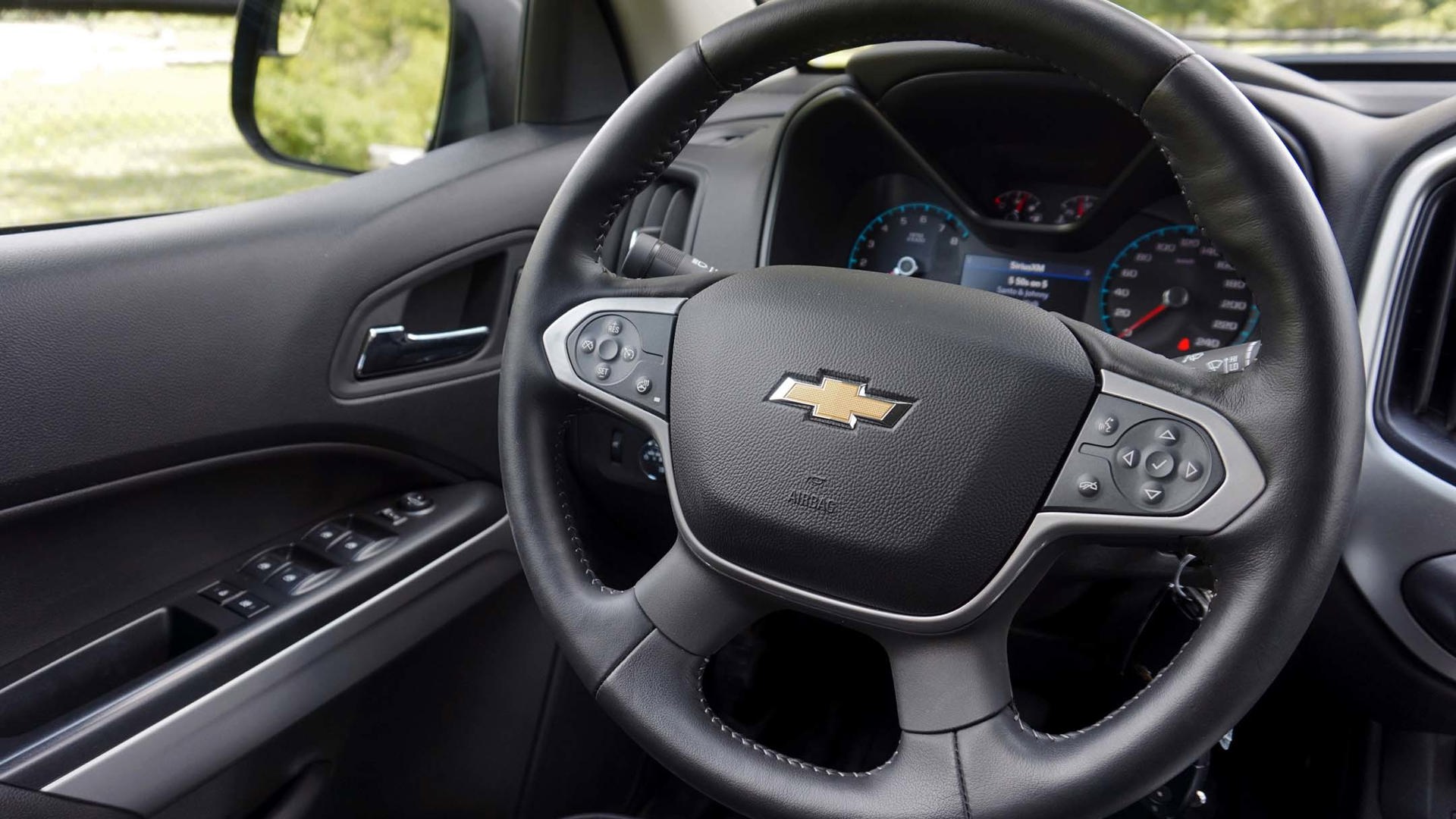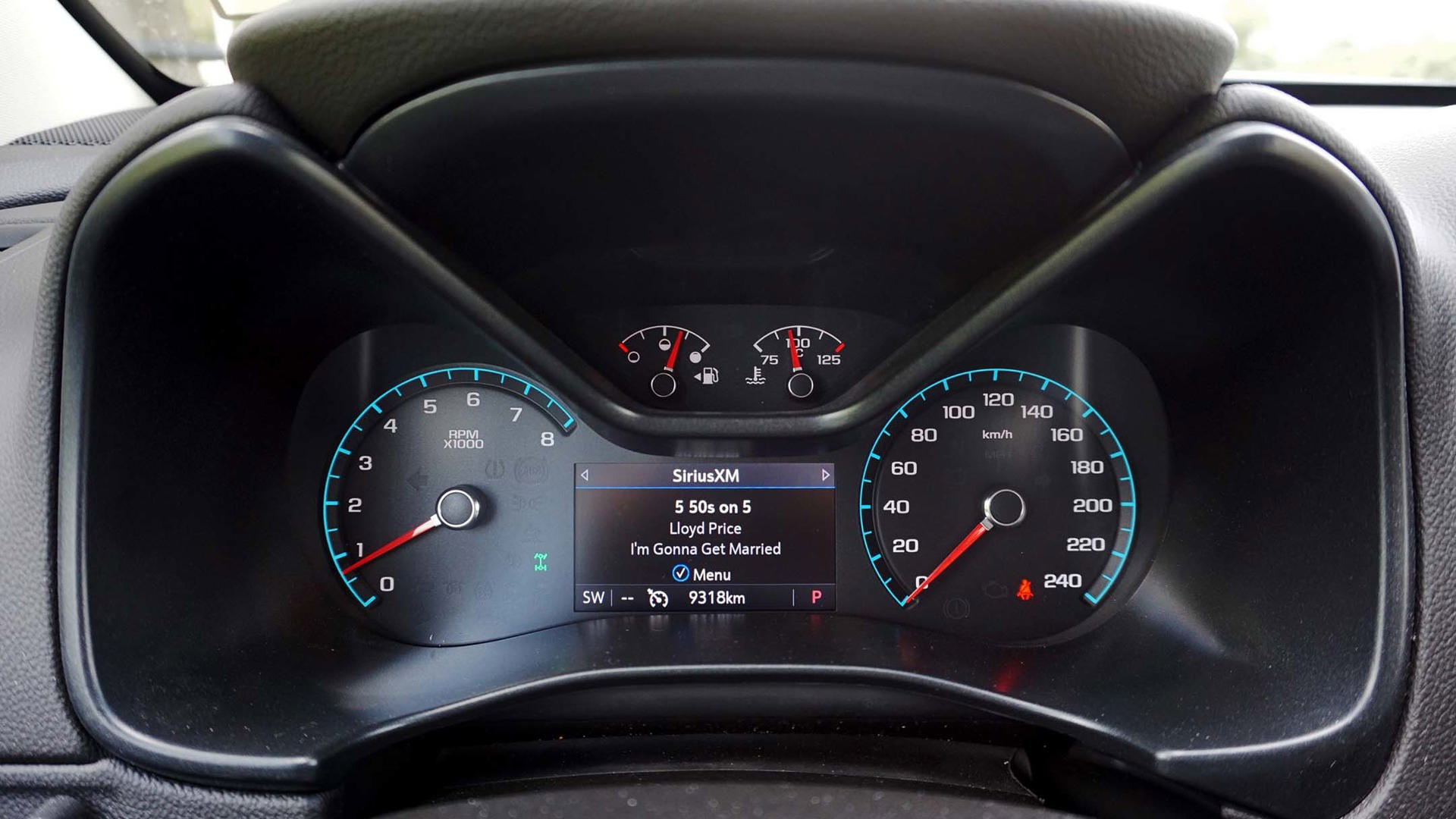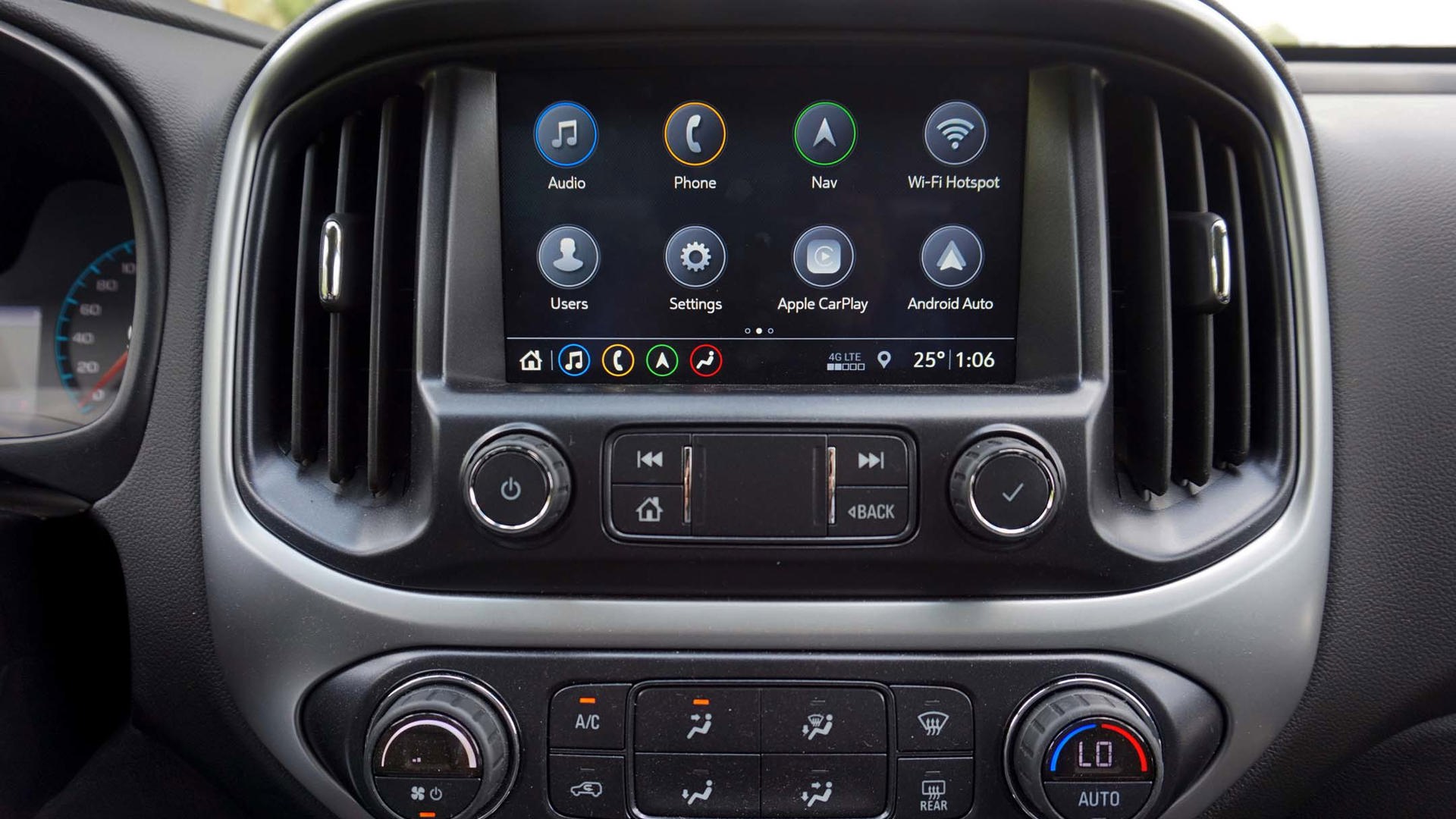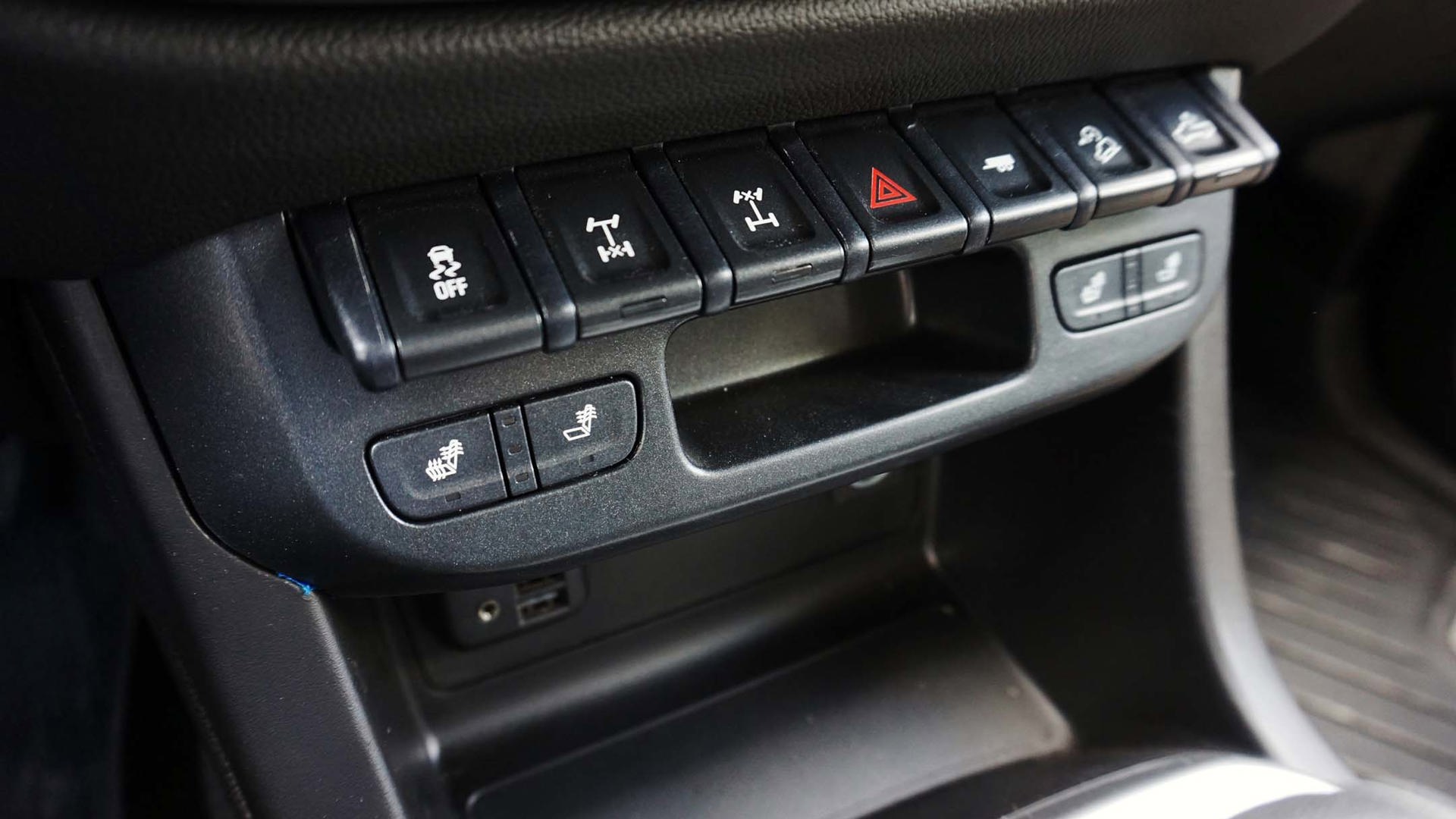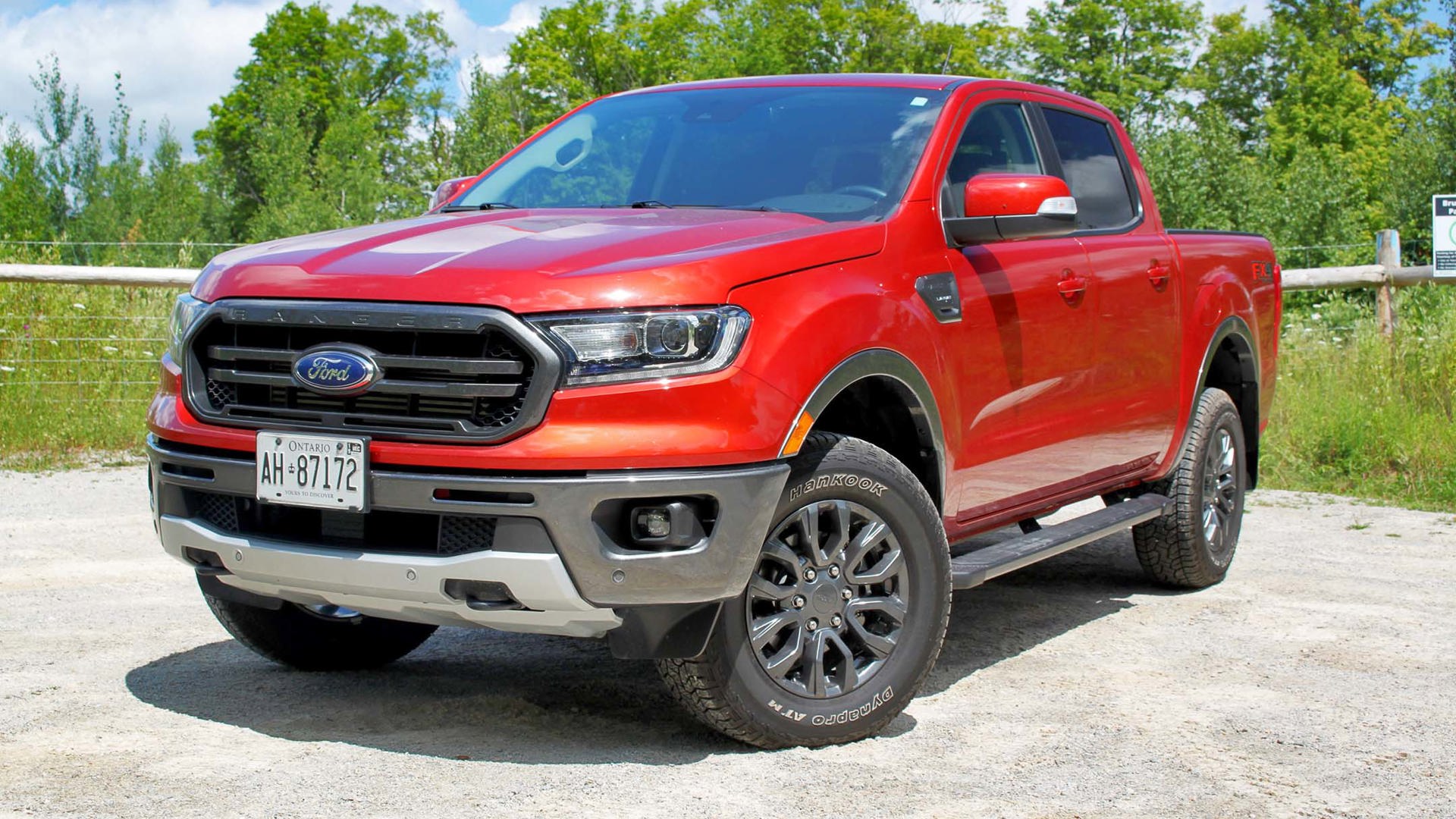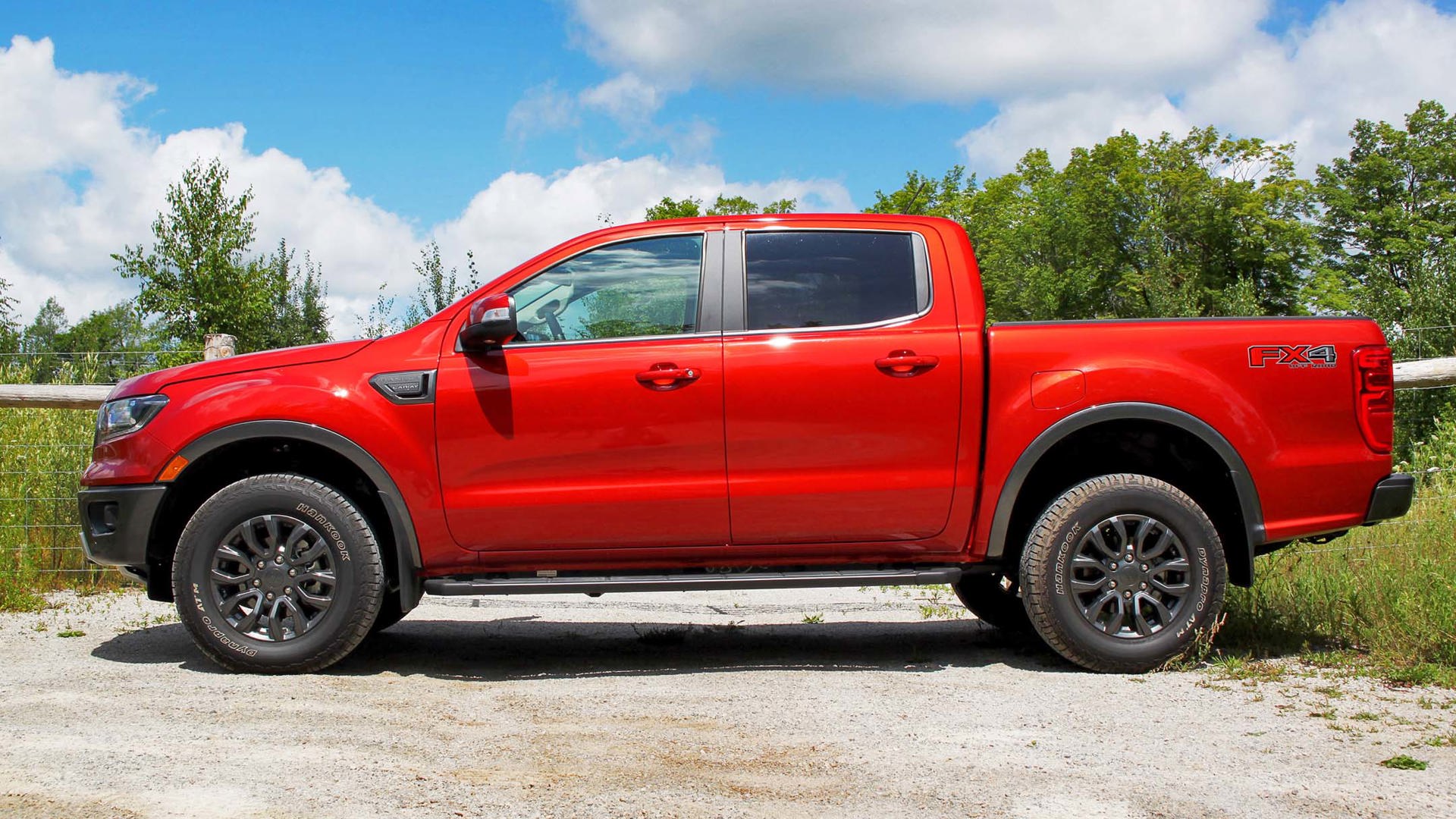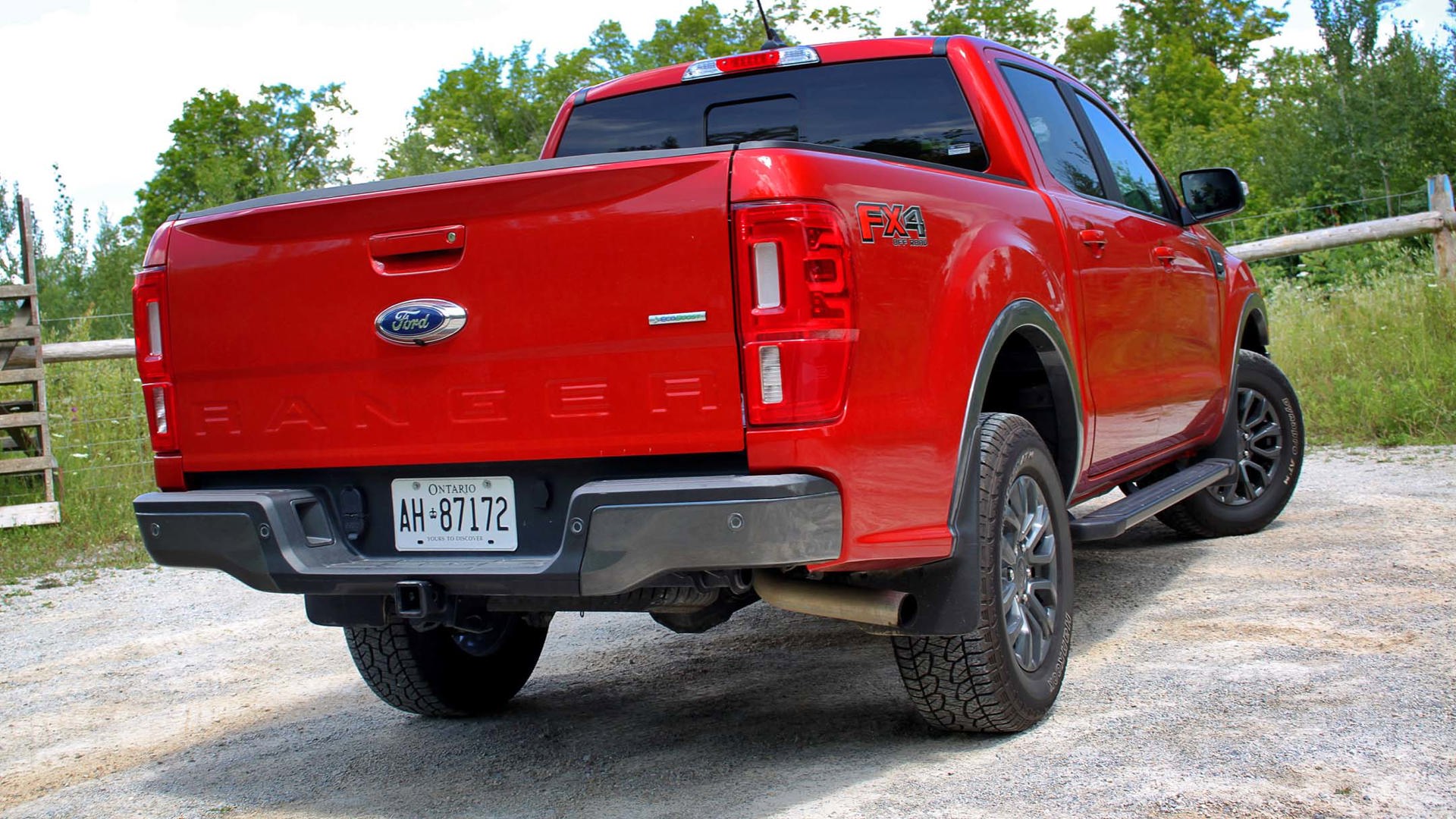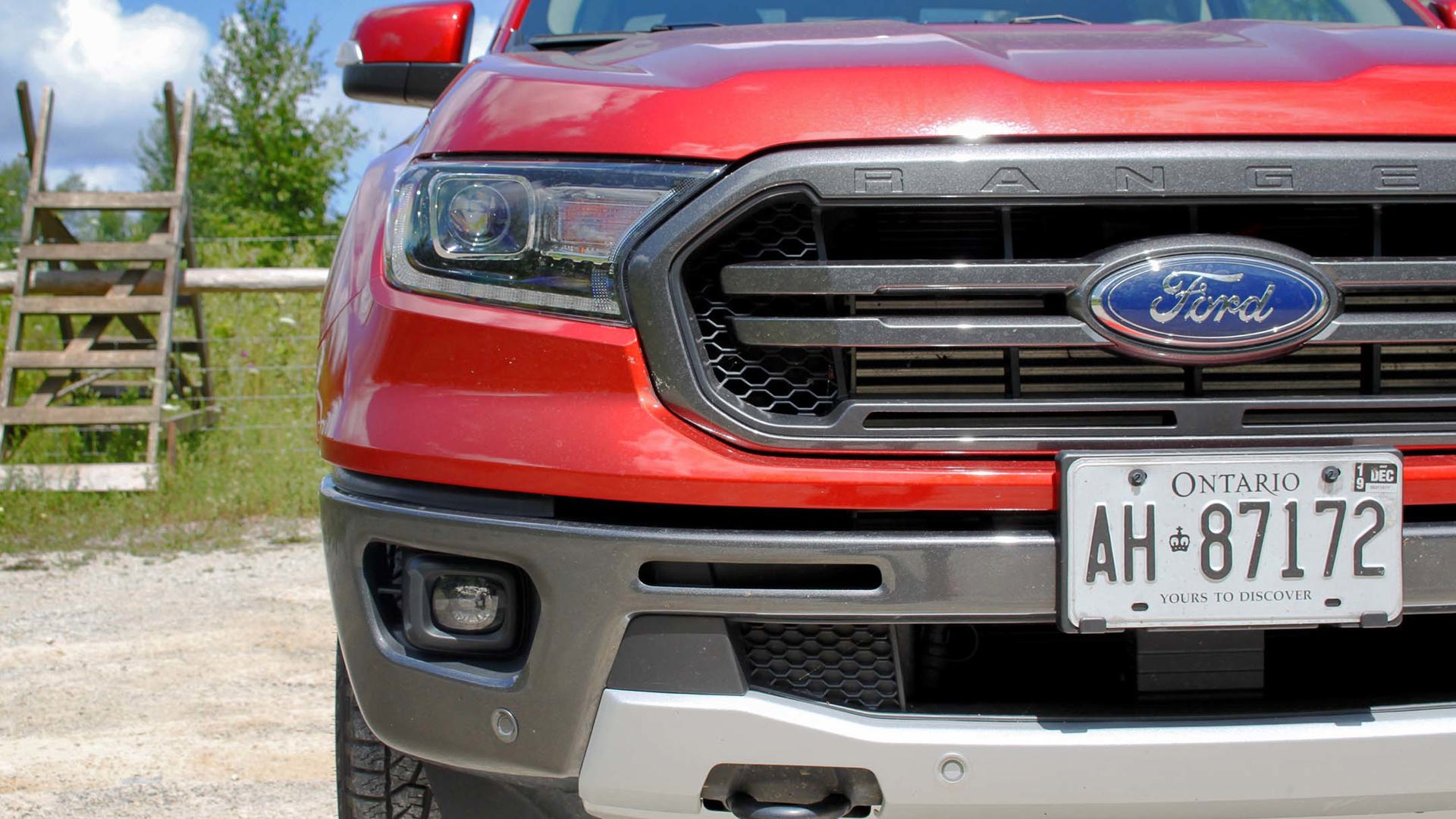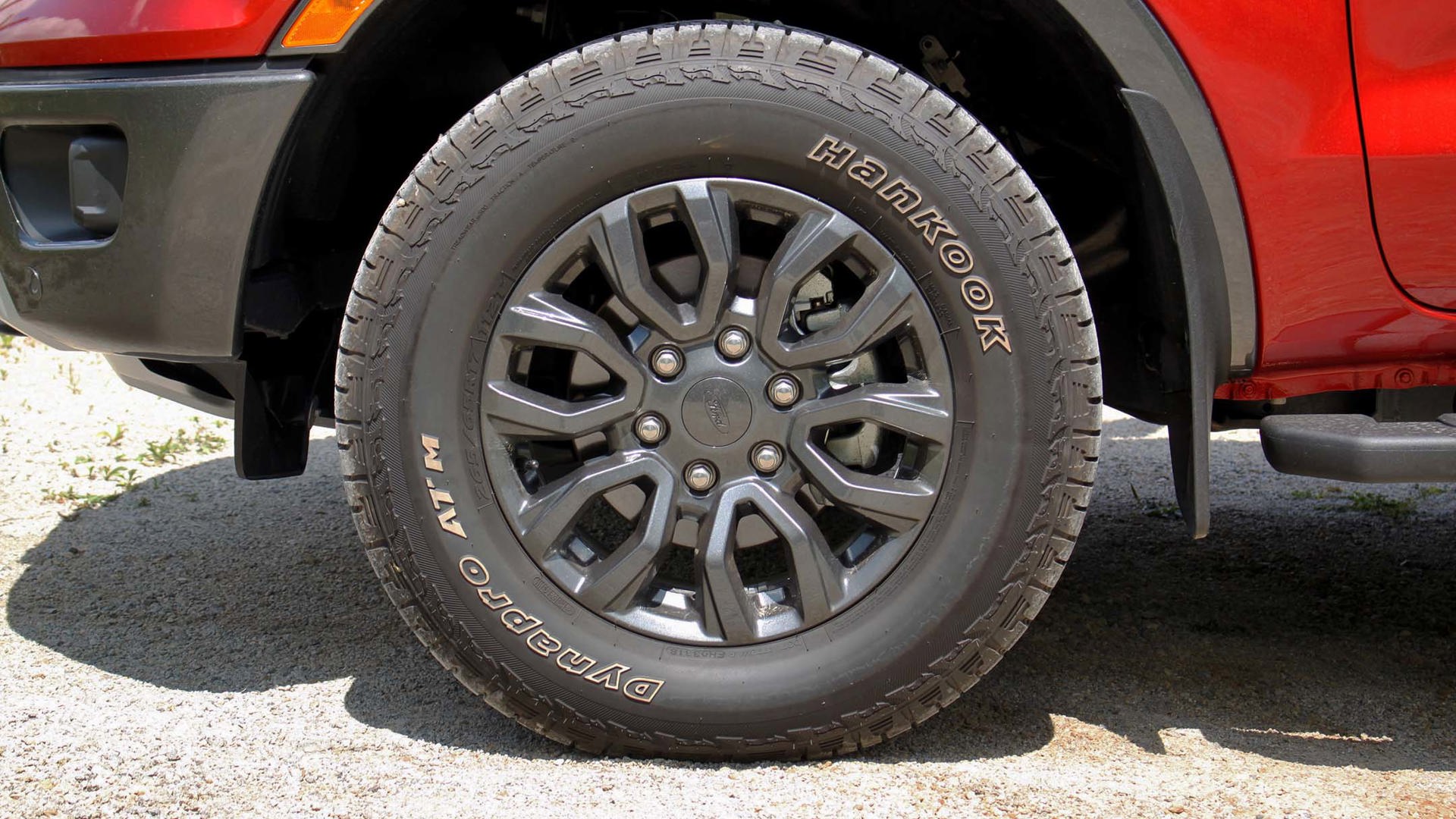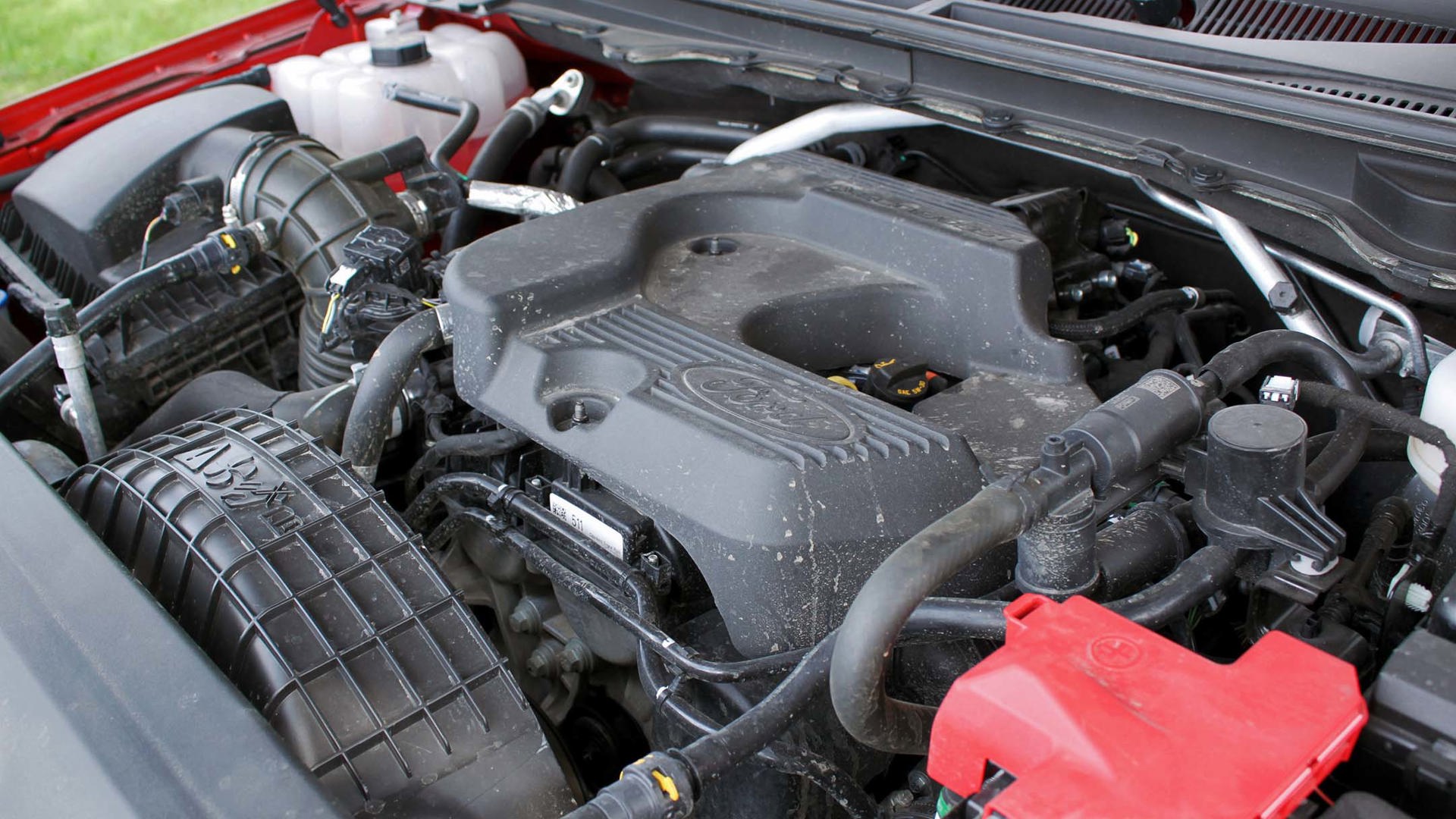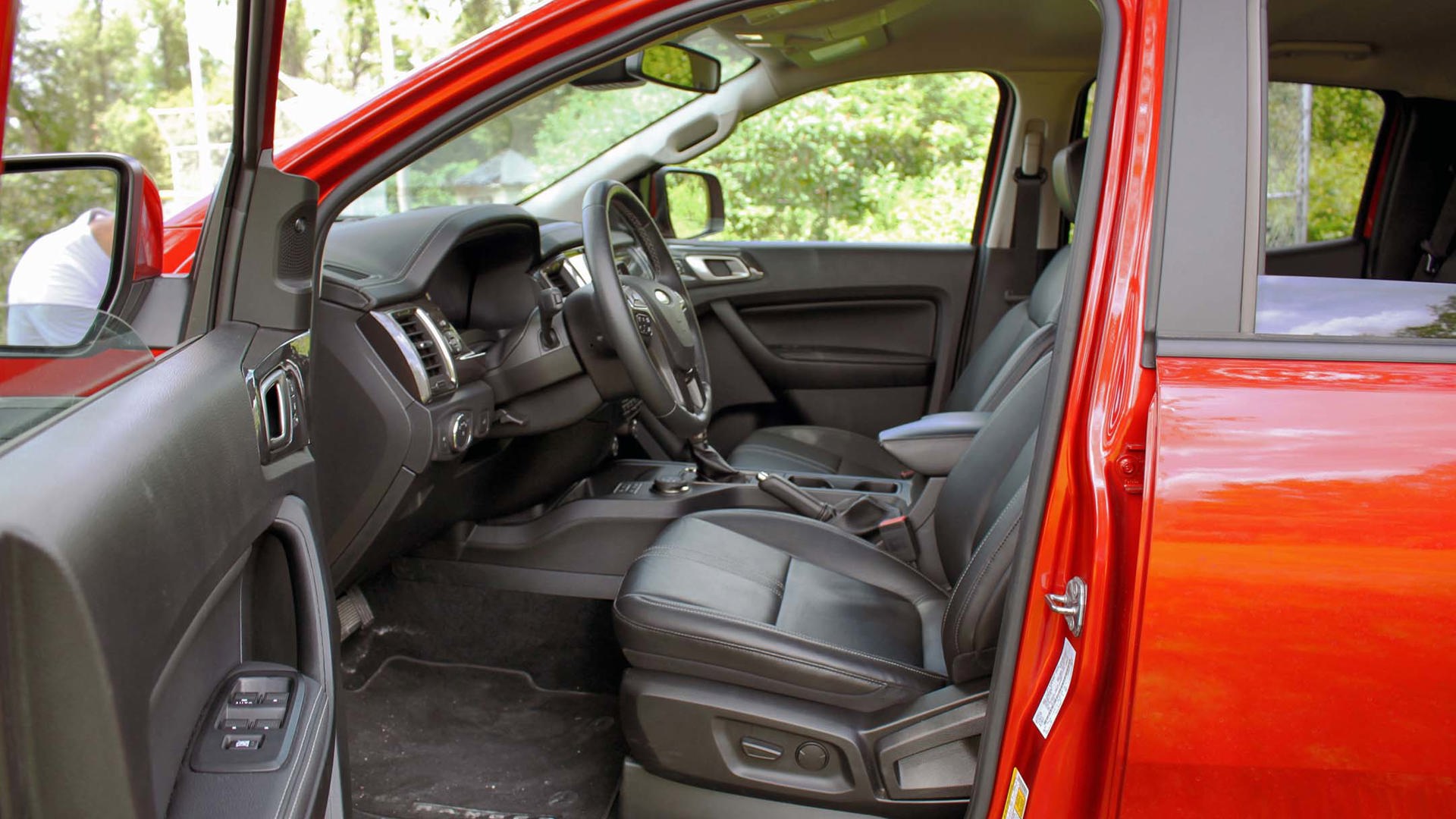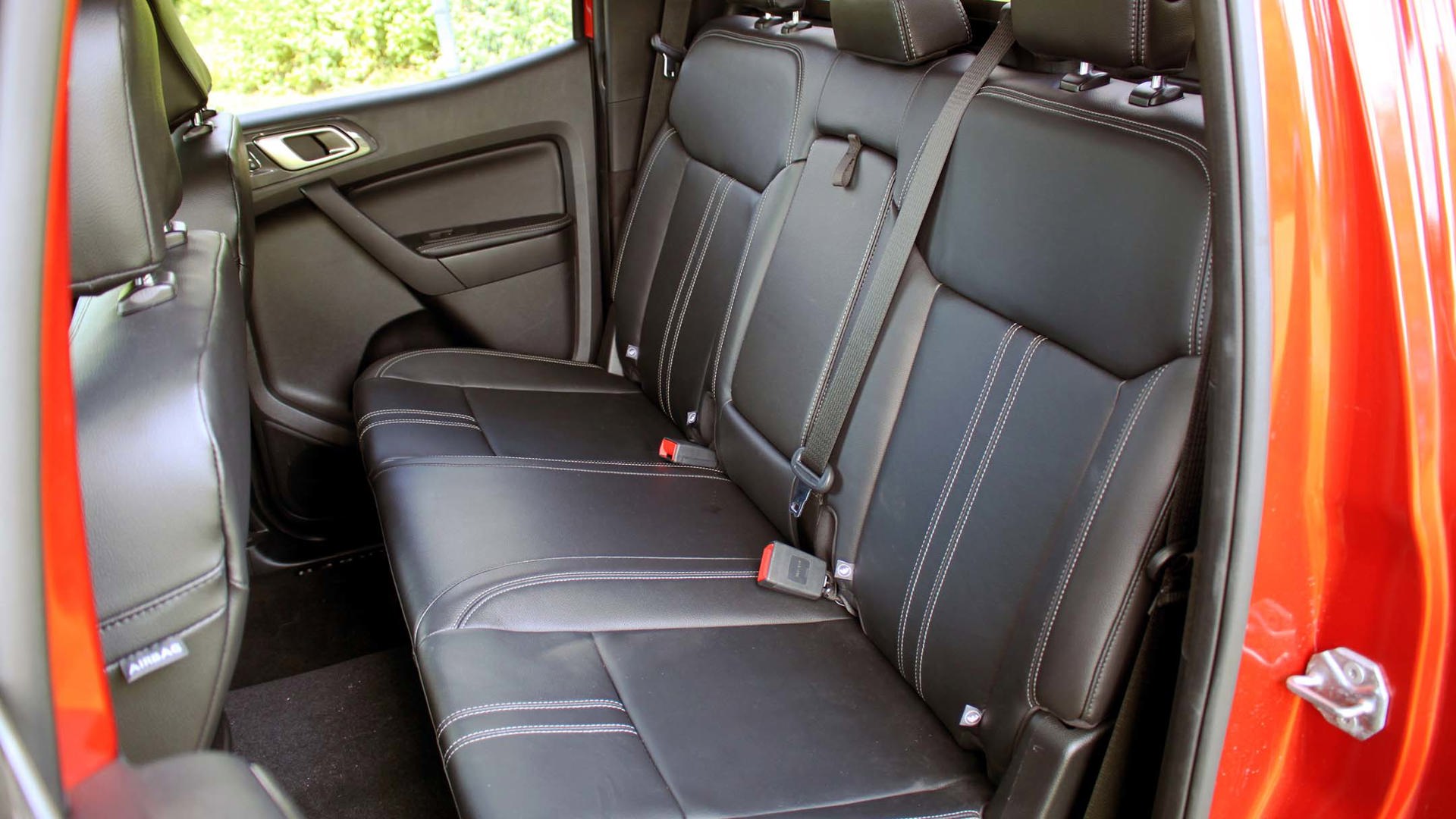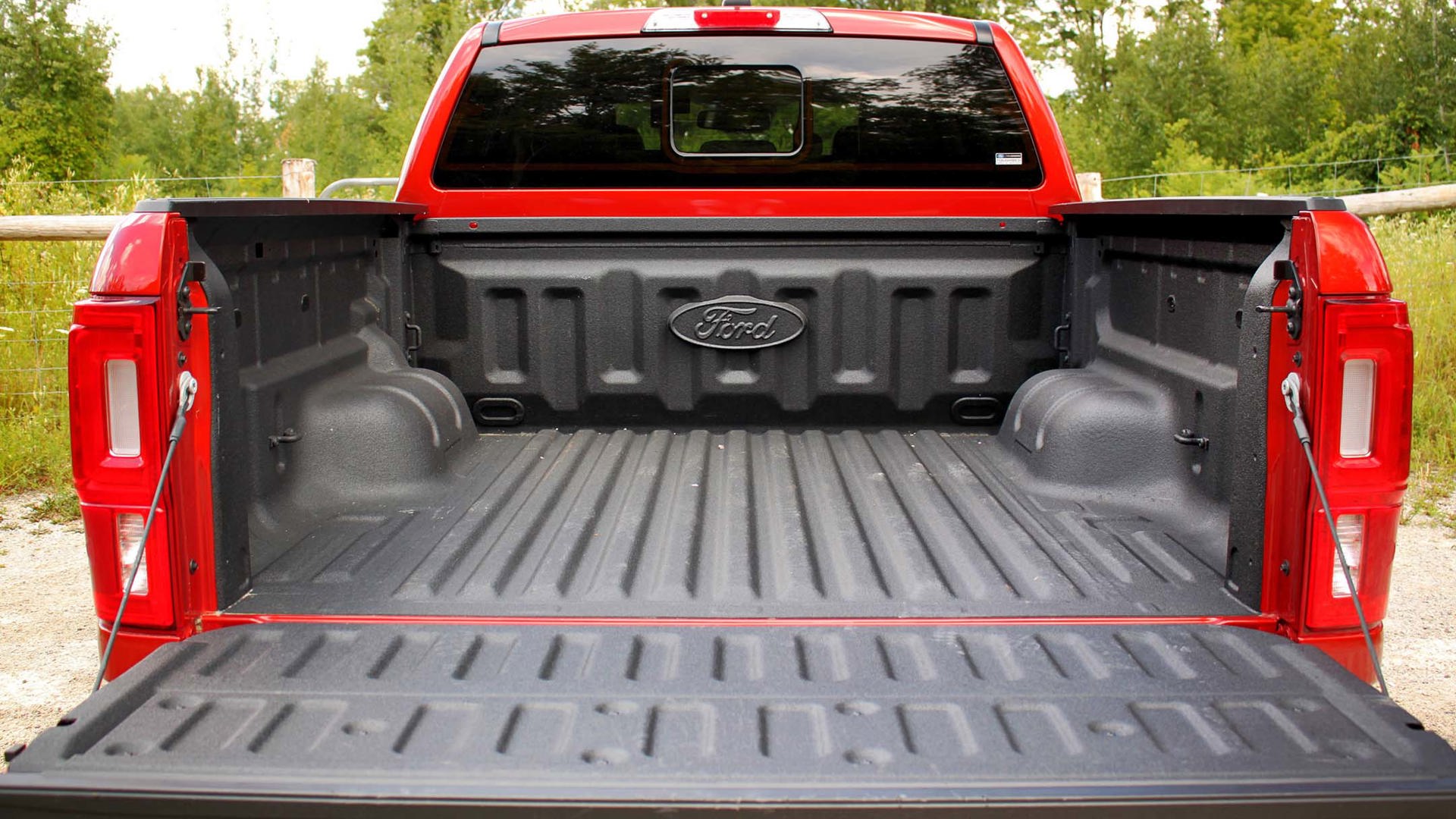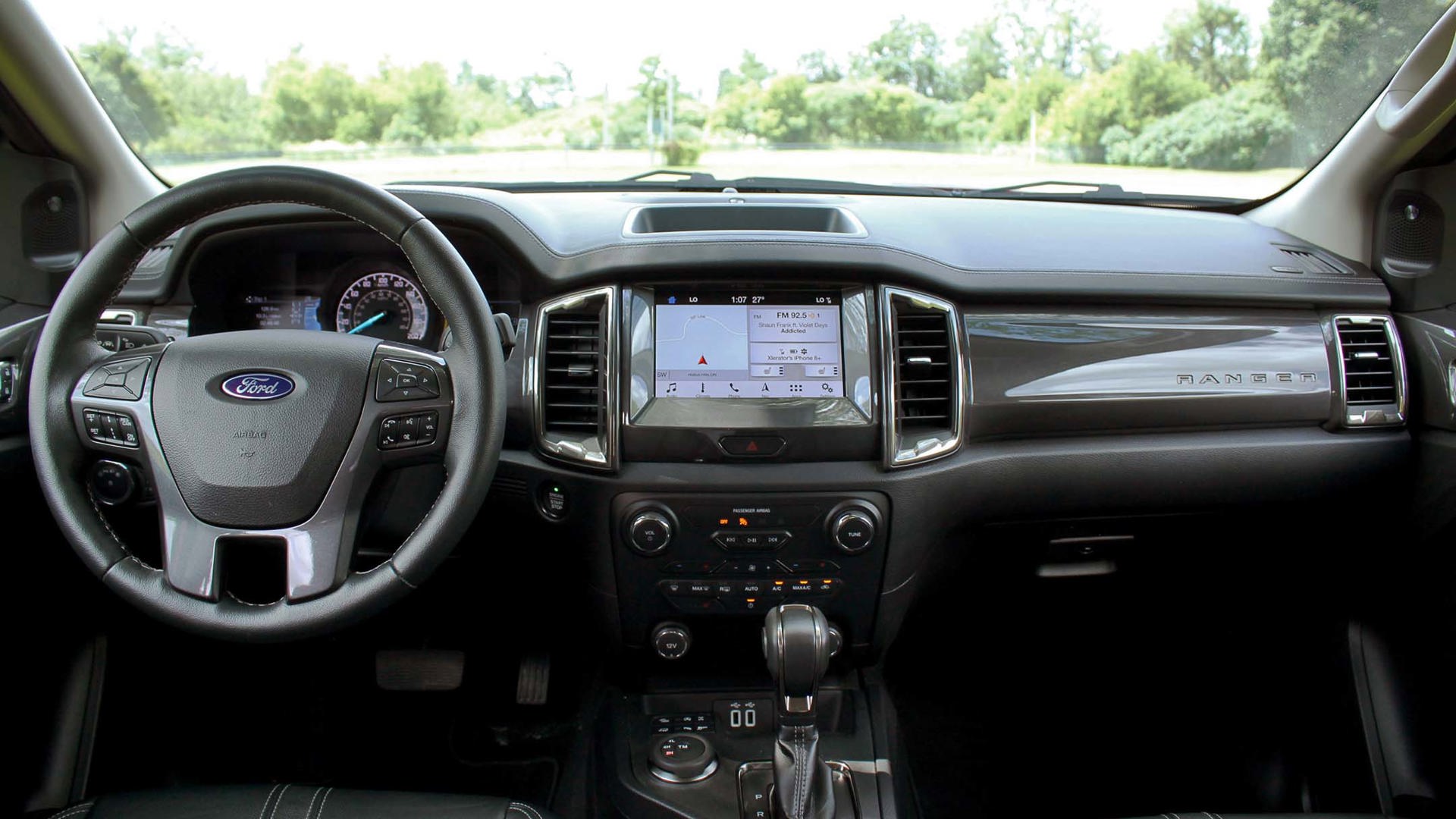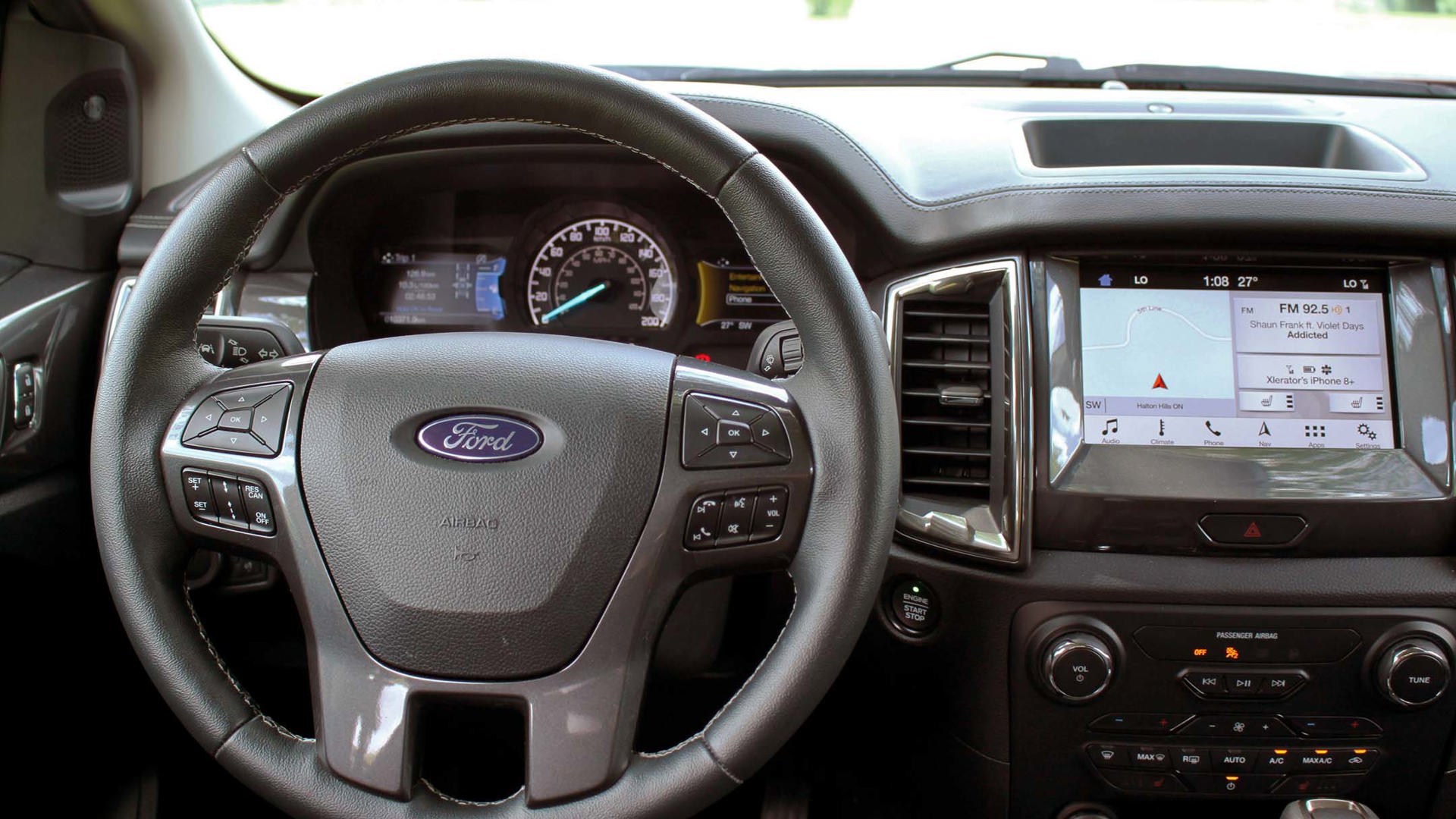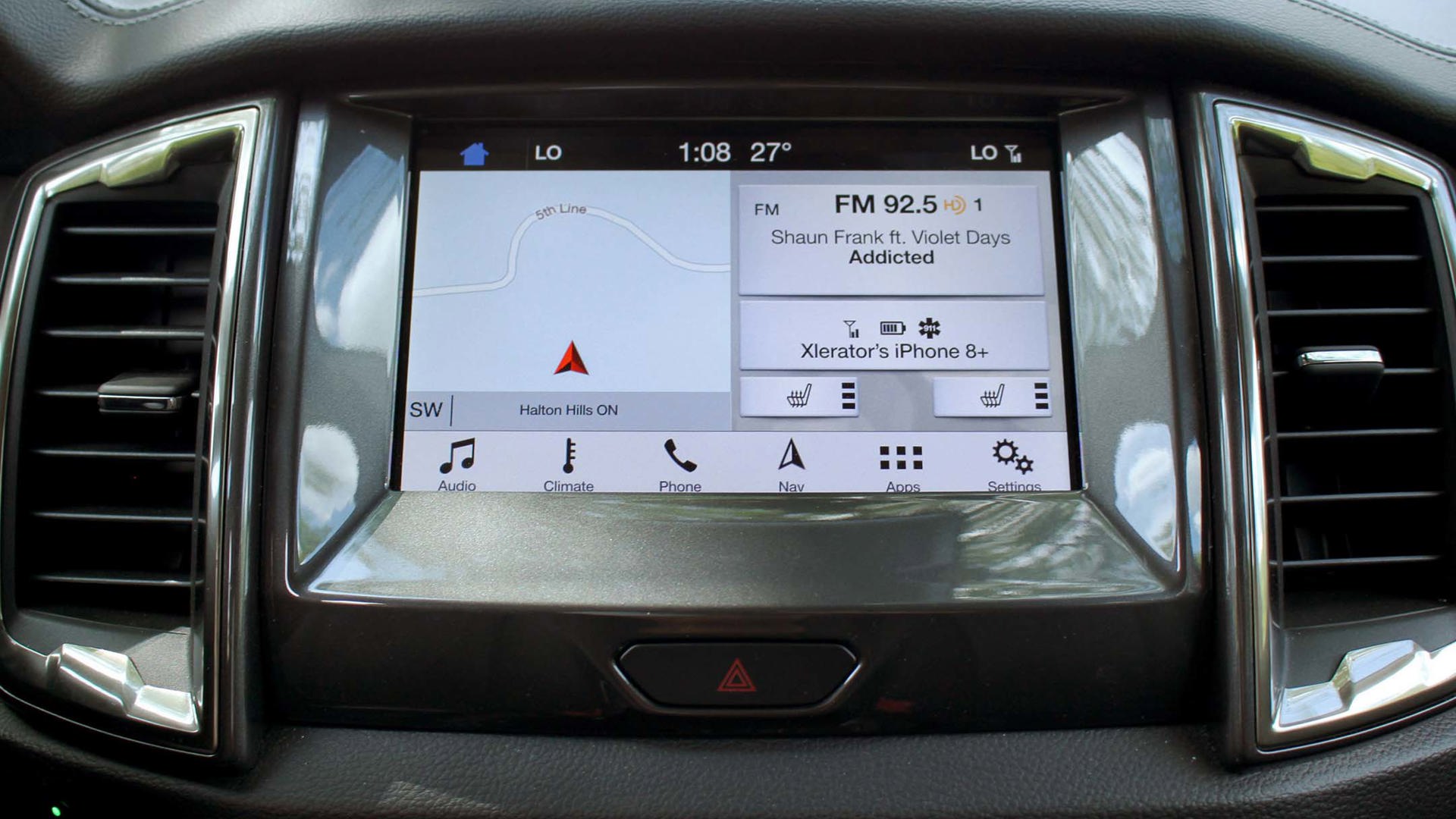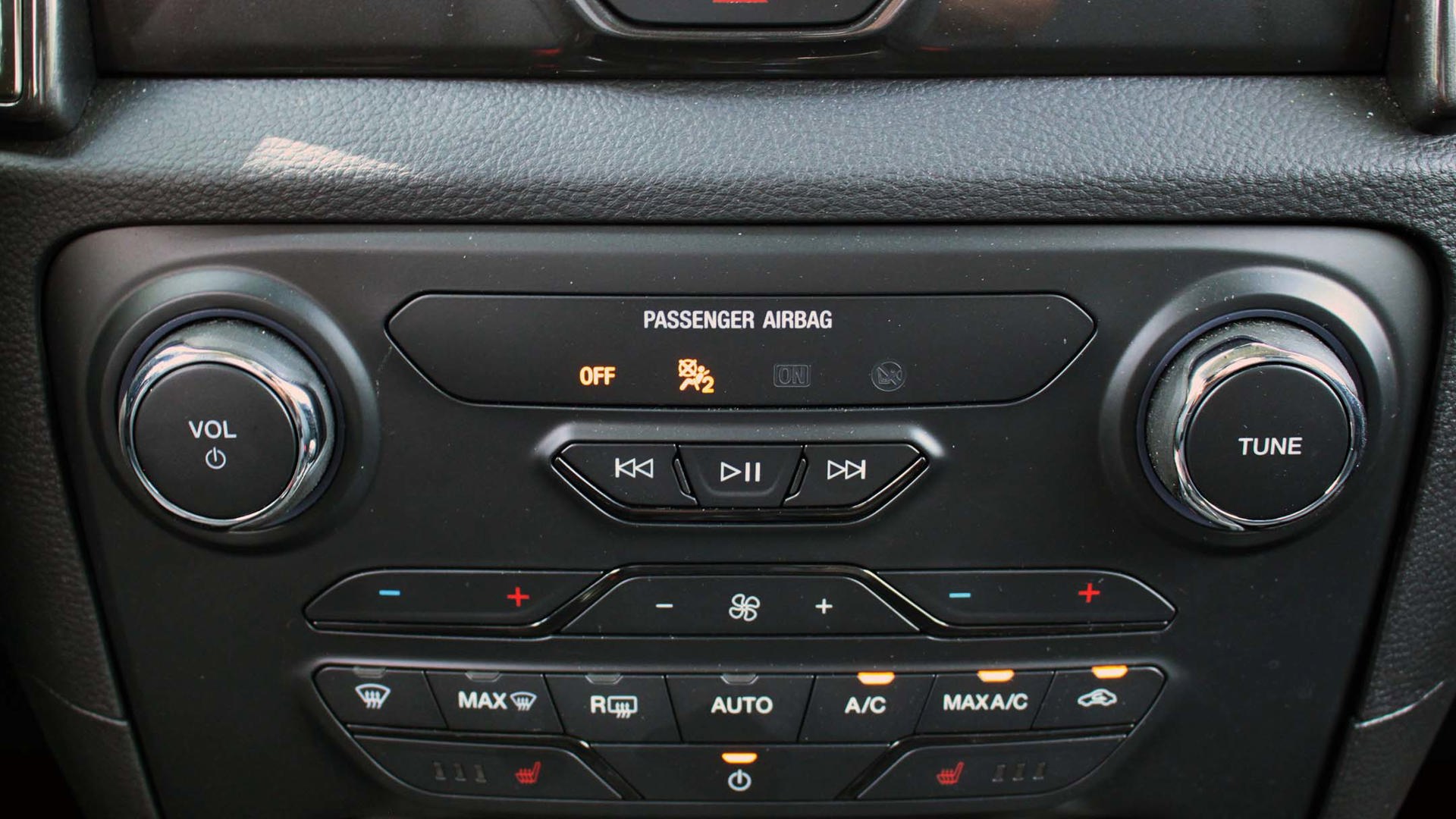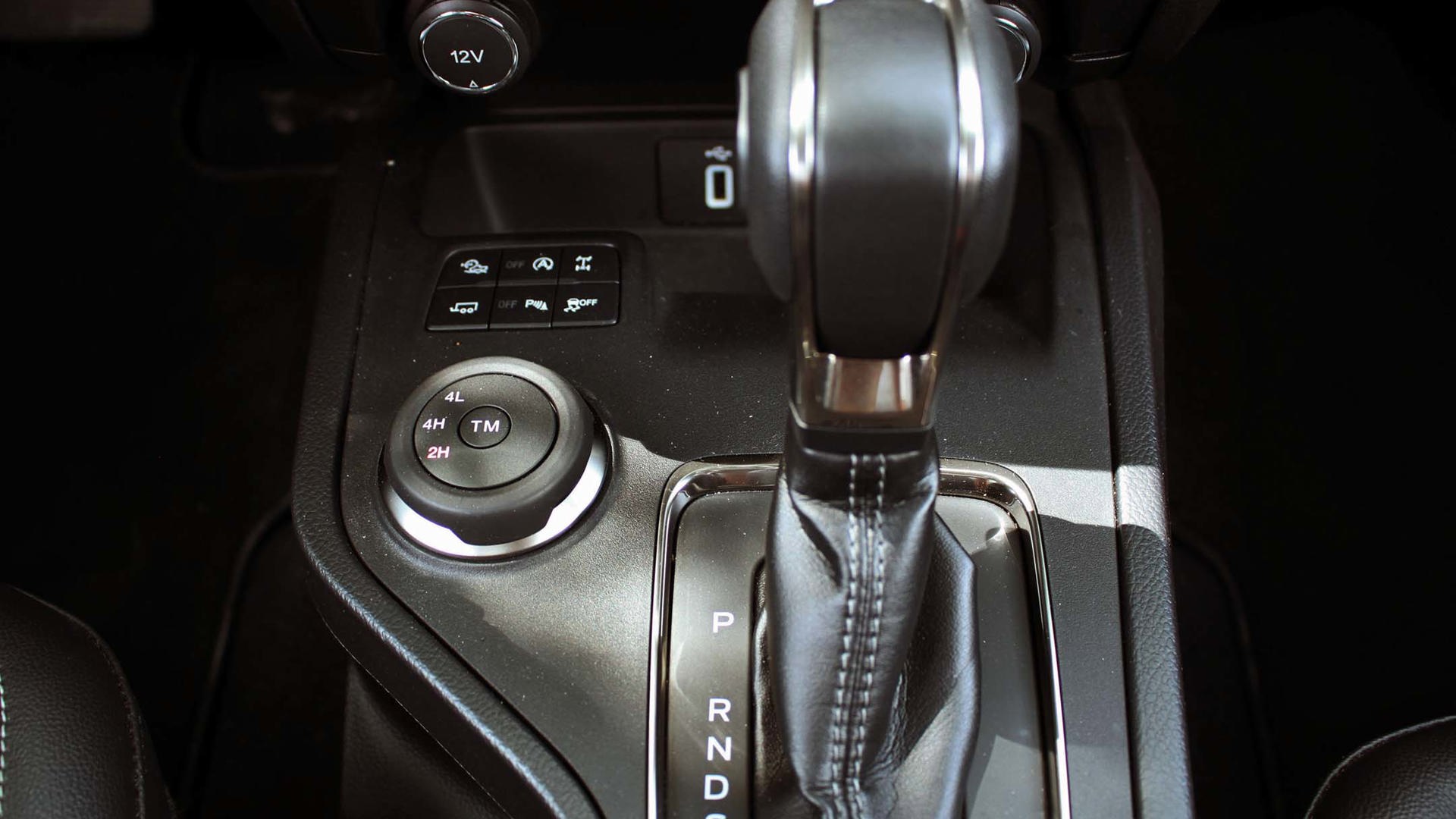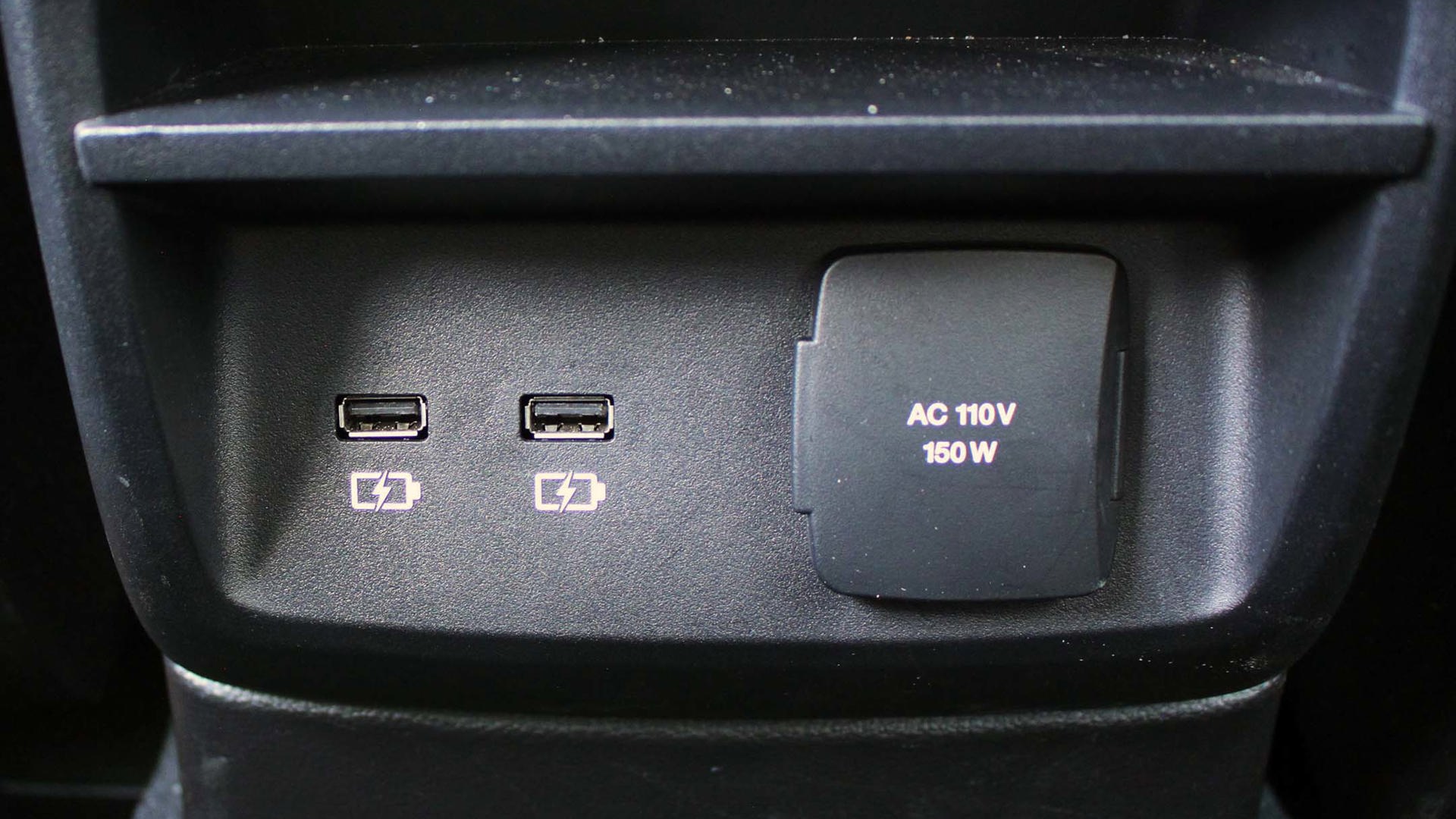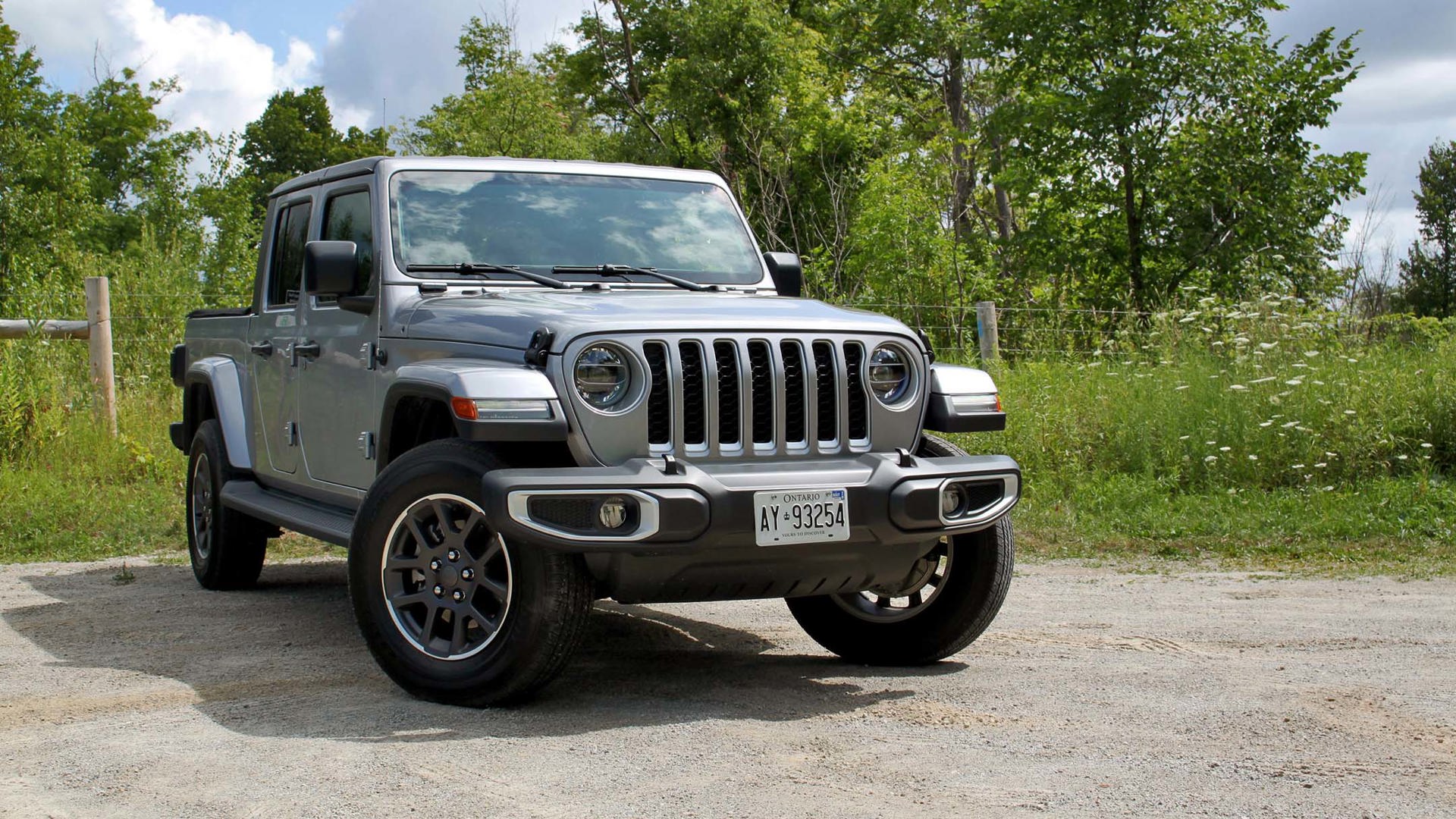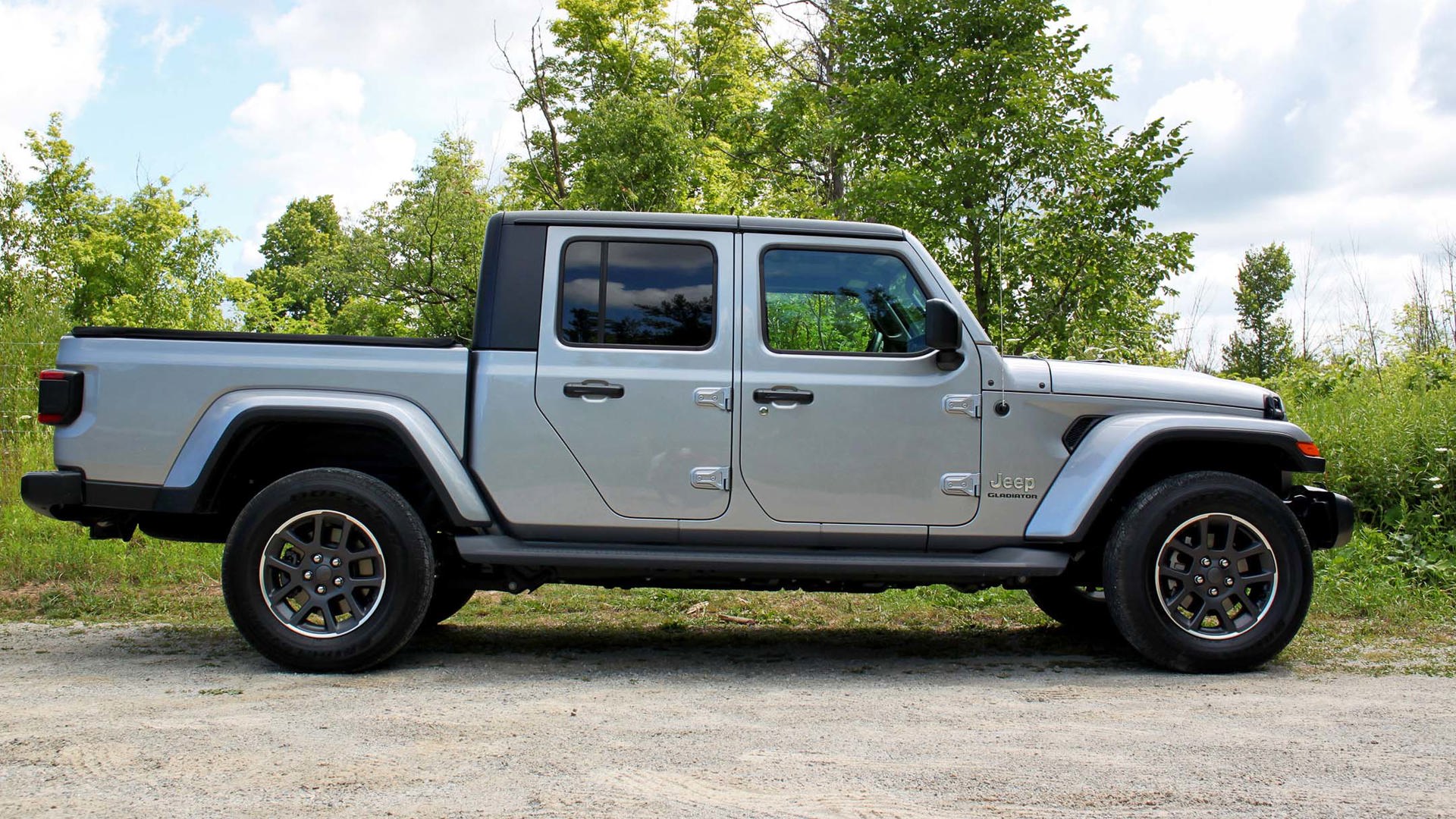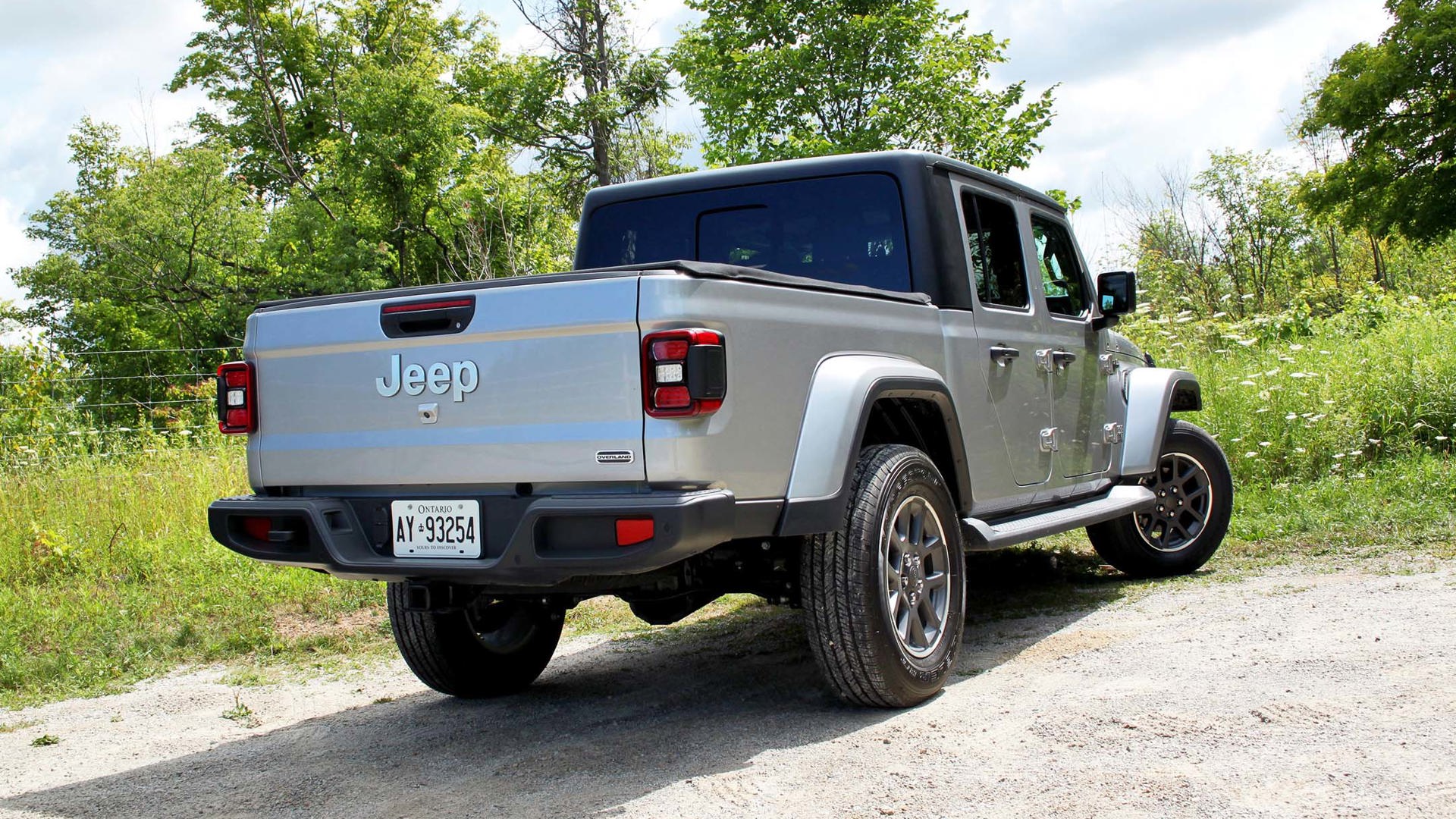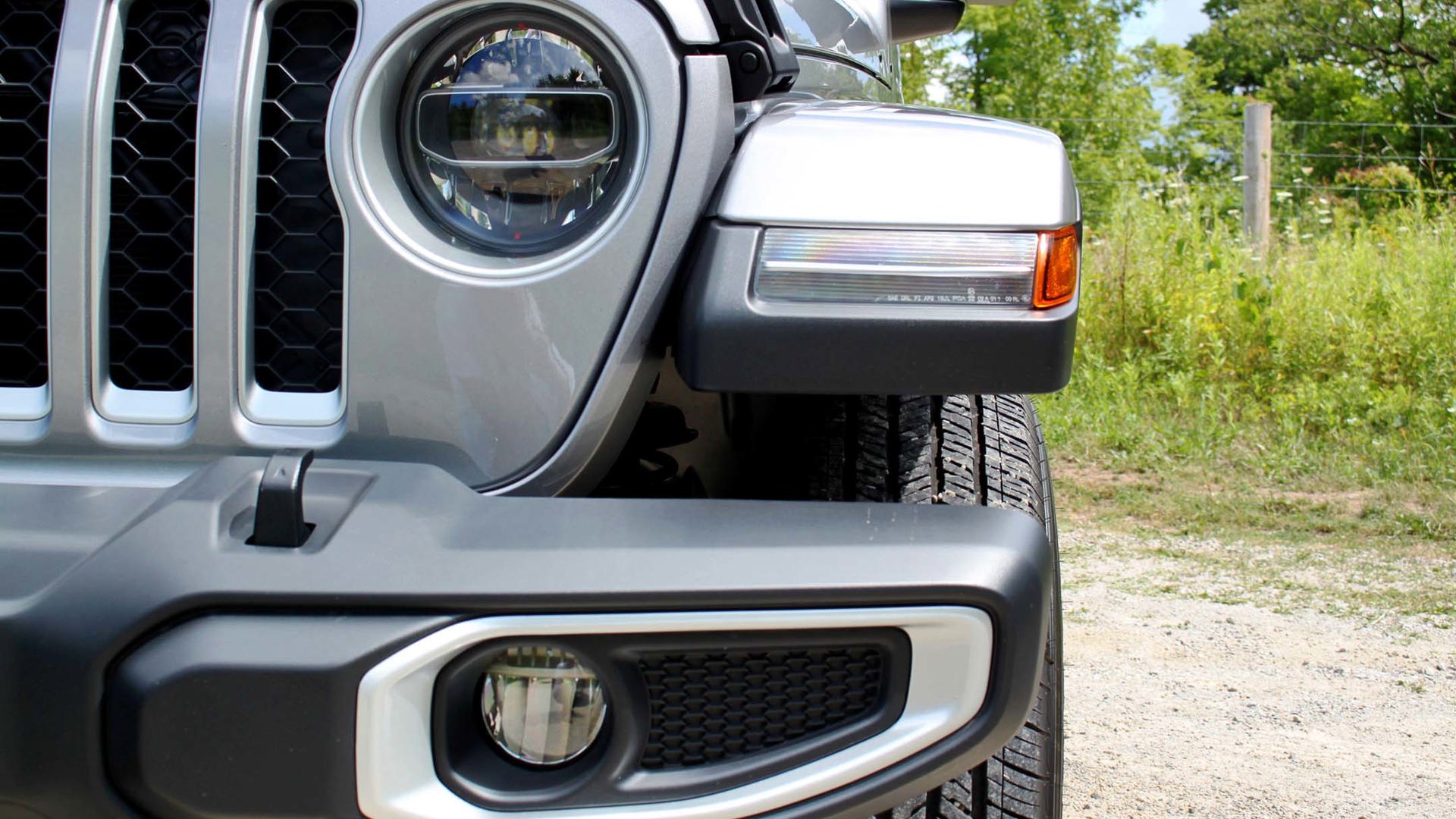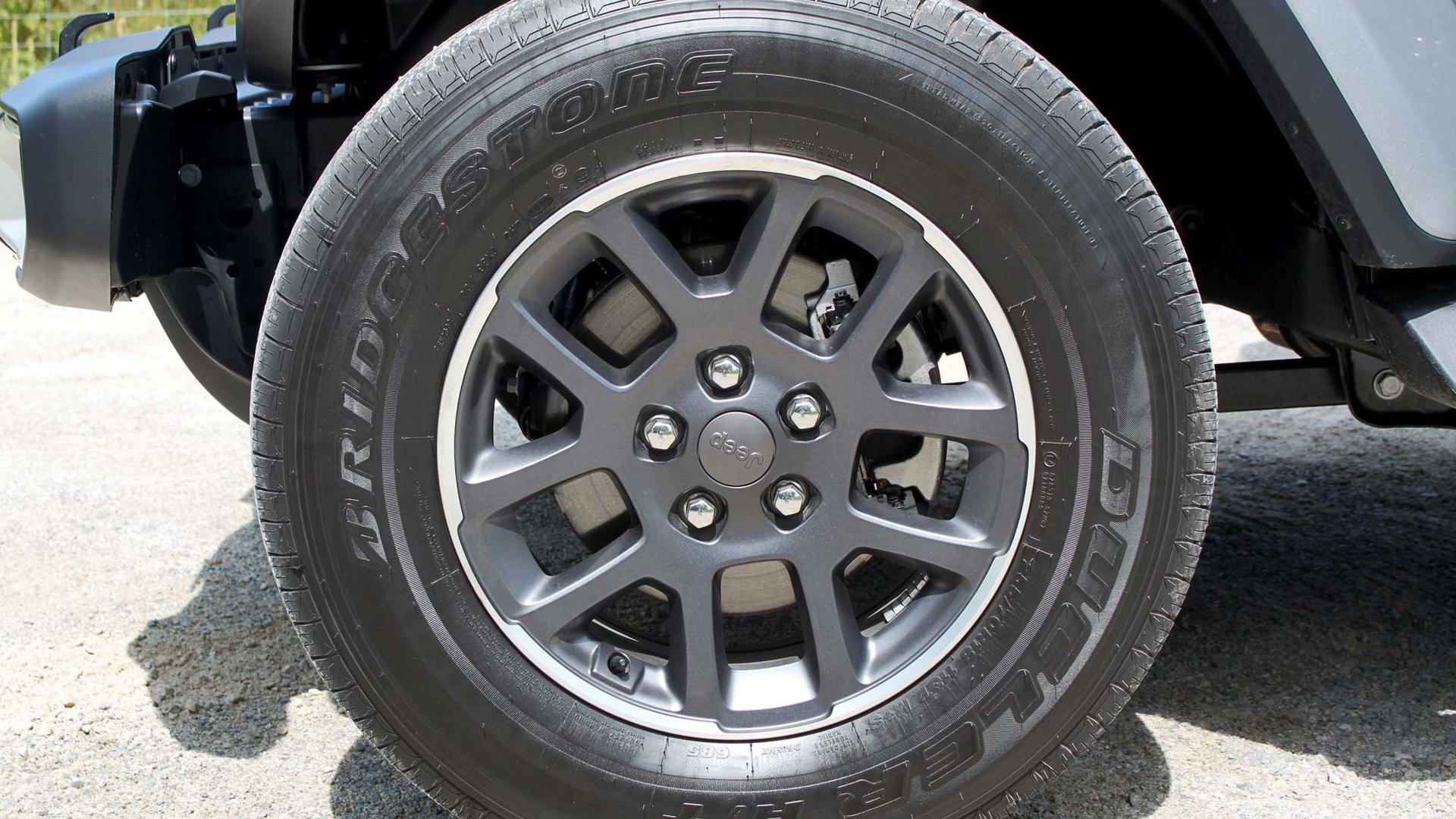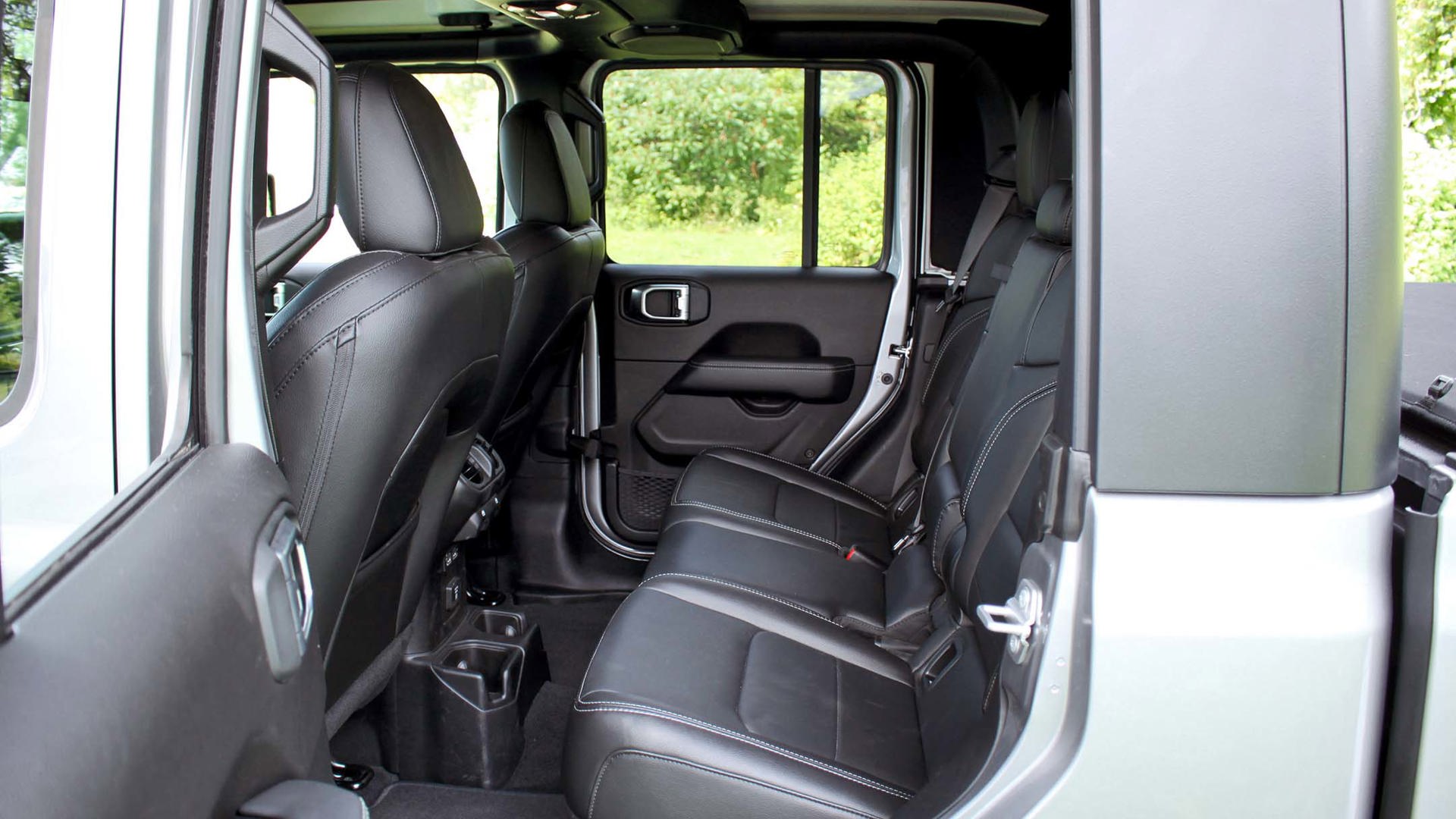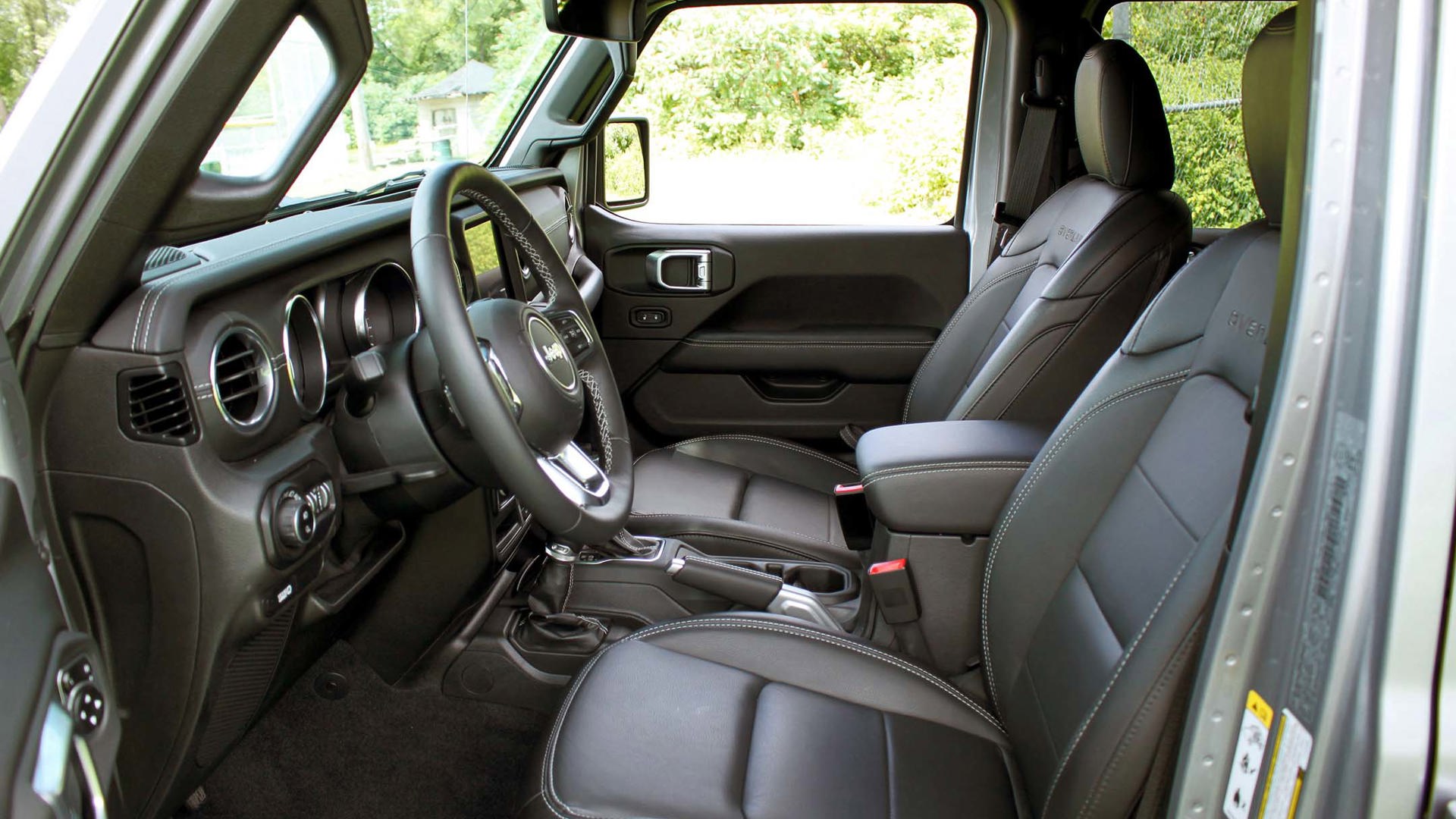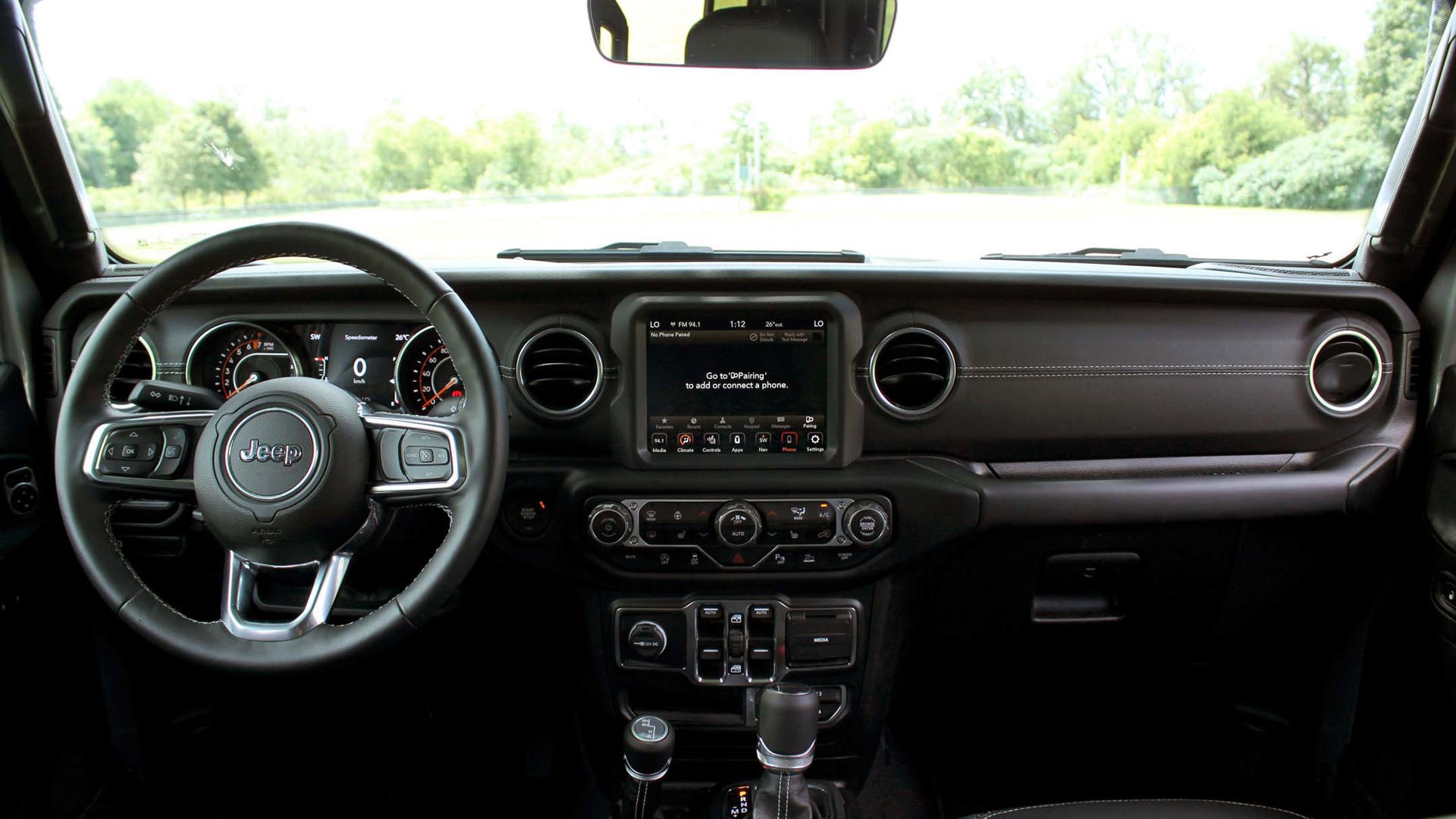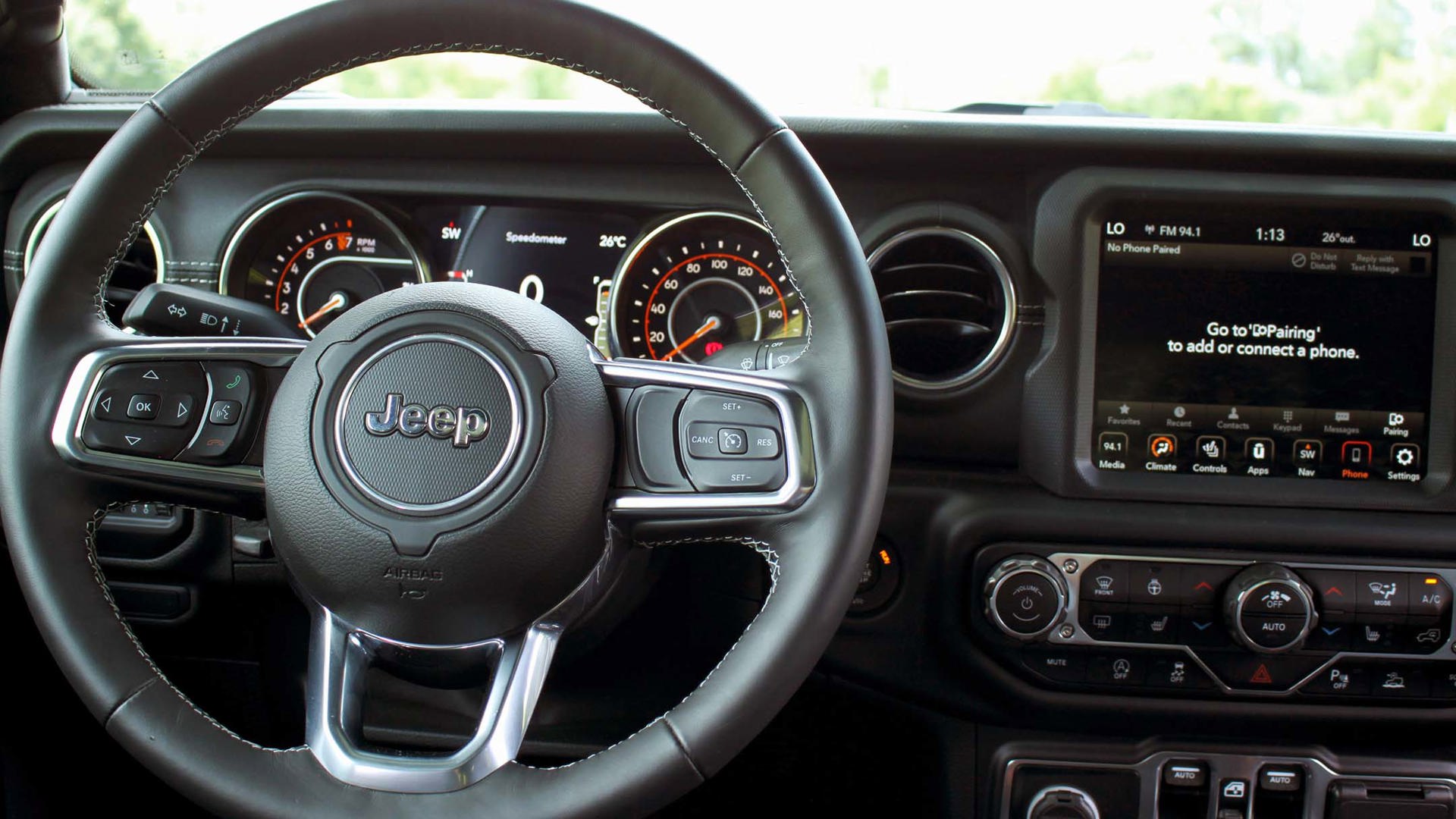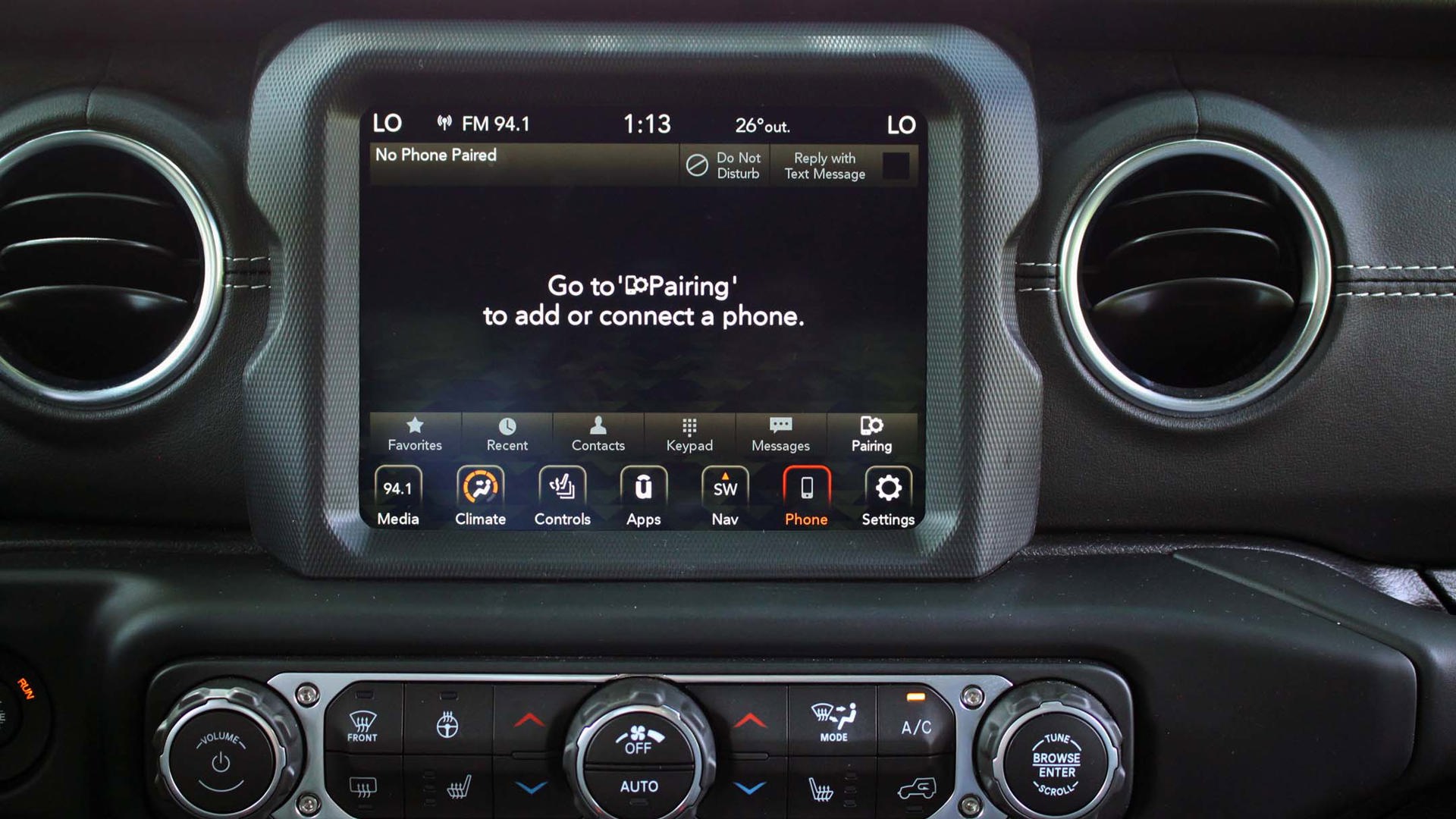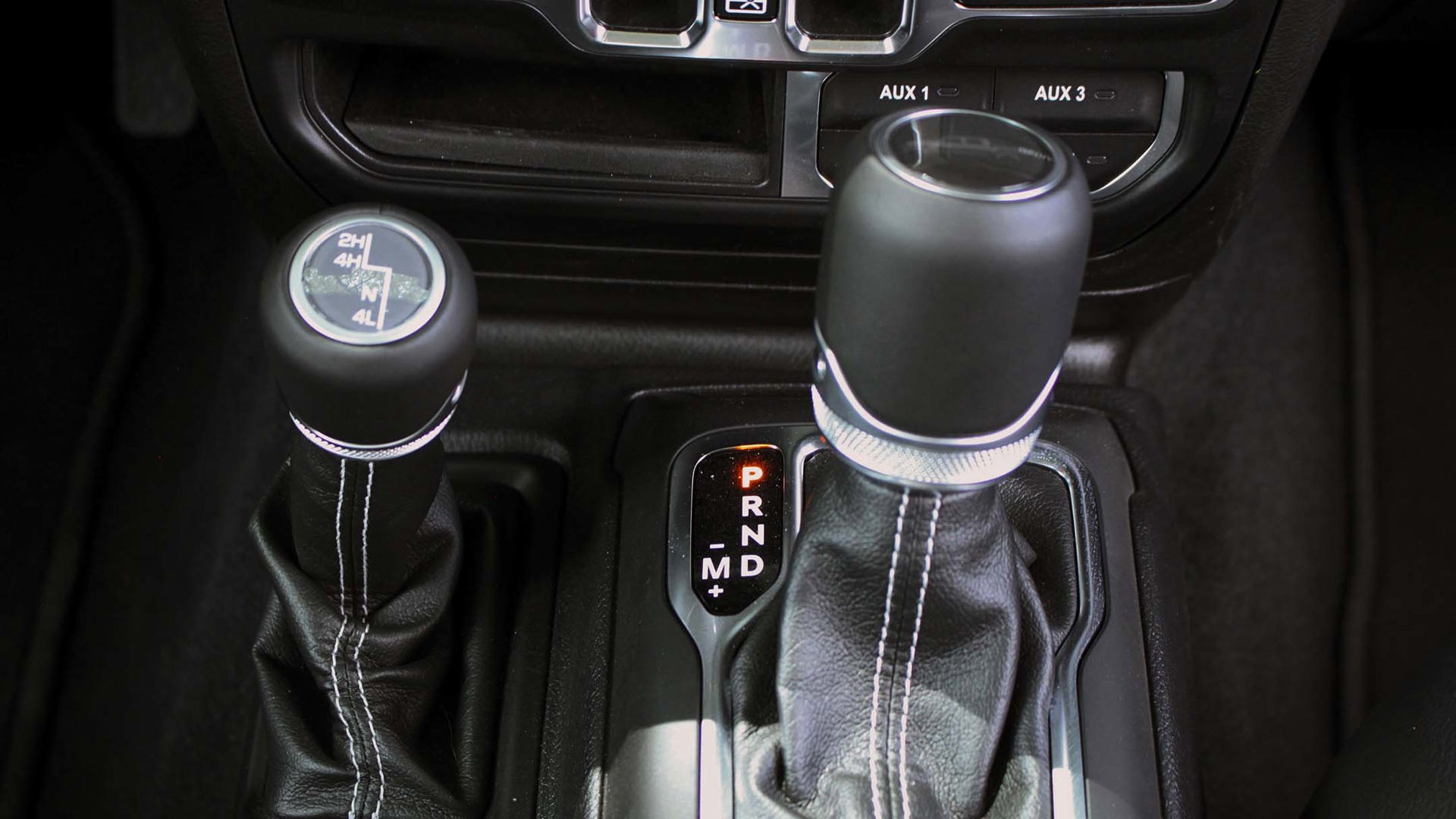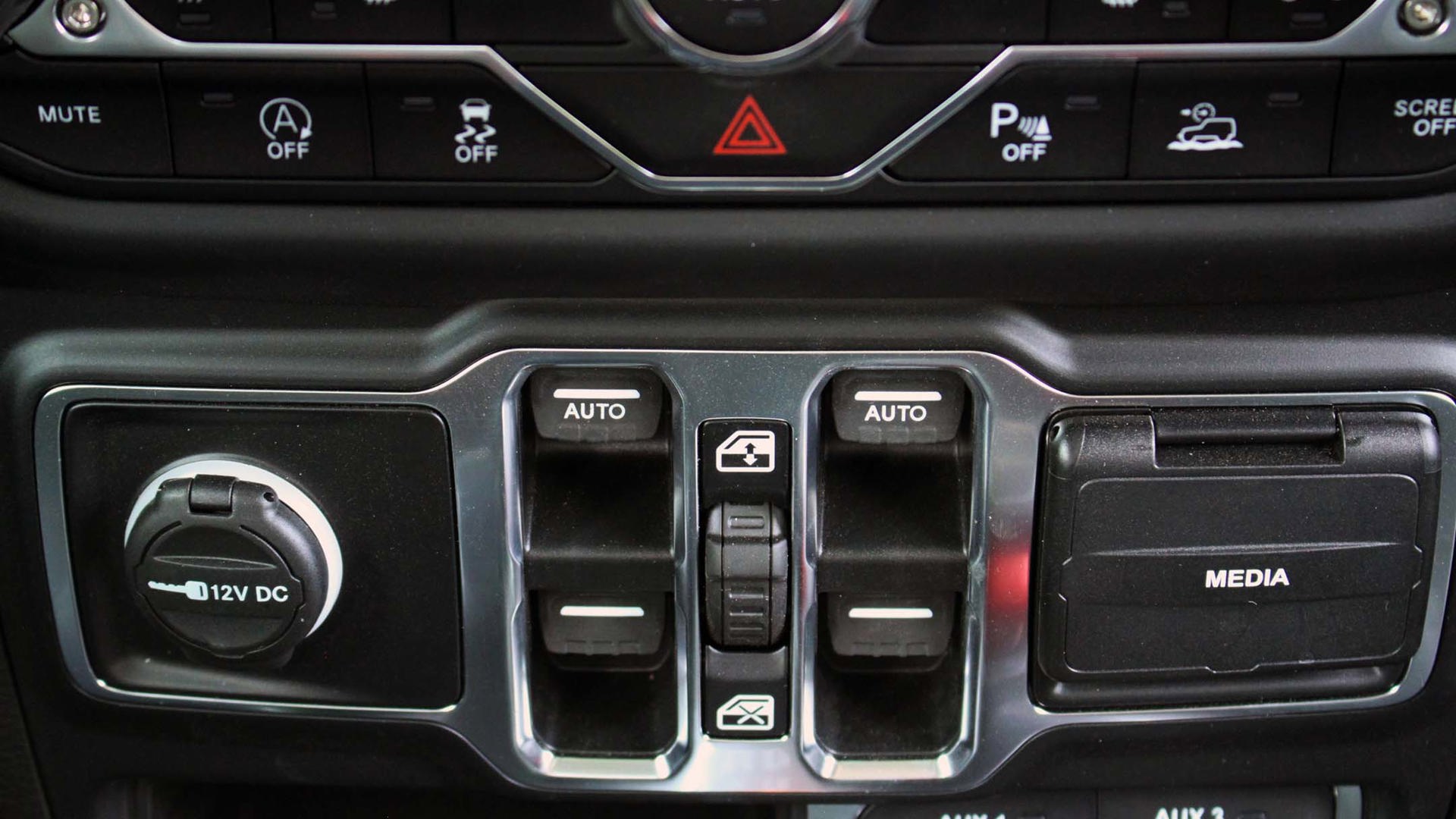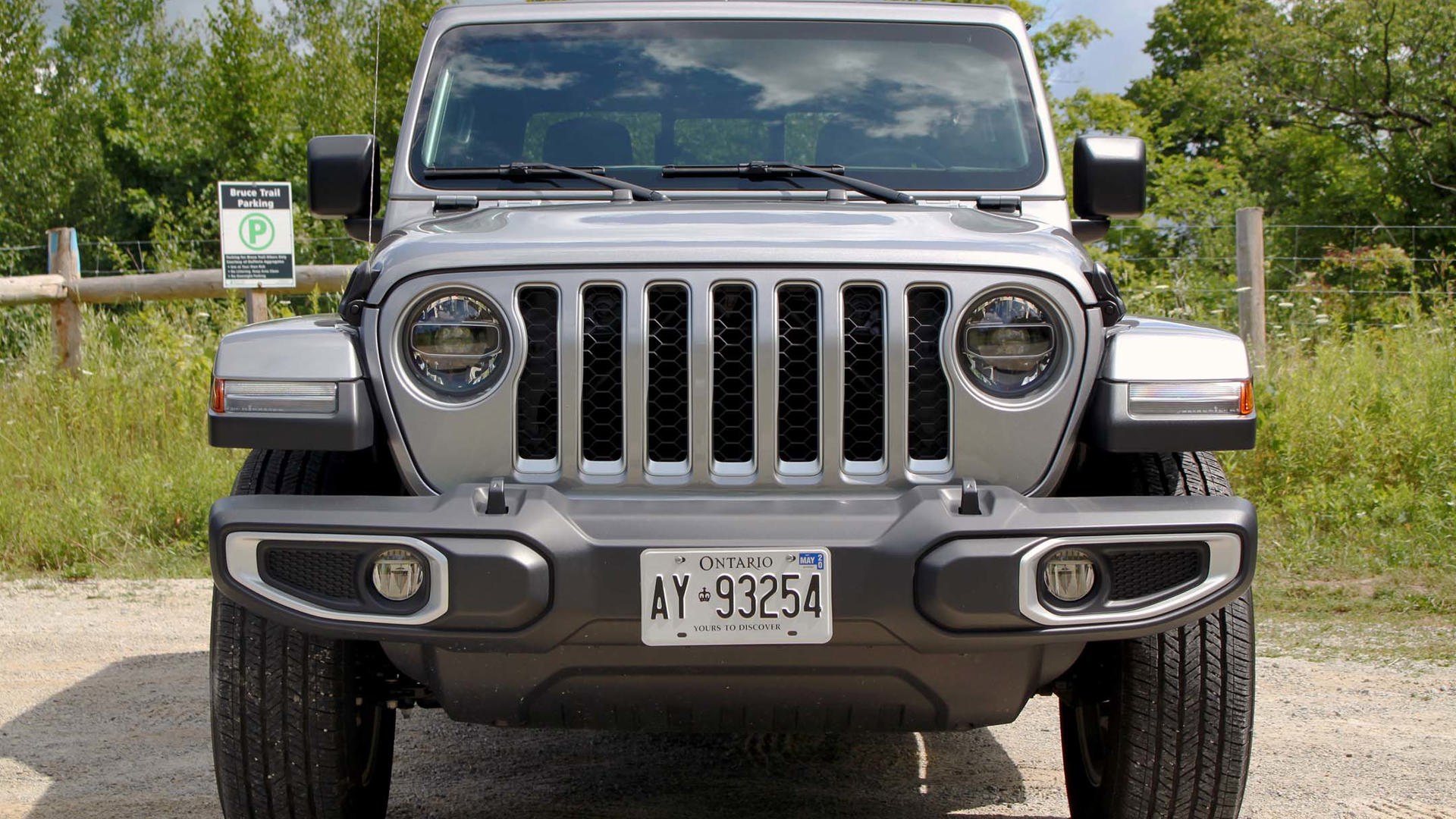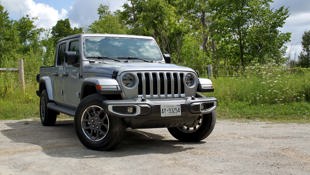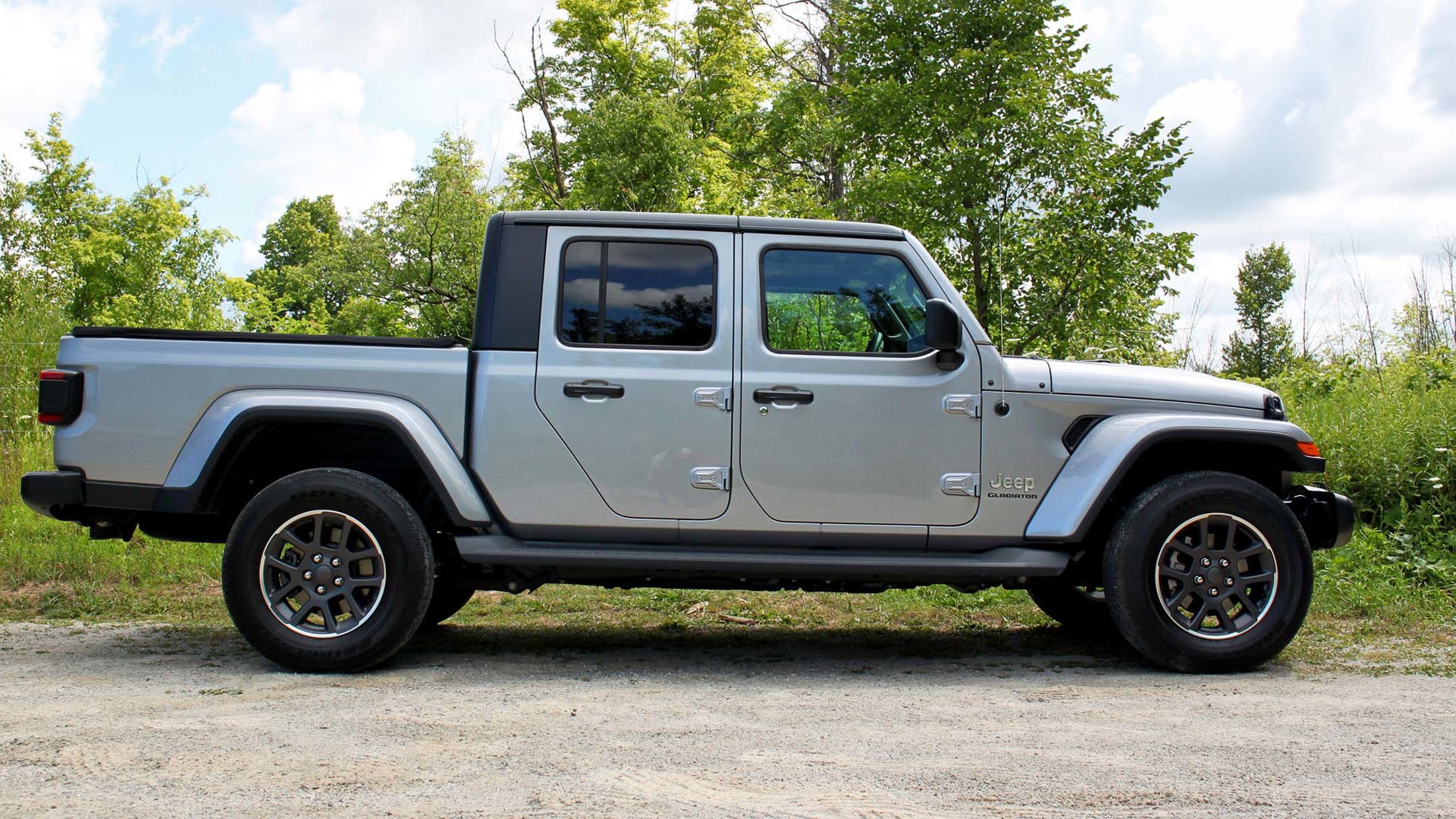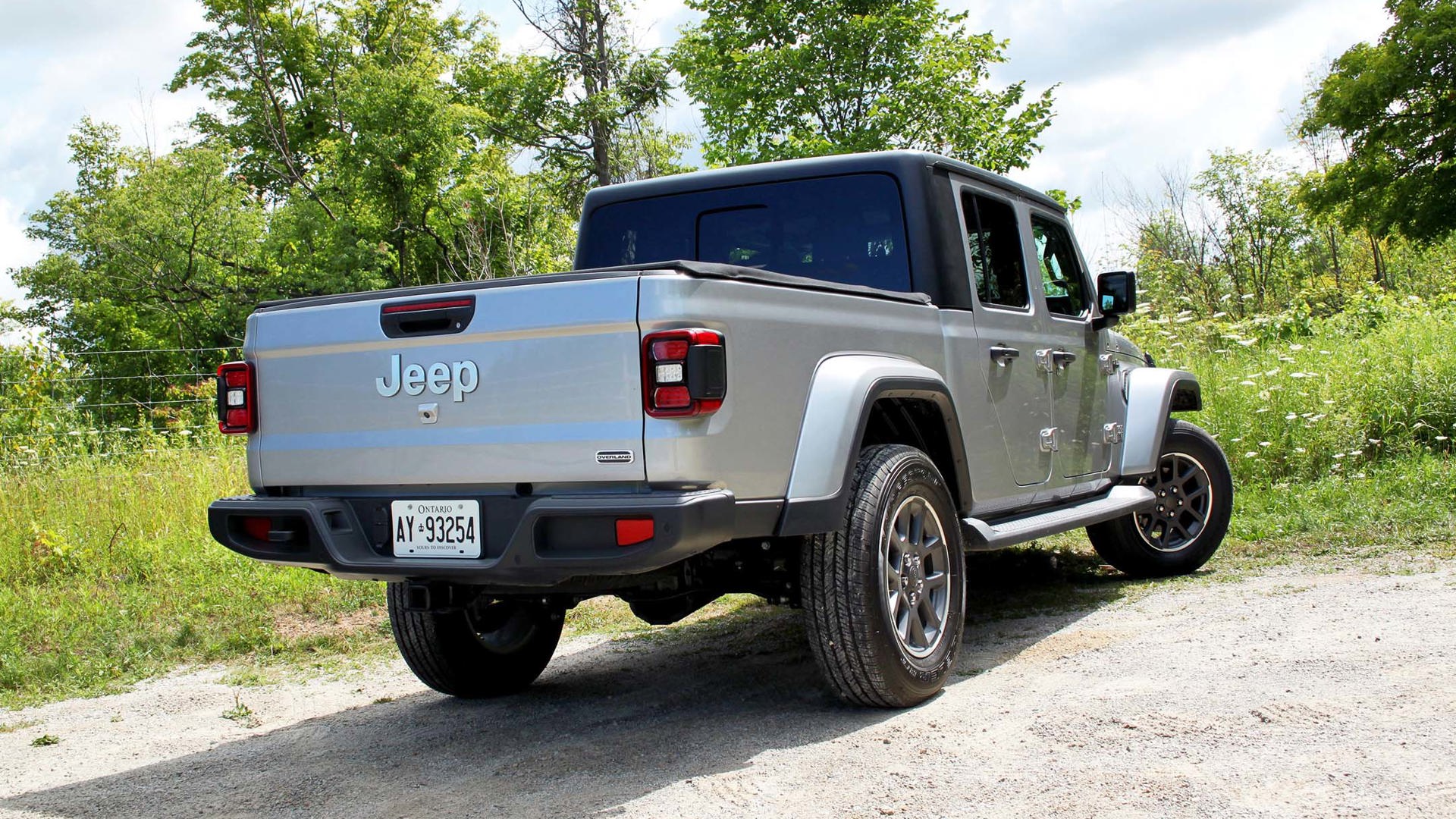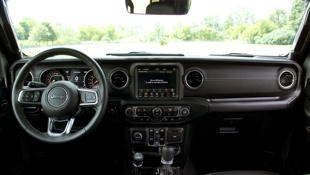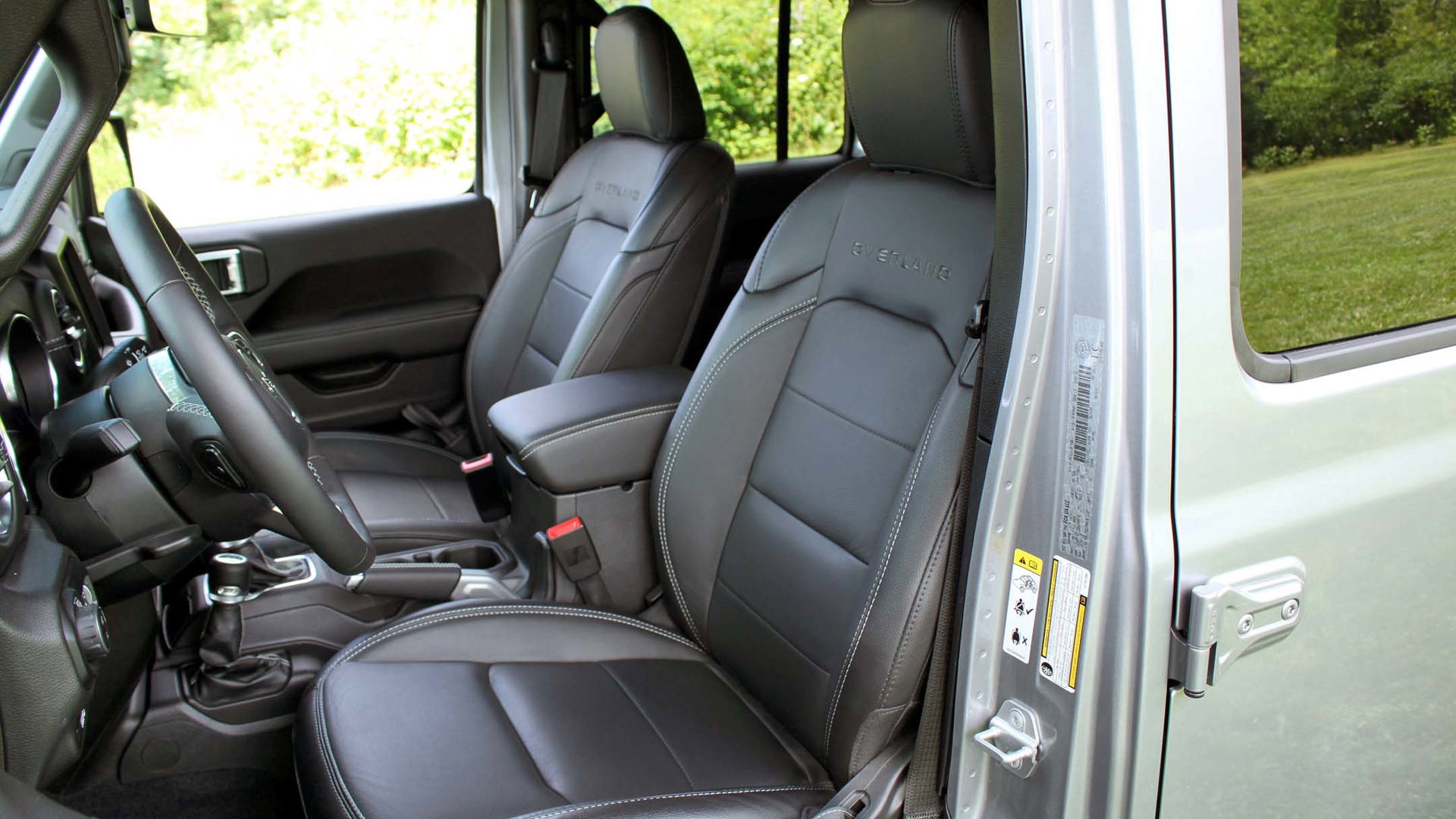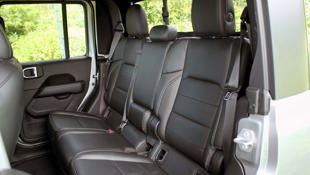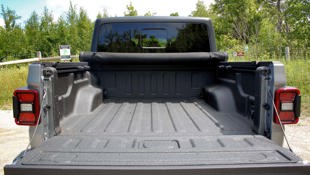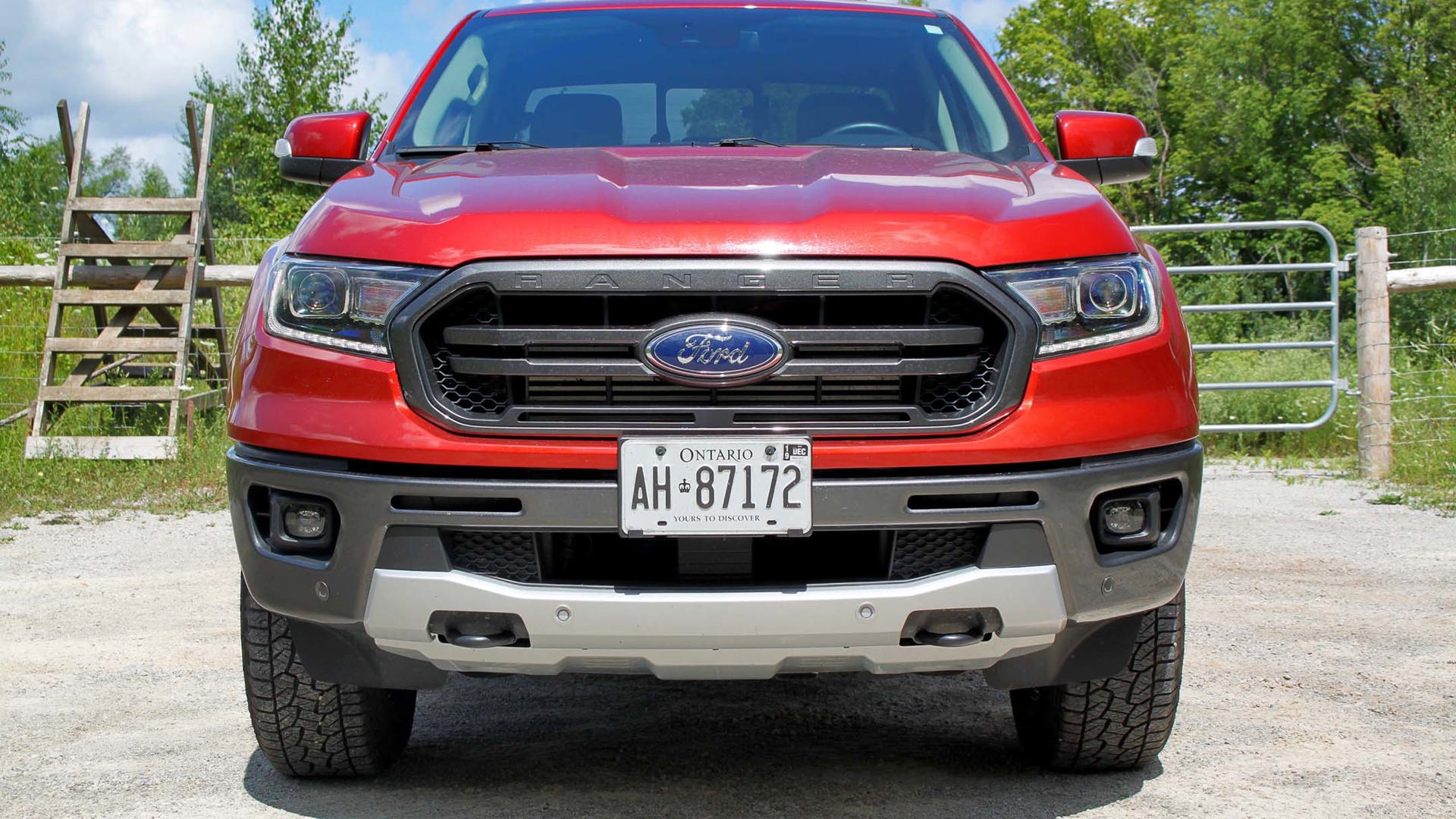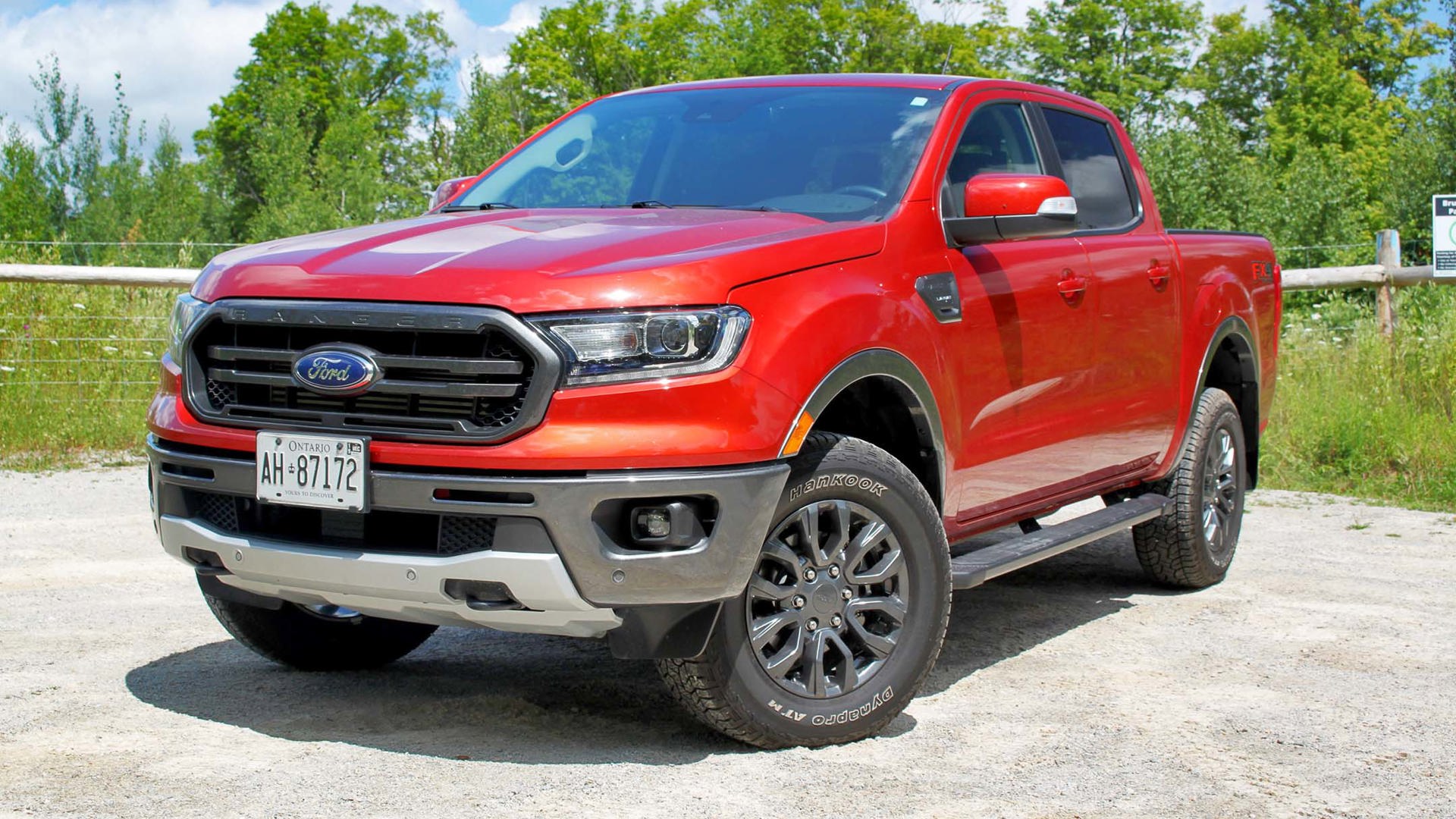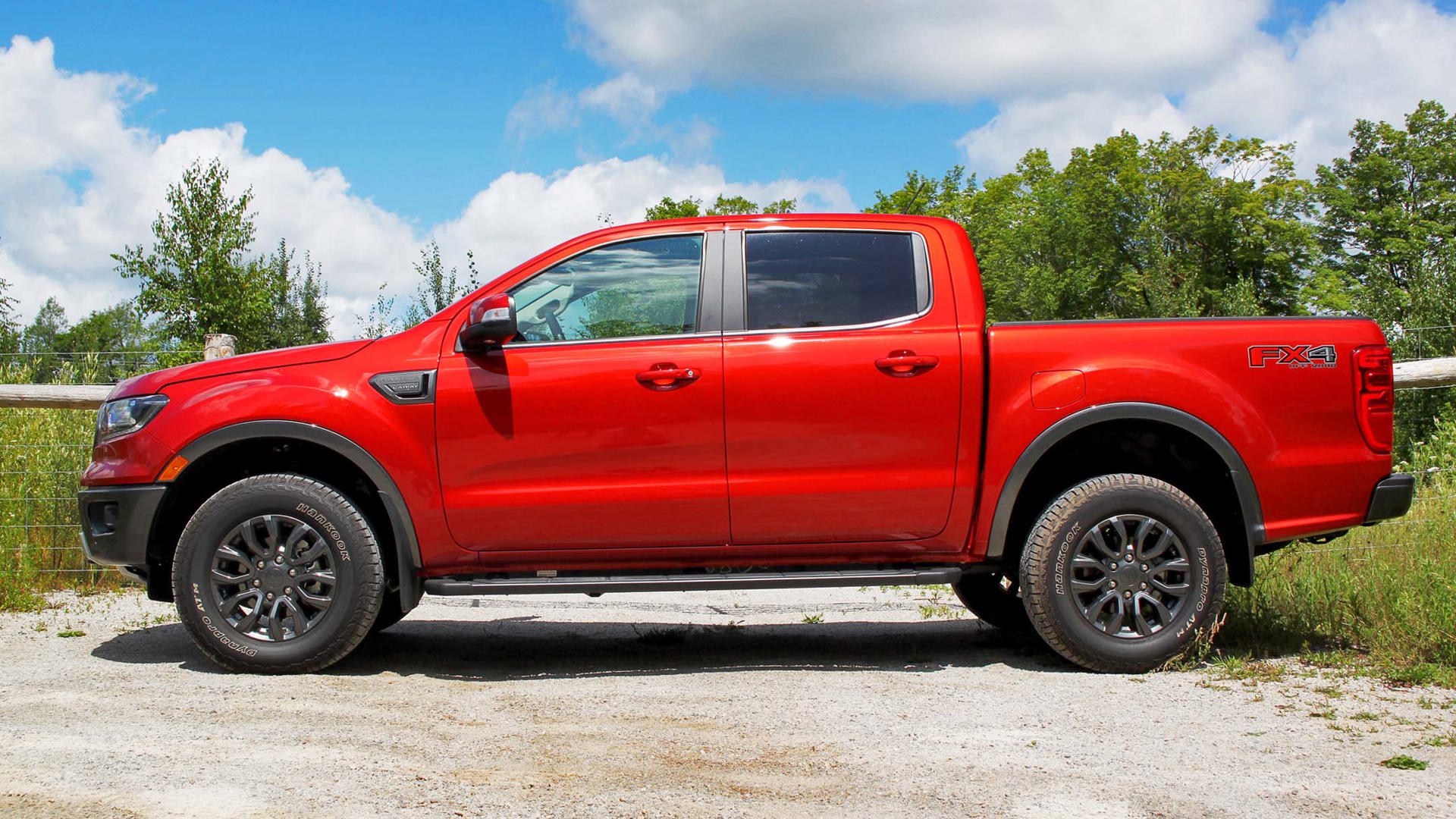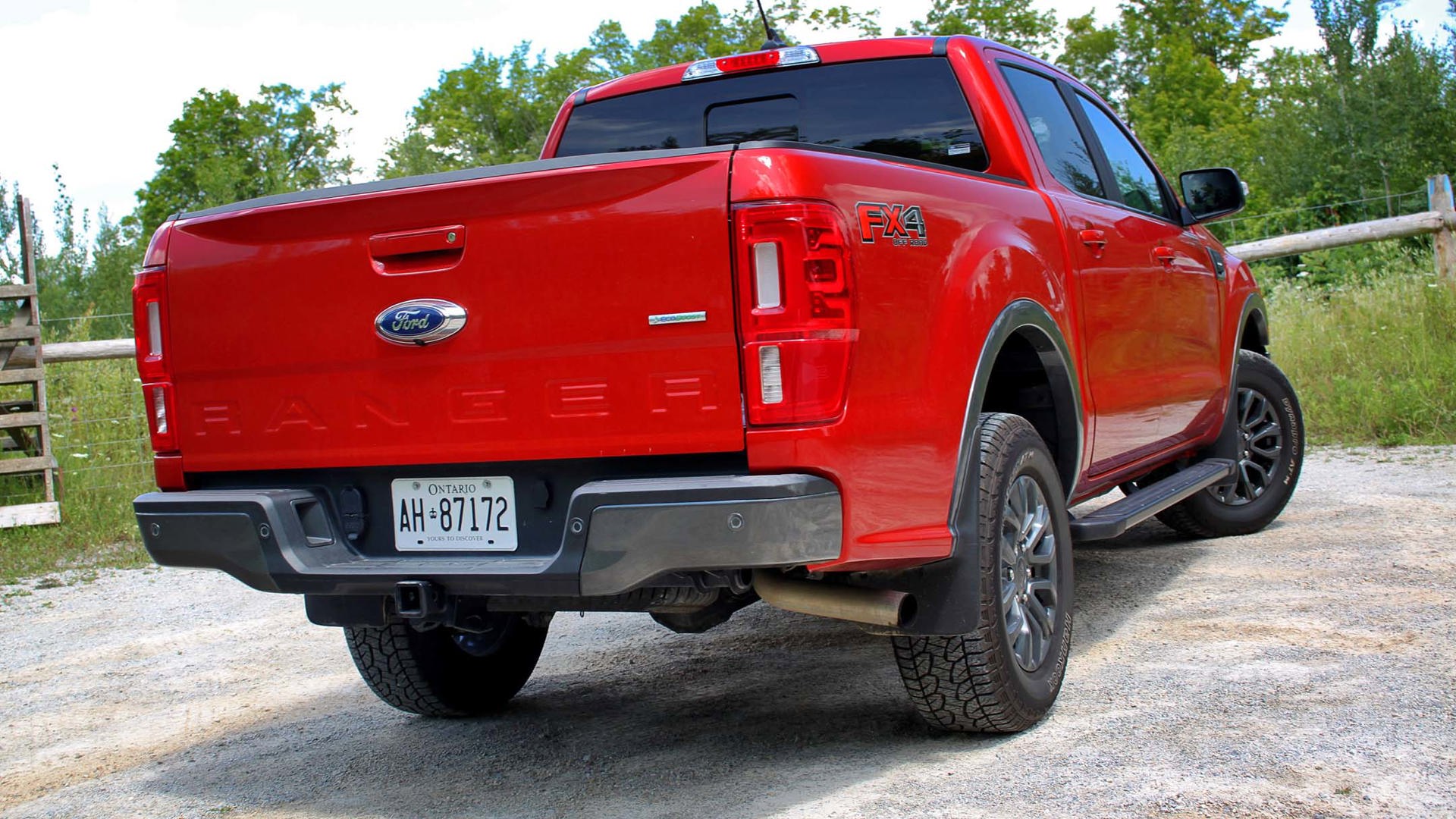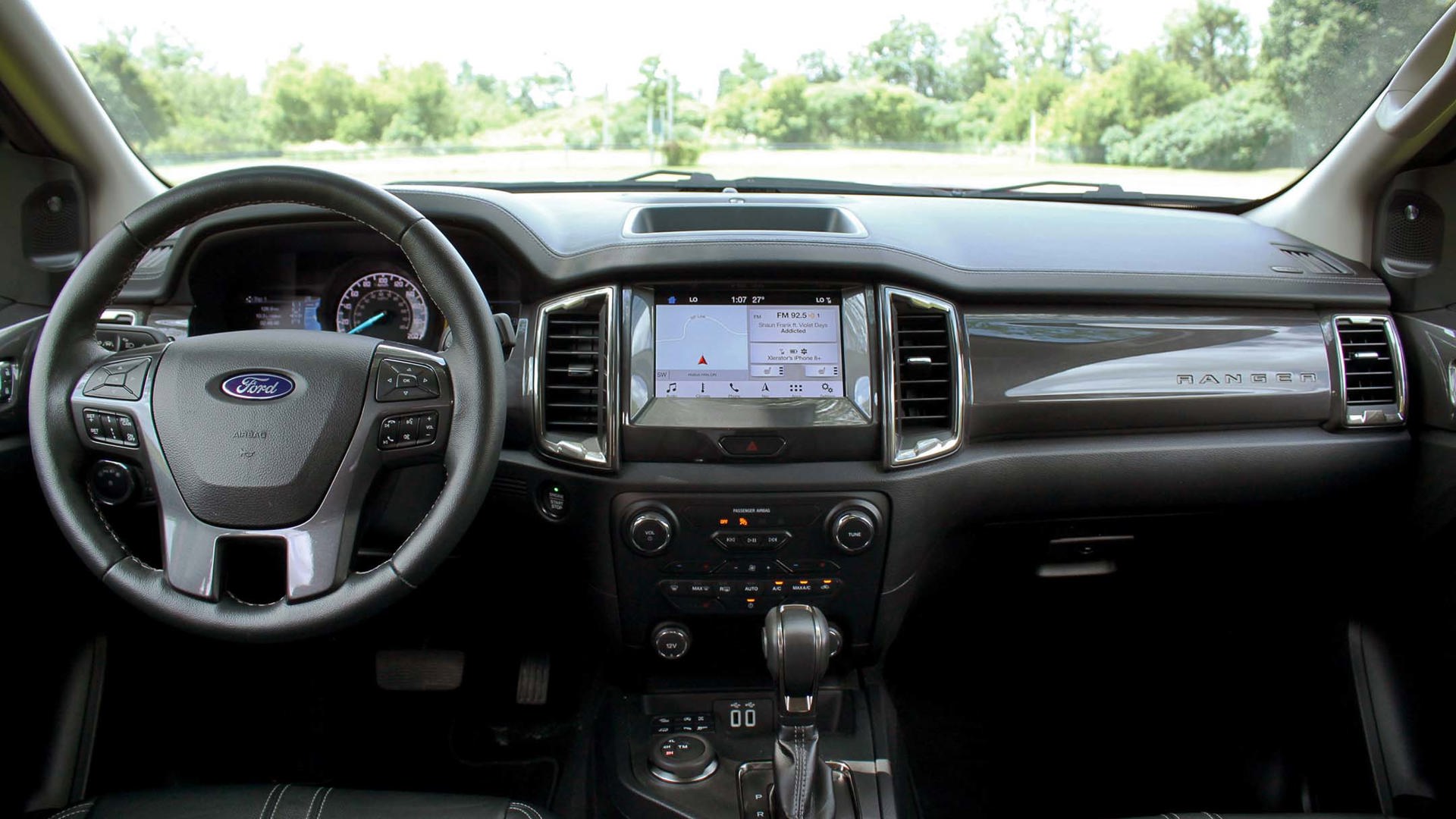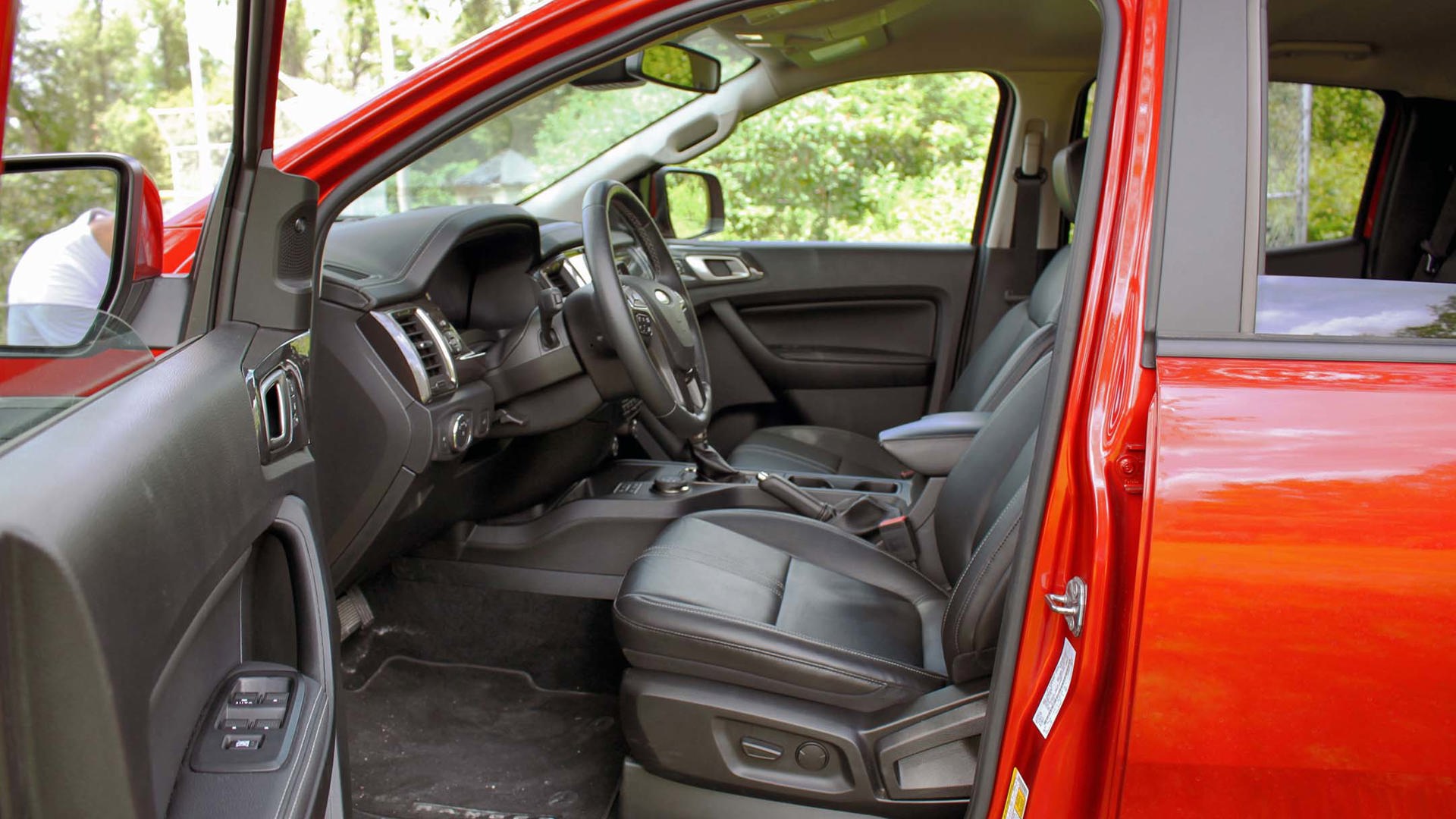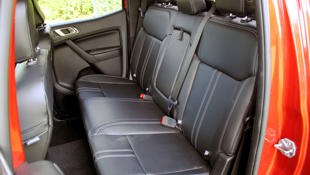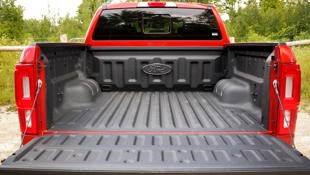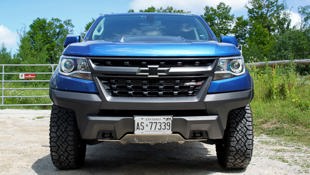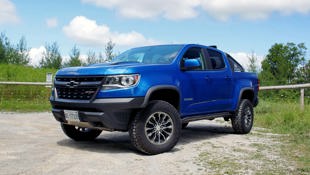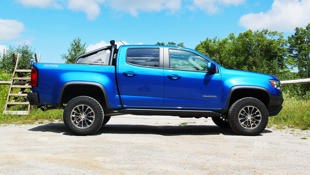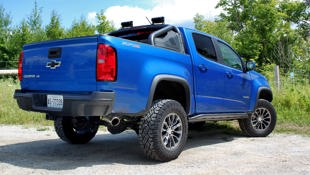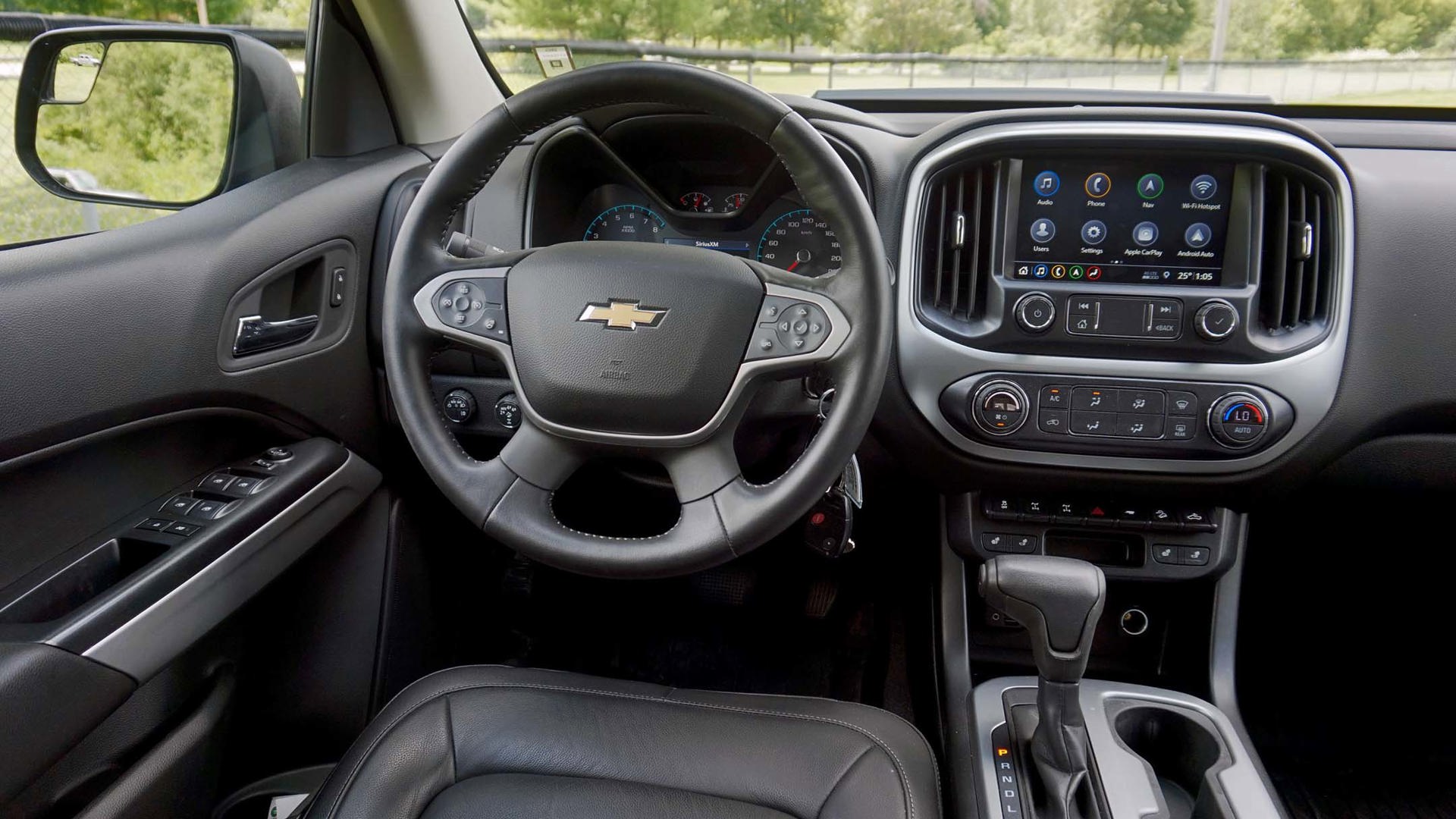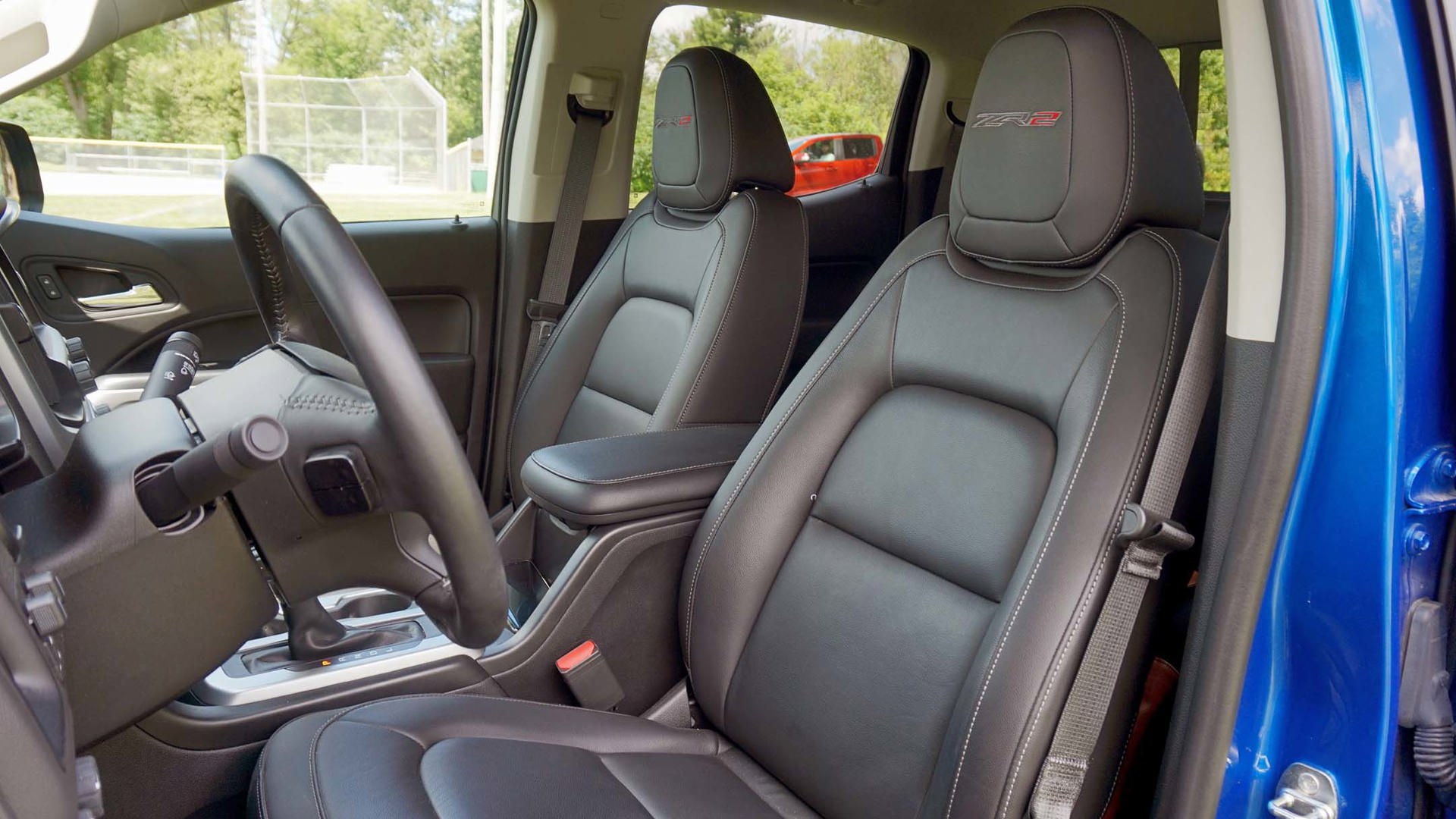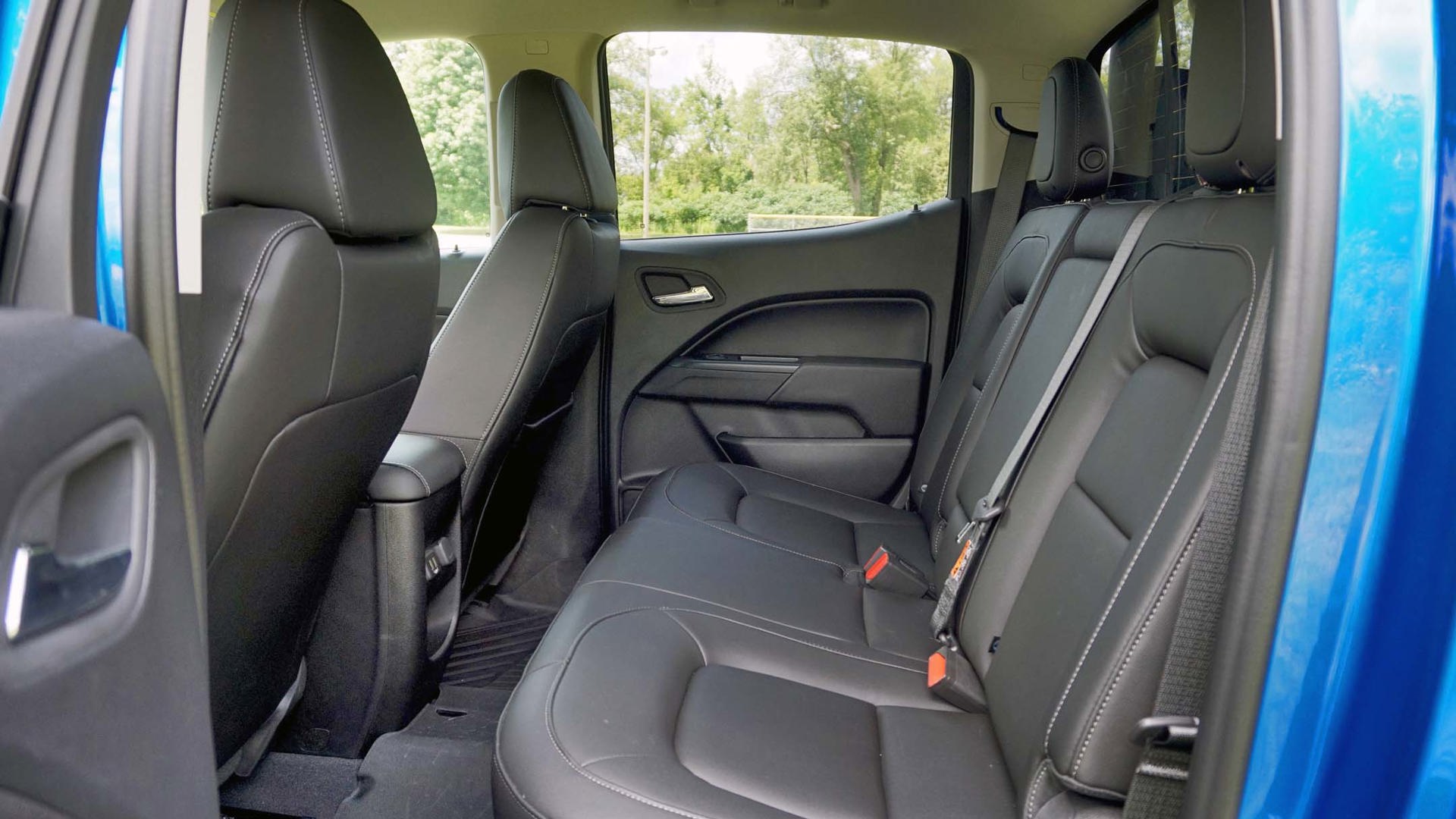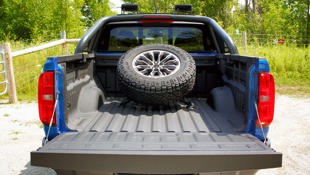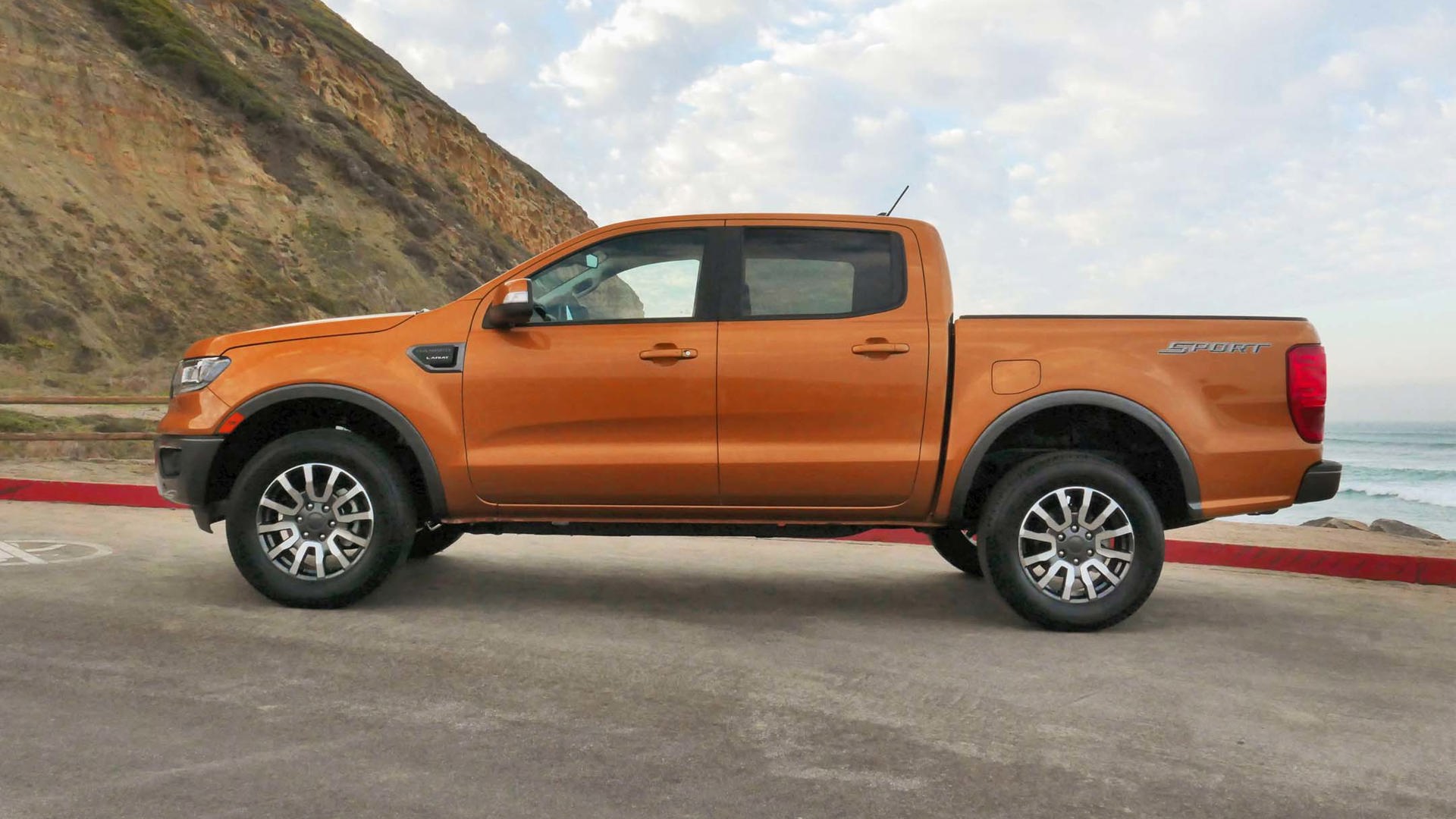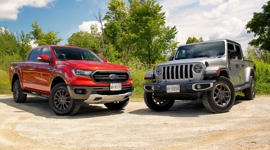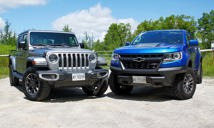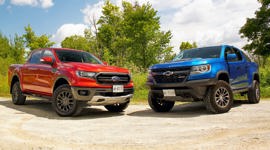Comparison Data
|
2019 Chevrolet Colorado ZR2
|
2019 Ford Ranger Lariat
|
2020 Jeep Gladiator Overland
|
|---|---|---|
|
Engine Displacement
3.6L
|
2.3L
|
3.6L
|
|
Engine Cylinders
V6
|
I4
|
V6
|
|
Peak Horsepower
306 hp @ 6, 800 rpm
|
270 hp @ 5,500 rpm
|
285 hp @ 6,400 rpm
|
|
Peak Torque
275 lb-ft @ 4,000 rpm
|
310 lb-ft @ 3,000 rpm
|
260 lb-ft @ 4,400 rpm
|
|
Fuel Economy
15.0/13.0/14.1 L/100 km cty/hwy/cmb
|
11.8/9.8/10.9 L/100 km cty/hwy/cmb
|
13.7/10.7/12.3 L/100 km cty/hwy/cmb
|
|
Cargo Space
1,169 L
|
1,226 L
|
994 L
|
|
Base Price
$47,600
|
$42,289
|
$49,495
|
|
A/C Tax
$100
|
$100
|
$100
|
|
Destination Fee
$1,895
|
$1,800
|
$1,895
|
|
Price as Tested
$56,465
|
$51,859
|
$63,235
|
|
Optional Equipment
$6,870
|
$7,770
|
$11,745
|
Buying a small pickup truck used to be simple due to the limited options on the market. The Toyota Tacoma was the top pick for reliability and ruggedness, the Nissan Frontier for affordability, the Honda Ridgeline for practicality, and the Chevrolet Colorado or GMC Canyon if the others didn’t fit. But the segment has recently grown, with new entries like the Ford Ranger and Jeep Gladiator, as well as specialty models such as the Colorado ZR2, which excel in specific areas – in this case, off-roading.
With three new small trucks together for testing, picking a winner isn’t easy. Small trucks have to be capable without being too expensive or unwieldy, charming truck buyers in a way half-tons can’t.
The all-new Jeep Gladiator aims to take what people love about the Wrangler and bring it to a new body style. It is big, but has those loveable Jeep hallmarks, from the design to the drive. It should appeal to the Jeep faithful, but will others get it?
The Ranger is Ford’s re-entry into the segment after taking a few years off to perfect the small truck for other markets while letting its F-150 reign supreme in North America. It’s back with a smaller engine and a focus on getting the job done.
The Colorado ZR2, meanwhile, is something of a blend of the other two. It starts life as a mainstream mid-size truck – plenty capable with a nice powerplant – but then gets a serious amount of off-road equipment. Sometimes it can be a little much, compromising the basics of being a truck in favour of being hardcore.
With the introductions out of the way, let’s pick these three trucks apart in order to declare a winner.
Third Place: 2020 Jeep Gladiator
The 2020 Jeep Gladiator has so much potential, bringing all the expertise that Jeep and parent company Fiat Chrysler Automobiles (FCA) have with trucks and off-roading to the small truck segment. Though it looks similar to the Wrangler, the Gladiator uses a new platform while borrowing a bit of equipment from its sibling, including its powertrain and axles. It seems like a good idea, but the Gladiator may have benefited more from a bespoke treatment, as it feels compromised trying to be both a Wrangler and a truck.
The ride is the first sign of trouble. It’s built to be capable off-road, which impacts the way the Gladiator feels on-road. It’s a bit unrefined and although the ride is somewhat smooth, it can clunk and thud on certain surfaces. The long wheelbase and high ride height together leave the Gladiator feeling a bit less like a small truck than the Colorado and Ranger. Sure, it’s better than a half-ton when it comes to navigating tight city roads and claustrophobic traffic, but the Gladiator’s competition feels a bit more at ease in these situations. The steering in particular is horrible. Light and vague, it feels comical driving this thing on the highway, as you are constantly correcting the path when the wind pushes against the body. There are also times when it feels like the wheel doesn’t want to spring back to centre, furthering the unrefined impression.
Under the hood, things are a bit more positive, as the Gladiator uses a 3.6L V6 engine that makes 285 hp and 260 lb-ft of torque. Though not as impressive as the other motors in this group, there is little to complain about with the Jeep’s engine – a tried and true mainstay in much of FCA’s lineup. The eight-speed transmission is also well behaved. This truck, like the other two, can switch between two- or four-wheel drive and includes four-wheel high and low ranges for improved off-roading. The Jeep landed right in the middle of the three in terms of fuel economy during our testing; officially, it rates 12.3 L/100 km in combined city/highway driving, according to Natural Resources Canada (NRCan).
The Gladiator certainly seems tailored to off-roading. With 254 mm of ground clearance, it feels like it can climb over anything. You can thank the 40.8 degree approach angle for that, but other measurements, like the 25 degree departure angle or 18.4 degree breakover angle, aren’t as impressive as what the other trucks here boast.
This Gladiator features excellent tow and haul figures, with a maximum trailering capacity of 7,650 lb and a top payload rating of 1,600 lb. These figures will change slightly depending on the trim and options selected, but they’re impressive nonetheless. However, less impressive is the size of the Jeep’s bed. With just 994 L of volume, the Gladiator has the least amount of space in its box despite having the longest wheelbase and overall length.
The Jeep recovers from this gaffe by having a spacious and well-equipped interior. It feels far more like a family vehicle than the other two in this regard. You’ll find heated seats, a heated steering wheel, USB ports, and even a three-pronged AC plug in the cabin of the Gladiator. The infotainment system is excellent as well, with a large screen that’s easy to use and features Android Auto/Apple CarPlay support. Sadly, there are only a few safety and driver’s assistance features here. Our tester had only blind-spot monitoring and rear parking sensors, which were useful but not as high-tech as the suite found on the Ranger.
The lack of features flies in the face of buyers who are interested in the Gladiator. Our tester came with a price tag of $63,235, making it the most expensive vehicle in the test, and by quite a large margin too. At that price, you’re better off getting a more capable truck – or saving a few bucks buying a Wrangler.
Second Place: 2019 Ford Ranger
The Ford Ranger seems to deliver on the basics being a small truck. With a smaller footprint than either the Gladiator or Colorado, the Ford feels quite approachable and easy to use in situations where a half-ton would feel cramped. Driving in parking garages or city roads is much easier in the Ranger. It handles with much more feedback than the Jeep, while the steering is responsive and nicely weighted. If there’s one complaint about the ride, its that the rear end can sometimes feel a bit bouncy, but this is a trait that is common in trucks that cater to towing and hauling. With a bit of weight in the bed or on a hitch, things settle down.
The Ranger has impressive ratings for towing and hauling too. Towing maxes out at 7,500 lb when properly equipped, putting it within spitting distance of the Jeep. The Ranger can haul a bit more, with a max rating of 1,860 lb, while also getting a generously sized bed. With 1,226 L behind the cabin, the Ranger is far more useful than the Jeep, and has more space than the Colorado (which is equipped with the smallest available bed in this test).
Under the hood, the Ranger doesn’t disappoint either. The 2.3L turbocharged four-cylinder engine sounds small but is quite potent, making 270 hp and 310 lb-ft of torque. The lighter Ranger feels plenty quick off the line. The engine is paired with a ten-speed automatic, which is good at providing the right gear ratio when called upon and is equally smart at settling down and providing good fuel economy. The Ranger earns the best fuel economy of our group, with 10.9 L/100 km as rated by NRCan.
Those worried that the Ranger isn’t as rugged as the other two trucks in the test can rest easy. It comes with a terrain management system that helps improve traction and stability on different surfaces. It also isn’t completely left behind in terms of its off-road measurements either. While it has just 226 mm of ground clearance, it offers a 28.7 degree approach angle, 25.4 degree departure angle and 21.5 degree breakover angle.
The Ranger’s biggest detractor is its design. The exterior is forgettable and the interior looks dated. The interior also feels less spacious than the Jeep and Chevy. You’ll find the usual suspects in terms of features: Heated seats, plenty of USB port, and support for Android Auto and Apple CarPlay through Ford’s Sync 3 infotainment system. In addition to that, the Ranger comes with plenty of safety equipment, including a forward-collision warning system with automatic braking, blind-spot monitoring, trailer sway control, and adaptive cruise control. It certainly feels less spartan than its exterior and interior designs would indicate.
Then again, with a price tag of $51,959 as equipped, the Ranger is still fairly pricey. Buyers will appreciate the dedication to a bare-bones, work-capable truck that can handle some off-roading, but they may not be willing to swallow that price when it comes with an otherwise forgettable experience.
First Place: 2019 Chevrolet Colorado ZR2
It’s the day-to-day experience that allows the Chevrolet Colorado ZR2 to shine over the other two trucks. The ZR2 is not only a capable small pickup truck, but one that is interesting and exciting to drive. It also gets a ton of attention on the road. With a raised ride height, knobby tires, bed-mounted spare tire, and bright blue paint; it looks like a street-legal trophy truck.
First and foremost, the ZR2 is built to go off-road, but Chevy didn’t compromise the basics in the process. Instead, the automaker augmented the Colorado with versatile components that perform double duty, making it rugged on the trails yet responsive on the roads.
Truly, the ride in the Colorado ZR2 is second to none in this segment, or maybe any truck out there. Thanks to its special dampers, which swap out the usual piston and shims in the suspension for spool valves, the ZR2 can tackle off-road paths with ease without the usual compromises for when the road is paved. That means the ride isn’t too bouncy, stiff or harsh, and doesn’t float about like a boat whenever you hit the throttle or gas. It’s thoroughly enjoyable to drive, a trait that isn’t common in trucks.
Under the hood, the Colorado boasts the most output too. A 3.6L V6 engine puts out 308 hp and 275 lb-ft of torque. It’s plenty for passing and throttle response is excellent, which is ideal for when it needs to carefully navigate a tricky situation off-road. The engine is paired to an eight-speed automatic, which never went hunting for gears or felt unrefined. For fuel economy, the Colorado consumes the most among the three trucks, but it wasn’t as bad as advertised. NRCan estimates 14.1 L/100 km combined, but we managed to come in more than a litre under that figure. For those interested in picking their gears, there’s a toggle switch on the gearshift to manually select gears, though it feels like an afterthought. The Colorado has two-wheel and four-wheel drive modes, as well as high and low ranges in four-wheel drive.
Those extra drive mode settings are helpful for off-roading, but equally important are the driver-selectable locking differentials for the front and rear axles. The ZR2 is built for when the going gets tough. While the 226 mm of ground clearance is matched by the Ranger, the ZR2 boasts an approach angle of 30 degrees, a departure angle of 23.5 degrees, and a breakover angle of 23.5 degrees. While its approach angle isn’t as great as the Gladiator, it will manage every other aspect of off-roading with ease.
As handy as the Colorado is off-road, it suffers a bit when it comes to towing and hauling. It doesn’t boast figures nearly as great as its rivals here, with a maximum tow rating of 5,000 lb and a maximum payload of 1,100 lb. Granted, these figures are specific to the ZR2 model; other models can tow and haul more. The bed is pretty spacious though, with 1,170 litres of volume, but you have to remove the spare tire mount to get that much usage out of it.
The Colorado doesn’t have the most impressive interior, but it does feel more spacious than the Ranger. The materials and layout of the Colorado are a bit too pedestrian and unbecoming of such an expensive truck. It would have been nice to have reminders within the cabin that this is the top-dog ZR2 model that can tackle any terrain.
That level of performance comes with a sacrifice in terms of tech and driver’s assistance. It’s not a complete throwback: The Colorado has a useful eight-inch infotainment system that’s compatible with Android Auto and Apple CarPlay, and also has a small wireless phone charger. But there are no safety features to discuss, meaning no forward collision warning system, no blind-spot monitors, no parking sensors, no lane-keeping, nor adaptive cruise control technologies. Perhaps it could be said that the Colorado ZR2 is for the “purists” out there, who only want the best off-road rig and nothing else.
At $56,465, the Colorado ZR2 slots between the Jeep and the Ranger. It’s more comfortable to drive than either competitor no matter the surface beneath the tires. It’s attention-grabbing, fast, and still useful around a job site and for towing weekend toys. But for its price, it’s far from high-end or high-tech.
While the Jeep Gladiator has charm in spades, it may only appeal to a select few. The Ranger lacks any standout features but is a workhorse, with the grunt to get the job done on a smaller scale. The Colorado ZR2 is a wild card: a middle-of-the-road truck equipped to become an off-road marvel without the sacrifices or compromises that make the Jeep cumbersome. After our test was complete, it was the truck we couldn’t wait to see and drive again.
